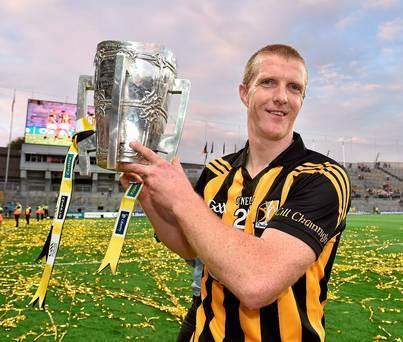


















You are welcome to the Lyreacrompane and District Journal Number 11. As we go to press the world is in its usual turmoil, in Ireland there is an uprising against water charges and austerity and while we keep an eye on all that, the general Lyre district, in 2014, enjoyed the best weather for many years. The turf and the silage came easy and our community activities continued apace.
The Journal account is in the black at the moment so we have been able to produce this issue without seeking advertising support from local people and companies but we do know you would have been supportive if needed. My thanks to Kay O’Leary for all her work on so many aspects of getting this issue ready, Billy O’Connell, the History section of Tralee Library, the National Archives, Tom Lyons, Tony Maher, Jer Kennelly and to all who contributed articles and photos. Planning for the next Journal starts now so this is a good time to check the attic for old photos relevant to Lyreacrompane and taking up the pen to finally write that old article you have always been meaning to do. We look forward to your contributions.
But back to this issue for a moment. We continue to research the story of the landlords of Lyreacrompane and in this issue we shine further light on the career of Lucy Anne Thompson, the agent of the Hurlys’, the Landlords of Lyreacrompane. We finally have an image of the notorious Miss Thompson thanks to Kay Caball who was good enough to pass it on to us.

We hope you enjoy this edition of the Journal and that Lyreacrompane continues to be a vibrant and outgoing place where life is a good story to be recorded in future editions.
Joe HarringtonPlans for New Road from Tralee to Abbeyfeale 1841. These documents show that the ‘Lighthouse Road’ from Castleisland to the Six Crosses was built beforetheTraleetoAbbeyfealeroad, alsoknownastheMountainRoad, whichintersectsitat RenagownCross. Thetotalcostoftheroad, whichwasbuiltintheearly1840s, was£7,284and the22footarchbridgeovertheSmearlaghonthe Dromadda/Renagownboundarycost£125.



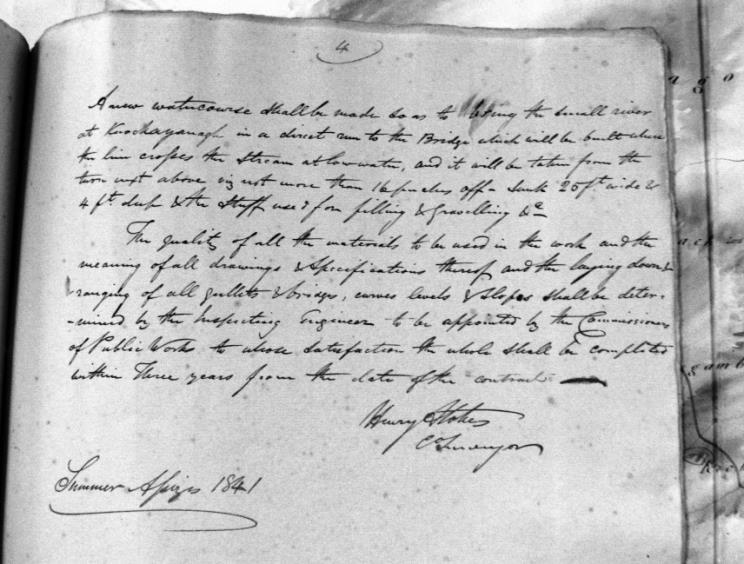
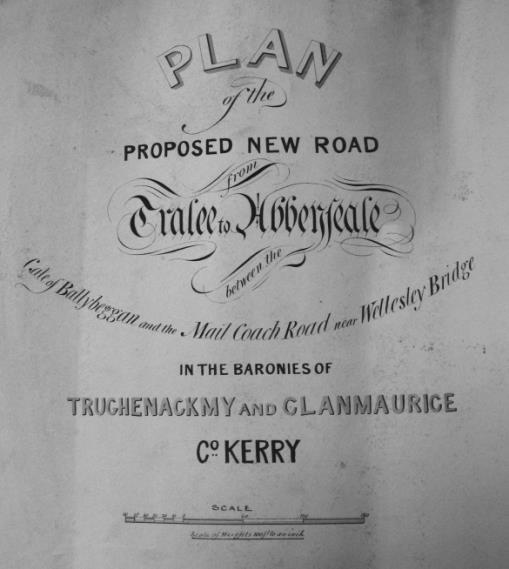
These lines from the popular song written by Ted Leizeynesk and sang by Noel Hartnettsetthesceneforthe following article…

As I walk the streets of London That spot of great renown My thoughts are back in Ireland In the days when I was young Through the dusty roads of Kerry Midst the furze and heather brown
To that happy home I left there Near the Cross of Renagown My early childhood memories Come flooding to my brain The winter days in Connie’s Forge
Where we sheltered from the rain
The fine old men we met there I remember them one and all At night we danced the polka Set In DanPaddyAndy’sHall
When my brother Con (better known as Connie) purchased some land from the late Jerry P Moloney in 1945 he returned to live in his native West Dromaddamore where we all had grown up. With his wife Hannah (nee O`Mahoney) they built a new house there and settled in with their young family. Previous to getting married Connie had served for a time in the Irish Army at the Curragh Camp in County Kildare and after Hannah and himself were married they had lived in a few different places through the country before coming back to Dromaddamore.
During his teenage years Connie had been an apprentice blacksmith and learned the trade and skills from one of Knocknagoshel`s most colourful and widely known characters of the time, thelateJackMurphywhowas better known as ‘Coffey’ in the village and surrounding areas. Coffey‘s widowed mother was known by her maiden name, Katie Hickey, which of course is unusual in Kerry. Her husband had died several years before any of us remember. Katie was a kind and very generous person. Many were the Saturday afternoons when Ando and myself would visit the forge when Connie was working there, first as an apprentice and later as what was then known as a Journeyman that is after finishing an apprenticeship. Coffey would send us to the house and his mother would provide us with a lovely tasty dinner of home cured bacon, potatoes and dressed cabbage. Katie had lost her other son Dan when he was shot by Free State forces during the Civil War around the time of the Knocknagoshel and Bally seedy mines. Neither Jack nor Katie hardly ever mentioned that turbulent period in lrish history though indeed like many families on both side of the divide they had plenty reason to rememberit.
A couple of years after Con andhiswife Hannahand their family had settled in Dromadda he built a stone walled forge and equipped it with all the most up to date blacksmiths tools at the time. Many years previously he had built a forge inKielduff but he found it was not a great place for business so he closed it down. He also rented a forge for a time in Oakpark on the outskirts of Tralee. As soon
as he had the forge built and opened, it started to thrive as he was the only blacksmith operating between Abbey feale and Tralee along that particular stretch of road. Jack Murphy`s and Charlie Begley`s forges in Knockna goshel village both phased out in due course and later Canty`s forge in Lyrea crompane also closed down. This meant that Con had a huge volume of work each day with horses waiting to be shod not alone from the surrounding townlands but from as far away as the County Limerick border and Traleeparish,
In time the forge became a meeting point for the people of the townland and something of a social centre. While Connie was busy preparing the horse shoes and performing other tasks usual to a blacksmith, conversation, debates and often indeed some heated discussions took place amid the ringing of the anvil and the blowing of the bellows. While there was no limit to the topics discussed around the flaming coal fire these usually ranged from politics to football as well as matchmaking and the priceof livestock and indeed many other subjects of both local andnationalinterest.
Regular visitors to the forge each weekday were the late Dan Paddy Andy O’Sullivan who lived beyond the parish border in Renagown, Jerry P. Moloney who lived down the Lyre Road in the far western end of Dromaddamore and Andrew Nolan who was better known to us as Bob Lynch and who lived a few fields away to the south side of the forge.
All these three men were somewhat characters in their own right. Dan Paddy Andy
Pat Brosnanhas of course since those daysbecomefamousafterhis death in the sixties and a memorial to his memory has been erected and rightly so because Dan was a man before his time and surely unique. Apart from the writings of John B. Keane who came to know Dan well during his visits to Sheehys of Renagown much of what has been written, spoken and dispensed as knowledge about the life and times of Dan Paddy Andy is based on hearsay, myth and legend and this kind of second hand or even third hand stories about the man himself has very little to do with realities and in fact does less than justicetomemory.
There is no more knowledgeable person in Kerry or indeed anywhere else to the real Dan Paddy Andy than my nephew Con’s son, Neilie Brosnan, who has been living in Kilcummin parish having married a local girl, Maura McCarthy, there. Neilie’s stories, all factual, are based on his observations of Dan Paddy’s visits to the forge each day for several years. Maybe on some other occasion it might be possible to recount some of those episodes from the life of Dan Paddy Andy. What we do know from his visits to the forge is that he often tried to canvass the consent of some of the local bachelors to try and find wives for them through his expertise in the matchmakingprocess.
Jerry P. Moloney or Jerry Pats as he was known locally was another great local personality. He was a Peace Commissioner during the latter years and used to be called the P.C., a title of which he felt very proud. Jerry had played his part in the Volunteers during the War of Independence and
Civil War when he was on the Republican side. In the early stages of the Second World War there was an appeal to young and old to serve the country so Jerry joined the local security force for which he got a service medal in addition to his IRA medal later.
The last of the trio who daily visited the forge was the late Andrew Nolan (Bob Lynch). His mother’s name was Han Lynch and both she and Bob were somewhat eccentric kind of people but very honest nonetheless. For the most part they kept to themselves after Hans’s husband died when Bob was very young. They were however on friendly terms with our own family as my father used always each year use our own horses or ponies to bring in the hay for them from the meadows. Bob never attended dances, football matches or any pastimes that boys and young men usually take part in. His sole outings were to Mass on Sunday mornings and a weekly trip to Castleisland to bring home his provisions on his donkey car. He seldom visited neighbours houses though when we moved to Dromaddabeg in 1948 he used regularly visit us after Sunday mass and sometimes my father used to give him a haircut. He used also visit his Lynch family neighbours at times. When the travelling creamery came to Renagown during the late fifties Bob usedtobringhismilktherein the donkey car. For the first time in his life he was catapulted into the mid twentieth century This was long after his mother had died in the late forties. When Bob mixed with other local farmers at the creamery stop he learned many things he hadnotheardaboutbefore.
Hewasparticularly impressed with some of Dan Paddy Andy’s ultra modern sayings and witty language and often quoted from him. His vocabulary and knowledge also increased. When the trio met at the forge each day there used to be some lively exchanges and sometimes Jerry P. would leave the forge, head for Connie’s kitchen feeling a bit bored and sometimes a little disgusted if the language between Dan, Bob and some of the other visitors became over strong for his liking. He would then back his chair against the kitchen wall and sleep for a couple of hours or so while Hannah was preparing the dinner for the children before they came home from school. Jerry P. was at the time President of Smearlagh Rangers Football Club, a position of which he was also very proud. There were of course many other local visitors to the forge on their way home from the travelling creamery each day and also those who brought their horses there to be shod as well as other jobs to be done.
When some of us left in 1957 to take up employment in England, business at the forge was at its height. However, after returning to Ireland ten years later, blacksmith’s forges all over the country were starting to go into decline as the horses were being phased out and tractors were being introduced to do the work in the bogs and farms. For a time Connie’s sons Neilie and John and himself were engaged in making car trailers in the forge but the lads soon abandoned this when they left to take up more lucrative employment. However, they continued to do part time jobs in the forge and we ourselves have
railingsontop ofourroadside wall, whichweremadethere.
Sadly Connie’s wife Hannah died in 1975 at a comparatively young age R.l.P. Several years later he remarried, this time to the former Eileen Cronin of Dromaddabeg. Eileen, after spending several years in the United States had returned home and after acquiring a site from Connie had a new house built there. Following Connie’s death however, in 1998, Eileen sold the house andreturnedtoAmerica.

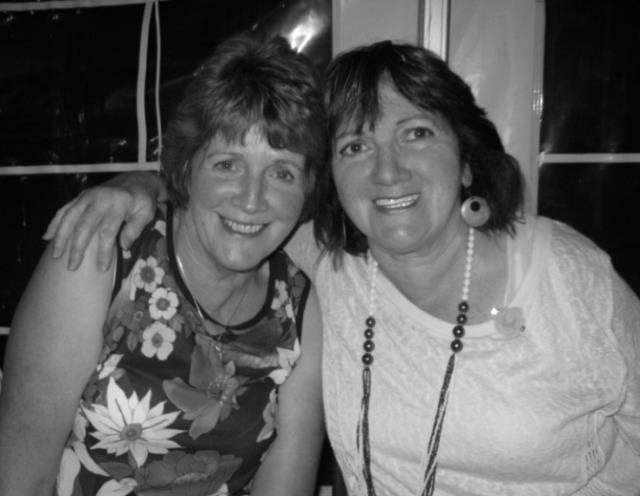

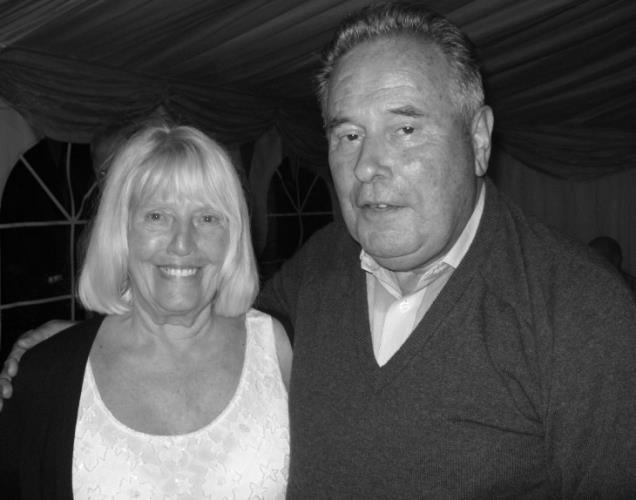
And so the saga of my brother Con’s forge nestling in the valley alongside the road and sheltered by the majestic hills of Dromadda
more in the Glenaruddery Mountain range still stand there, a silent reminder of times past, some good and others not so good, some happy times and others sad. Activitiesandromanceof that forge which spanned several years of the last century are now only memories for those of us who lived through that interestingperiodofourlives. Like many other rural areas in our country the townland of Dromadda has, in the words of Yeats, “all changed; changed utterly”. The green fields, the meadows and the pasturelands of our schooldays and much of the brown bog where we often worked and sweated in the warm summer days of our youth as well as the grounds
where we used to play football in the evening twilights of long ago have all transformed into dense forestry. Whether one can call this progress or rural decline is certainly a very openquestion.
One very interesting feature of Con’s Forge is that it was built on the site of an old hedge school, the ruins of which we often noticed when passing there during our early schooldays in Rena gown. But just like the hedge schools the blacksmiths forges have now all but disappeared from the Irish landscape. In many ways we are the poorer for their passing.
John Costello and Dorothy home from the UK for the Dan Paddy Andy Festival and on the right John and Nora (nee O’Connor, Renagown) Casey. Nora and John make the trip from Harrow, London for the Dan Paddy Andy Festival every year and tell us that the year wouldn’t be the same if they missed it!. Ann Carmody, Lyreacrompane and Ann Ferguson, Tralee and on the right Mags and Julie Ahern pose for the camera with Mick Flavin at the Hooley in the Hill Festival. 5Now I cannot help remember those happy days gone by, As Christmas time approaches and the festive season’s nigh, I wallow in nostalgia when I think of long ago, And the tide that waits for no man as the years they ebb and flow, We townies scoured the countryside for the holly berried red, And stripped from tombs green ivy in the graveyard of the dead, To decorate each picture frame a hanging on the wall, And fill the house with greenery and brighten winter’s pall.
Putting up the decorations was for us a pleasant chore, And the crib down from the attic took centre stage once more, From the box atop the dresser the figures were retrieved, To be placed upon a bed of straw on that blessed Christmas Eve. For the candles, red crepe paper around the jam jars, filled with sand, To be placed in every window and provide a light so grand, To guide the Holy Family who had no room at the inn, And provide for them a beacon and a fáilte mór within.
The candles were ignited upon the stroke of seven, The youngest got the privilege to light our way to heaven, And then the rosary was said as we all got on our knees, Remembering those who’d gone before and the foreign missionaries. Ah, we’d all be scrubbed like new pins, in the bath before the fire, And dressed in our pyjamas, of tall tales we’d never tire, Of Cuchullain and Ferdia, the Fianna, Red Branch Knights, Banshees and Jack o’ the Lantern, Sam McGee and the Northern Lights,
And we’d sing the songs of Ireland, of Knockanure and Black and Tans, And the Boys of Barr na Sráide who hunted for the Wran. Mam and Dad, they warned us, as they gave each a goodnight kiss, If we didn’t go to sleep at once then Santa we would miss, And that magic Christmas morning so beloved of girls and boys. When we woke to find our dreams fulfilled and all our asked for toys, But Mam was up before us the turkey to prepare, To peel the spuds and boil the ham and supply the festal fare.
She’d accept with pride the compliments from my father and the rest, “Of all the birds I’ve cooked” she’d say “this year’s was the best” The trifle and plum pudding oh the memories never fade, And then we’d wash the whole lot down with Nash’s lemonade. St. Stephen’s Day brought Wren Boys with their loud knock on the door, To bodhran beat and music sweet they danced upon the floor, We terror stricken children fled in fear before the batch, And we screamed at our pursuers as they rattled at the latch.
Like a bicycle whose brakes have failed goes headlong down the hill, Too fast the years have disappeared, come back they never will, And our clan is scattered round the world, from home we had to part, Still we treasure precious memories forever in our heart, So God be with our parents dear, we remember you with pride, And the golden years of childhood and that happy Christmas tide.
2013 was declared the year of The Gathering in Ireland by the government. Locally The Dan Paddy Andy Festival committee decided to hold another festival in theStacksMountains ‘The Hooley in the Hills’ to mark the year. We choose the May Bank holiday weekend, Friday May 3 to Monday May 6 for the event. It was a weekend of marquee dancing to some mighty bands including the King of Irish Country music, Mick Flavin and his five piece band, Eddie Lee, Mike Condon, TR Dallas, PJ Murrihy, Eddie Keogh and Micheál Sexton. We had successfully made an application for Leader funding to North and East Kerry.
We were in the midst of preparations for the festival when I got a phone call from Lyreacrompane national school. The school was celebrating 50 years in existence in 2013 and the teaching staff wanted to mark the occasion. The present National School is the third school to be built in Lyreacrompane. Thefirst school at the Glen 1872 1911 is still standing, the second school 1911 1963, nolongerexists.
I was asked to be involved in organising the event. Having consulted the festival committee, Joe Harrington, Mary and Michael Mangan, Chris Quinn and Albert Roche, it was decided to run both events, the Hooley in the Hills festival and the
school’s 50th anniversary, in tandem. We scheduled the School celebration for Saturday May 4. Other school reunion committee members were Kieran Quirke NT, Marie Nolan, Pat Carmody, Breda Keane and MichaelMangan.
Joe Harrington, festival chairperson and Fr. Brian Starken had attended Lyre schooltogethersoJoemade contact with Fr. Brian and he readily agreed to return to Lyre for theoccasion and to celebrate the mass. I designed some posters and wrote a letter of Invitation for the school event which Kieran printed. Michael Mangan and I were on the road for a couple of days callingtoeveryhouseholdin Lyreacrompane with an invite. Old school registers were scrutinised, addresses were sought, as it was essential that contact was madewithallformerpupils.
I then sourced photographs of former Lyre school pupils who returned to teach in theiroldschool. Igot great help on this from Billy Connell,Lyre,wholocateda photo of Francis Ahern. Mary Lynch, Tralee, gave me a photo of her mom, Mrs. Sheehy and Mary Majella O’Connor, Drom clough NS,searchedfarand wide to get a photo of her relative John O’Connor.
All advertising for the Hooley in the Hills festival carried details about the school reunion and this also helped in getting the word out.
Parkingfortheeventwasat the Lyreacrompane Community Centre and The Irish Rambling House
sponsored a coach to ferry people between the center andtheschool. Afewhardy souls decided to relive their memories of walking to school by making the journey on foot. Over 300 people attended. The old roll books were on display and they were enthusiast ically examined and the large display of old school photos were the center of many debates on the identityofthosepictured.
The weather was kind to us on the day, cold but dry. The mass was celebrated out of doors by Fr. Brian andhewasjoinedbyFr.Pat Moore and Fr. Tim Grant and Fr. Tom McMahon. Fr. Moore had brought along the ‘Duagh Ciborium’ forthe celebrationofthemass.The altarclothusedonthedayI hadboughtin Medjugorjein 2007 having been on the first pilgrimage from the Duagh Lyreacrompane Parish which Fr. Moore had organised. My Daughter, Eirn Lyons, sponsored the altarflowers.
The young school children and their teachers were involved with readings, gifts and music during the mass. Following the mass all adjourned to the Community Centre where refreshments were served. The chat was mighty as former pupils met each other, many for the first time since leaving school. Photos of the event along with a page ‘Memories of our school days’ were on lyreacrompane.com Fr. Brian was delighted to be back in Lyreacrompane and was glad of the opportunity to catch up with former classmates and neighbours. He stayed with us in the 7
Glen that night and met with Mick Flavin and his bandwhowerewithusfora meal andachat beforethey went on stage in the Marquee.


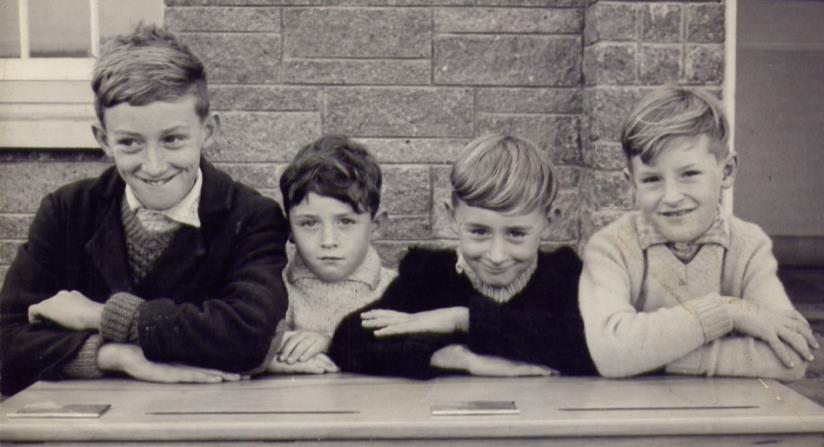
Congratulations to everyone involved. Two Festivalsand a major School Reunion in one year! What a great achievement for a small ruralcommunity?
50th Celebration Sponsors included: Lyreacrompane
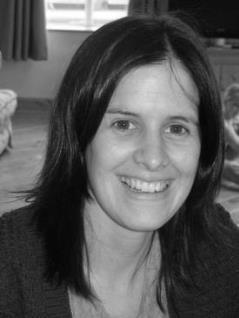

Development Company Ltd, Buy Low Tralee, Mr. Price Tralee, Carmel’s Discount Store Tralee, Tom Moloney Cash & Carry Centre Listowel, John Hennessy Tennis Coach, Billy Kissane Meats Listowel, Johnny Nolan Lyre PO, Centra Castleisland, Garveys Castleisland & Listowel, O’Mahony’s Bakery Tralee, Áine’s Café Tralee, JJ Sheehy Graphic Designer,

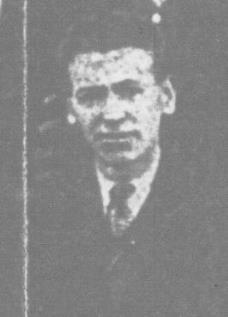
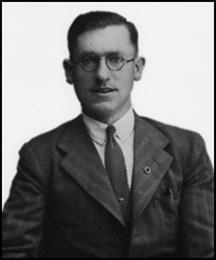
Listowel Arms Hotel, Meadowlands Hotel Tralee, Woodlands Hotel Adare, Spar Listowel, Eurosaver Abbeyfeale, Glenduff House Kielduff, Martin Leane Glass & Glazing Lyre, Dunnes Store Tralee, Twohigs Abbeyfeale, Tesco Abbey feale, Michael Lyons Plumbing Tralee, Crecora Mills, All who did home baking and the Staff & VolunteersofLyreCentre.
 These are past pupils of Lyreacrompane National School who returned to their old school to teach. They are Hannah Sheehy from Cloghane who began teaching in 1915, John O’Connor, Lyreacrompane, who taught in the school from 1932 to 1938, Francis Ahern, Knocknaglough who started in 1938, Mary Ann Nolan, Glountain, who taught at Lyre school in 1942 and between the years 1958 and 1981 and Elish Dillon Lyons, Cloghane, is teaching at the school since 2005.
Billy, John, Bernie and Mike McKenna and on the right; Maryanne, Helen, Dan and Jack Joyce.
Johnny, Margaret, Nial and Billy Nolan and on the right; Kay, Patricia and Adrian Naughton. 8
These are past pupils of Lyreacrompane National School who returned to their old school to teach. They are Hannah Sheehy from Cloghane who began teaching in 1915, John O’Connor, Lyreacrompane, who taught in the school from 1932 to 1938, Francis Ahern, Knocknaglough who started in 1938, Mary Ann Nolan, Glountain, who taught at Lyre school in 1942 and between the years 1958 and 1981 and Elish Dillon Lyons, Cloghane, is teaching at the school since 2005.
Billy, John, Bernie and Mike McKenna and on the right; Maryanne, Helen, Dan and Jack Joyce.
Johnny, Margaret, Nial and Billy Nolan and on the right; Kay, Patricia and Adrian Naughton. 8
FrBrianStarkenandFr TomMcMahonduringthe ReunionMassandontherightistheReunion Organising Committee; Michael Mangan, Kay O’Leary, Marie Nolan, Breda Keane, KieranQuirke andinsetPatCarmodywithschoolpupilsKatieMurphyand YvonneMurphy.



Last week I picked up a copy of the Lyreacrompane and District Journal not sure what to talk about today I was looking for an idea to get me kick started. I landed on an article by the eminent present Parish Priest of Duagh, Fr. Pat Moore. He was writing about Sr. Eileen Enright and the great work she does in education in a marginalised community in Sacramento and how Eileen drawssomuchfrom herearly education in Lyreacrompane National School. I was actually in school here in Lyre at the same time as Eileen in the 1950s. Now, having spent most of my working life in Africa, much of it working in education and in very rural communities, I quickly realised how much my early years here in Lyre helped me toadapttorurallifeinAfrica
Growing up in Lyre gave me what Seamus Heaney would call ‘a sense of place’. To develop that sense of place,
anywhere in the world you need it in Africa as much as in Ireland you have to walk the roads, cross the fields, climb the hills, fish the river, touch the stones, pick the wild flowers, spend time with people and appreciate your community. You need to have that feeling of belonging in a community and investing yourselfinthatcommunity.
There were focal points in the community the shop, the creamery, the church, the pub, the school, the football field and, of course the bog that gave a lot of employment in the area. People visited each other’s houses to play music, tell stories, discuss the fortunes of Kerry football, and play cards. For kids growing up here at that time the school was where it all happened. It was where we began our education, playedgames, and took our first steps towards being a person in a community. Primary school was where the values we learned in the home were reinforced, put to the test and practiced. We all learned
the importance of honesty, integrity, respect, loyalty, and of reaching out to those in difficulty. Love of neighbour. Christian values were integrated into our education because they were important human values as well and made us better people.
There was littletalk of second levelorthirdleveleducation it was still a dream for many in the 1950s. Some did go on to further education. I remember my first day in UCD in the late 60s. I went into one of the old lecture halls and sat down at a bench. Students over the years had carved their names on many of the benches and there in front of me someone (who shall remain nameless) had carved the words ‘Up Lyreacrompane’. Whoever it was left their mark in UCD! I pointed it out to the student sitting next to me who said ‘where is that? I was proud that not only did I know where it was but that I had gonetoschooltheremyself. I was here in this school in the 1950s life was much
simpler then than it is now something else that prepared me very well for life in Africa. There was very little transport, communications were not great, though we had a radio with wet and dry batteries, the use of which was very carefully measured, rural electrification hadn’t reached Lyre yet, and luxuries were few and far between. We didn’t have the best of everything but we learned to make the best of everything and that was
what made life so precious hereinthosedays.
My family lived here for 18 years from 1940 1958. They were the peak years of turf cutting in Lyreacrom pane. Turf from Lyre brought warmth and light to many a household aroundIreland and many a hearth was kept burning. Over the years people left this community and took up residence in other communities around Ireland and in far away
places. They brought with them something of Lyreacrompane something of that sense of community, the values and the warmth of thisplace.
I remember my family being very sad when Bord na Mona decided to close the plant here in Lyre and we returned to live in Offaly. But our memories of Lyreacrompane and its people are still warm.

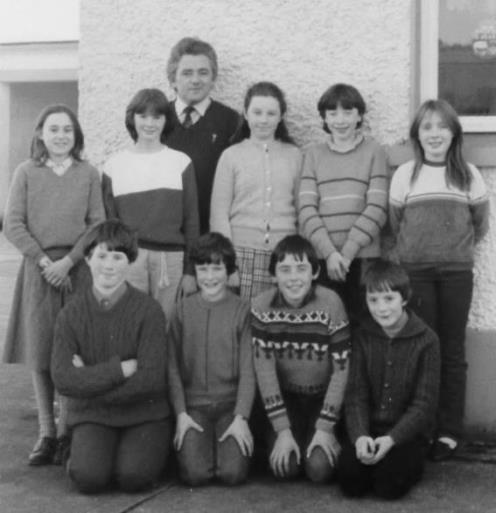
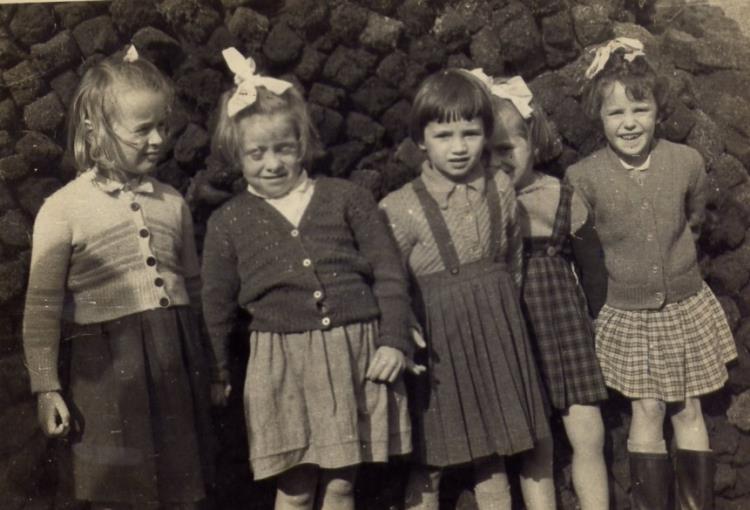
How many of these do you remember? Rin Tin Tin, Daihi Lacha, Going My Way, Sargent Bilko, Arrest and Trial, Disneyland, The School Around the Corner, Father Knows Best, The Joe Linnane Show, O’Dea’s your Man, Leave it to Beaver, Mr Ed, Stoney Burke, The Thin Man, On the Land, Jack Benny, Temple Houston, The Farmer’s Daughter, Air Power, Bat Masterson, Take My Word, Combat, Peter Gunn, The Donna Reed Show, Home for Tea, Tolka Row and Jackpot. Looking back the programmes on offer were no worse than those on view today and in some cases a good deal better.
 Mary Nolan, Maureen Carmody, Marie Carey, Helen Joyce and Nora Dillon. Right; Caroline O’Callaghan, Breda Quille, Patricia Quinn, Norma Fitzgerald, Joanne O’Connell. Front; Tagdh Murphy, PJ Meehan, DJ Murphy and Albert Roche. Teacher John Kirby.
Mrs Sheehy NT and her daughter Mary and on the right Mary Nolan (Kelly), Lyreacrompane Programmes on Telefis Eireann
Mary Nolan, Maureen Carmody, Marie Carey, Helen Joyce and Nora Dillon. Right; Caroline O’Callaghan, Breda Quille, Patricia Quinn, Norma Fitzgerald, Joanne O’Connell. Front; Tagdh Murphy, PJ Meehan, DJ Murphy and Albert Roche. Teacher John Kirby.
Mrs Sheehy NT and her daughter Mary and on the right Mary Nolan (Kelly), Lyreacrompane Programmes on Telefis Eireann
I stumbled across a box of old schoolbooks recently mid 1960’s for the most part. I picked out a composition copy, the Standard Exercise Book by Browne and Nolan Ltd, and it was my brother’s (who must remain nameless). I started to leaf through what today they call essays. I suppose that given the geographical location the Listowel Races was bound to turn up and appropriately it came first. Theessaypaints a perfect picture of a perfect festival in a perfect town an accurateenoughdescription.
The history and benefits of cycling are rolled out in the next offering. For townies there was a detailed account of how to cut turf (with no prophecy of dictats from Europe on the matter or of Jimmy Deenihan who may well have been writing a similar essay at the next school desk). The essay on newspapers asks the question; “Is it any wonder that governments fear newspapers and seek their support?” Nothing much has changedovertheyears.
An essay on Ireland one hundred years hence promised extraordinary things such as small houses on the basis that the bigger the house the bigger the rates payable. That was before Fianna Fail did away with rates and hit us with a couple of other taxes instead! Insulation and central heating, rare then, would become common place and fire extinguishers would be in every house. The essay predicted correctly that a special mobile force would be set up to deal with traffic regulations and that railways, apart from the main lines, would disappear. There might be emigration to
habitable planets by 2065. Our native language will be more widely spoken. Far seeingindeed!
In an essay on The Fair Day the writer claimed that; “Some people are agitating fortheabolition ofstreetfairs and the establishment of field fairs”. This, it was claimed, was not going down well with the business people of the town. Thatessaywasfinished off with a mention of some famous fairs such as the Old Lamas Fair and the Donnybrook Fair and some outside Ireland of which I had never heard. So what did I do? I put down the copy and consultedGoogleofcourse.
Wikipedia told me that the Leipzig fairs go back to the Middle Ages and were first mentioned in 1165. In 1190 Otto the Rich of Saxony instigated two trade fairs in Leipzig, at Easter and Michaelmas. No other fair was to be held within a mile and the bridges and streets were freed from toll. Trade goods included herring, cloth, wine, and pepper. The Sonepur Cattle Fair is held in the month of November in Sonepur, Bihar, India and it attracts visitors from all over Asia. It is the biggest cattle fair of Asia and can go on from fifteen days to one month. It has its origins in ancient times. Makaryev Fair was a fair in Russia held annually in July on the banks of the Volga from the mid 16th century to 1816. Following a massive fire in 1816, it was movedto Nizhny Novgorod. It attracted merchants from India, Iran, and Central Asia. The fair ceasedin1929.
Famous fairs indeed but for local farmers and the business people of Listowel they couldn’t hold a candle to the local Fair Day. An essay on Road Safety
followed, pointing out that 335 were killed on Irish roads in 1963 and 4422 were injured. It went on to detail the Road Safety Fortnight launched in the Mansion House on December 4, 1964. “From there a procession led by the Garda Band marched through the city to the Pro Cathedral where mass was celebrated by Fr Kennedy, President of the Safety First Association. In Cork, where the Mayor opened the campaign, drivers queued up to sign a declaration pledging them selves to road safety…. In Waterford certificates were presented to accident free CIE drivers. At other centres vehicles were blessed by the local clergy. The Motor Traders Association operated a scheme for testing road worthiness free of charge. Illustrated leaflets were distributed in schools and Radio Eireann and Telifis Eireann gave the campaign the widest possible publicity”. The safety fortnight described in the essay was intensive and obviously well meant but statistics show that road fatalities continued to rise at more or less the same steady rate. In 1963 335 died on theroads, 1964 341, 1965 356, 1966 382, 1967 416, 1968 447, 1969 462, 1970 540, 1971 576 up to the highest figure ever for road deaths in Ireland in 1972 when640peoplewerekilled.
The next quotation from the essay of 1965 will explain my determination to protect the name of the writer from Lyreacrompane. It reads; “Vehicles should be tested quarterly, at the owners expense, to ensure that the lights, brakes and steering are functioning efficiently.”
And I often wondered where the idea for the NCT came from!!! Now I know that it came from very close to homeindeed!
Work on the new National School was progressing satisfactorily and should be ready by June. The contractors were Broderick Bros, Duagh.
John Carey and Michael Molyneaux were elected vice presidents of the Limerick Kerrymen’s Association. Other Lyre people present were Joe Quille and Michael Carey. William McKenna (Junior), Knockaunbrack went to Galway to train as an agricultural Instructor. Congrats were extended to Denis Sheehy, originally from Renagown on joining the Salford police in Lancashire where his parents Mr and Mrs MichaelSheehyresided.
‘Humble Master’ belonging to Mrs Hannah O’Donoghue won the Wheat Sheaf Cup and Stake in Dingle. This was the dog’s third success of the season which included the Irish Purse worth £150.
‘Humble Master’ is by the great ‘Social Master’ which previously won the Derby at Clonmel for his owner JJ KennellyofGortaclahane.
Back in Lyre after an enjoyable holiday in England was Mrs Nora Kelliher of Spur. Her daughter, Kitty Salmon and grandchild Mary had accompanied her home. Miss Phil Naughton, Glashnacree, also came home on a holiday from England while Billy Buckley, Knockaclare and Bernie O’Connell, Glashnanoon were back in the district after a spell in the English Beet Campaign.
Others to visit home during 1964 included John Shanahan, Glashnanoon, Frank Ahern, Knockaunbrack
and Dan Hickey, Bromadera. Mrs Joan O’Donoghue, Knockaclare SRN also holidayed at home in Lyre. Patrick Sommers returned to England and Betty, his sister, went with him.
Mrs Kitty Salmon returned to England and she was accompanied by Bridie Naughton, Spur. Pat Quille and Rosaleen Fitzgerald of Knocknaglough were among recent emigrants to England. John Keane, with his wife and son, returned to England after holidaying at his home inGlashnacree.
The Kerry County Camogie Board held a dance at the Six Crosses Hall and at Headley’s Bridge the popular Troubadours provided music “a la carte”! Four Lyre lads, Patsy Canty, Joe Doran, Jimmy Roche and Teddy Sweeney entered a singing competition in Duagh and won the first prize. In Knockalougha a mare, the property of James Nash gave birth to twin foals on St Stephen’s day!
The marriage took place in England of Billy Keane, Glashnacree and Mary Moly neaux, daughter of Jack and MaryMolyneaux, Mountcoal.
The Lyre Fianna Fail Cumann gave Senator John Costello from Ballyduff an enthusiastic welcome when he addressed their AGM. Other speakers included Tommy Mc TD, Cllr Michael Long and John Reidy from Castleisland. Officers elected for 1964 were Chairman Paul Leen Carrig cannon, Vice Chair Patrick Ahern Knocknaglough, Secretary Charlie Molyneaux Glashnanoon, Jerry Long Lyre and Christy Quille Clahane were treasurers. The delegates to the Comhairle Ceanntair were Charlie MolyneauxandDanCanty.
Those to pass away were Mrs Kate Sheehy (nee Shanhan), Muingwee, Mrs Annie Nolan, Glountain who was survived by her sons Moss (the Postman), Paul, John, Joe and Denis. Thomas Howard from Bromaddera died and wasburiedinFinuge.
1964 also saw the passing of Lyreacrompane’s Post Master, Bill Nolan. Heartfelt sympathy was extended to Mr and Mrs Denis Nolan, Glashnacree on the unexpecteddeathoftheirfive year old son, Denis. In Glashnanoon Michael Shana hanwasmourned.
As an example of the dreadfully severe weather experienced in Ireland during the recent storm it is stated that at Castleisland snow in the mountains renders travelling impossible and the ground is so hard that graves cannot be dug and bodies remain unburied. The South and West Kerry Railway was blocked with snow and in the town of Killarney business wascompletely suspended.
The death of Mrs Agnes Stack, Postmistress, Duagh took place at her residence, thePostOffice, inFebruary9, 1914. She was the mother of six children, three of whom arestillalive. Thefuneralwas one of the largest seen in the village and sympathy was extended to her mother, Mrs O’Connor, to her husband Thomas Stack and to her little children Michael Patrick, Bartholomew and John Patrick.




 GroupfromNenaghandTerryglassCoTipperaryonDanPaddyAndy2014 BogWalk
EoinHand, who openedthe2014DanPaddyAndyFestivalwithJoeandMikeandontheright JoeandEllieAnnEnrightcelebratingtheir40th weddinganniversary.
Shane Harrington played a tune at the 2014 Festival and on the right Declan Nerney who played in the Festival Marquee in 2012 pictured with the Festival Committee
GroupfromNenaghandTerryglassCoTipperaryonDanPaddyAndy2014 BogWalk
EoinHand, who openedthe2014DanPaddyAndyFestivalwithJoeandMikeandontheright JoeandEllieAnnEnrightcelebratingtheir40th weddinganniversary.
Shane Harrington played a tune at the 2014 Festival and on the right Declan Nerney who played in the Festival Marquee in 2012 pictured with the Festival Committee
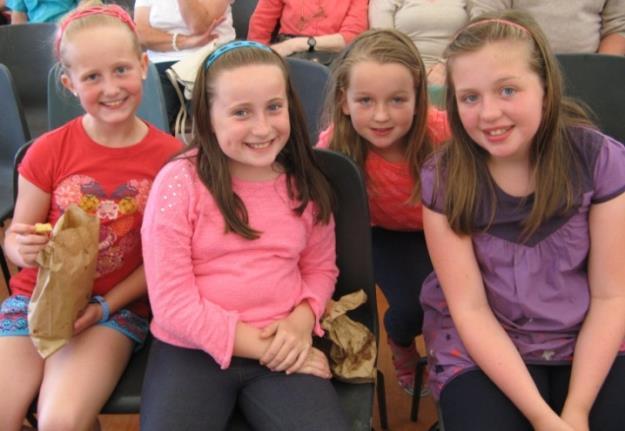
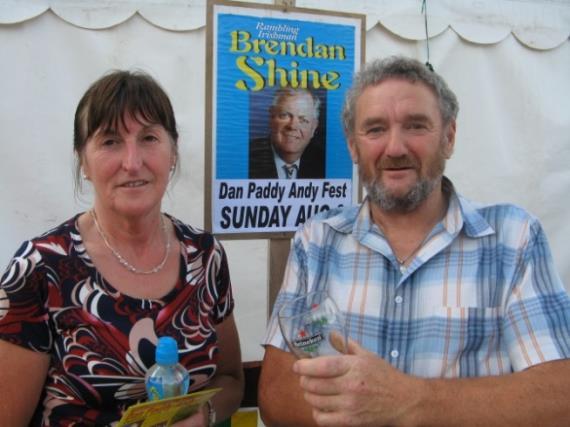

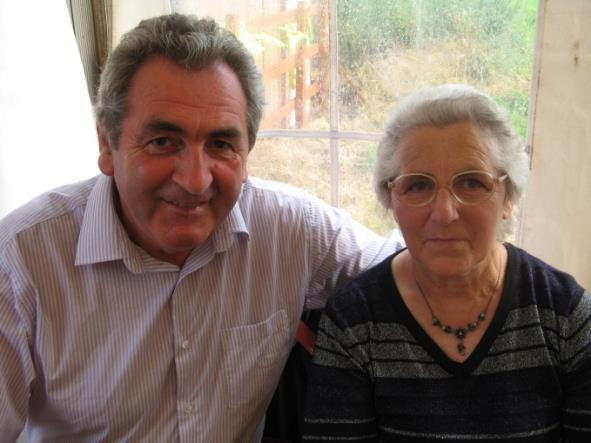
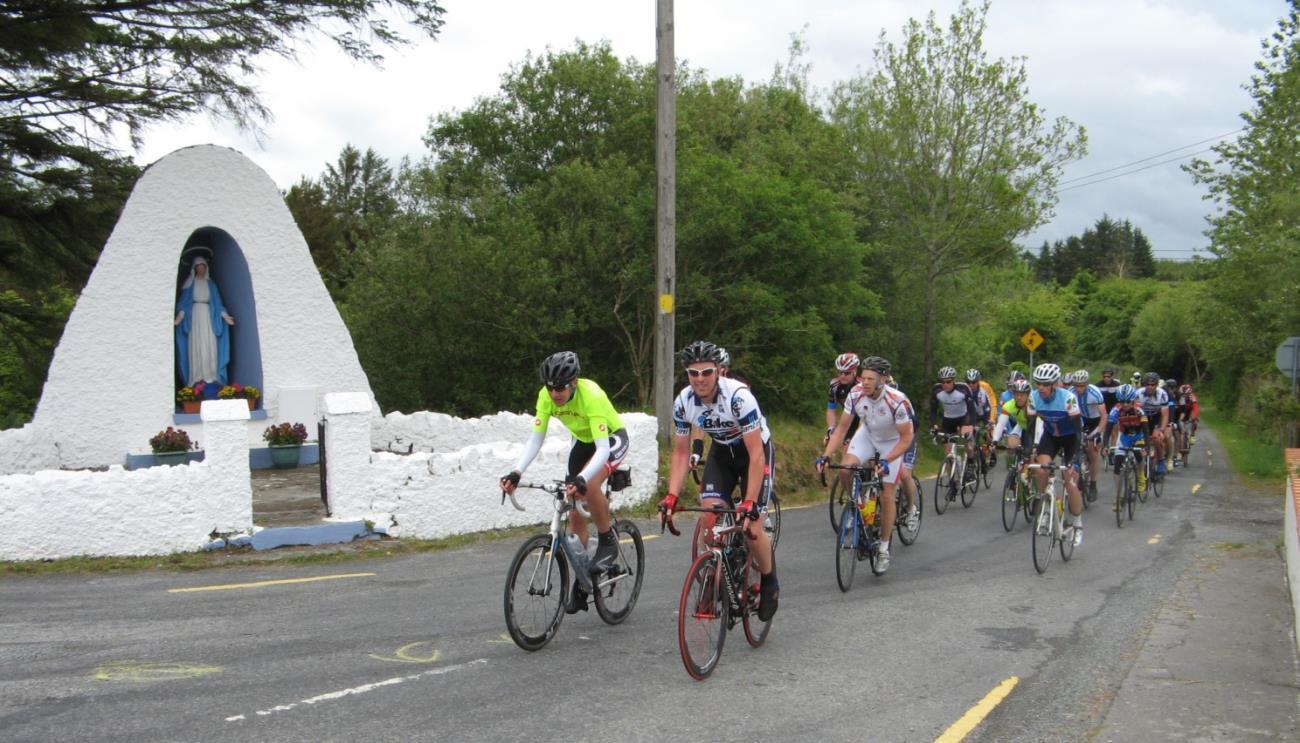 CaoimheLyonsLawless, SineadBehanandSarah andAoifeMurphy andontheright;Nuala (O'Leary, Muingnaminnane)andDonieO'Doherty, Killarney.
JaneBehan, RatheaandMaureenHarris, Maugha and on the right John O’Connell, Tralee and Criss QuinnLyreacrompane
Out for a spin through Lyreacrompane in the summer of 2014
CaoimheLyonsLawless, SineadBehanandSarah andAoifeMurphy andontheright;Nuala (O'Leary, Muingnaminnane)andDonieO'Doherty, Killarney.
JaneBehan, RatheaandMaureenHarris, Maugha and on the right John O’Connell, Tralee and Criss QuinnLyreacrompane
Out for a spin through Lyreacrompane in the summer of 2014
The thing I remember most about Bill Clinton’s visit to Limerick in 1998 was the amount offreeadviceIgot. “Don’t meet that representative of American imperialism” “Do meetthe leader of the free world” Tell him this…” “Tell him that…” “Don’t say anything to offend him” “Do tell him straight” “Wear the Mayoral robes” “Don’t wear the robes”. There was no shortage of opinions!
No one seemed to know why Bill was coming across the broad Atlantic to Limerick and I don’t think it ever became clear. Perhaps it wasanexcuseforagame of golf in Ballybunion with DickSpringortoexperience the lap of luxury at Adare Manor. It certainly wasn’t forthespeechhemadethat day which was up to his usual smooth and engaging standardbut didnotcontain any dramatic announce ments on the Peace Process or on anything else well as far as I was concerned but then my mind was elsewhere anyway. When it was mooted in the City Council that he should be given the Freedom of the City during his relatively fleeting stop over on his way to Kerry I wasn’t too enamoured. I had and still have major issues with American foreign policy under which they intervene, mostly disastrously, (Iraq Vietnam, etc.) in affairs outside their own boundaries to protect their “national interests”. Some of the most brutal dictators worldwide are sometimes
friendly to American interests so they are left alone on the basis that “They may be dictators but theyareourdictators”. Still, all the City Councillors wanted to give Bill ‘the Freedom’ and argued that their constituents would expect them to do so. As the decision had to be unanimous I suppose I felt that I couldn’t be the party pooper and so the Council agreed that their people would speak to his people and make sure he would stand still long enough in the Treaty City to be presented with the honour. All was agreed and preparationsbegan.
At my end it seemed to have been determined somehow that thequestions were; what would I, as Mayor of Limerick, say to Bill and what should I wear whiledoingso! Theissueof the ceremonial robes had beengettinganairinginthe proceeding few years. A couple of us had refused to don the jersey. The robes were a throwback to the time of British rule. They seemed to represent some level of pomp and were prized by members of Fianna Fail, and Fine Gael –which was reason enough anyway forthemoreradical newcomersto the council to kick the traces on the matter.
Thehotissueinthecitywas should I wear the robes or not. It was regularly debated on the local radio and press and a survey carried out by one of the pirate stations showed that the citizenry were against the robes. Organisations like the Chamber of Commerce felt it important
enoughtotakeapositionon the controversy. Theywere definitely for the robes. The coming of Bill nearly got forgotten in the debate! Even on the morning of the visit a special meeting of theCouncil heldin theBank BuildingoutsideofwhichBill was to address the multitude had, as its main item on the agenda, a last ditch effort by the big parties to get me to wear therobes. Ilostitabitthat morning with those councillors. There I was trying to get psyched up to face the crowd and the cameras of the world and they were bothering me about the bloody robes! This was after they had earlier reluctantly agreed to a suggestion coming from Kay that I should wear an Irish made suit. So I eventuallytoggedoutinone from Tony Connolly’s Menswear shop in Patrick Street.
The only other thing I wasn’t happy about in this regardwasthedecisionthat I should wear the big Mayoral chain a big awkward item that was probably OK with the robes but looked like the shackles of a slave over the suit – if that makes sense. I would have preferred chain numbertwo which wasalot tidier but Bill was comingto town and the biggest and brashest silverware had to be on show for the occasion.
Apart from all that, the speech I was to deliver when presenting the Freedom of the City to Bill was the main issue. There was much trepidation in Council circles about its content when they heard I 15
What Bill said to Joe… (Aslightly humoroustake) JoeHarrington
wasgoingtowriteitmyself. Generally the Manager or a member of City Hall management was delegated to draft speeches for major occasions and the Mayor or the Chair of the Council would deliver them with feeling. Leaving such matters to Councillors was chancy and, anyway, Councillors, for the most part, were happy for the help.
Con Murray, second in command at the City Hall, was given the task of keeping some sort of rein on me. I could nearly hear the whispers ofalarm. “That radical is liable to say anything”. He’s a loose cannon for sure”. “Of all the times for him to be Mayor”. Yes, there was much wringing of hands. Con workedwithmeonmydraft and tried to get me to tweak it here and there. Mention of Cuba would be a bit impolite he felt. To be fair I must admit that Con was fair but I think he sweated blood. I had my speech and after a stint as Manager of Waterford Council Con survived to eventually become the manager of the recently amalgamated Limerick City andCountyCouncil.
The great day arrived and after the Council meeting in the Bank Building in O’Connell St. it was time to go public. The platform outside was fronted with bullet proof glass! Do you know that the more bulletproof a situation is made the less secure you feel. If it has to be this secure there has to be real danger. I was sure no assassin was out to get me but could I be caught in the
cross fire if they went after Bill? Ilookedupat theroof tops. The Special Service men were up there. They were certainly not down in the manholes because all the covers had been welded to prevent some Taliban or other taking a pot shot at Bill.
Bill and Hillary arrived on stage with Bertie. There was somelovely Irish music and then to the speeches. When it came to my turn I said my piece and I remember I didn’t rush it. To lighten the atmosphere and to give a nod to the Native American Indians who were there long before the white invasion nearly wiped themout Ithrew in a little mention of a Harrington who went missing from General Custer’s brigade just before hostilitiesbrokeoutwiththe Sioux at the battle of the Little Bighorn. Sitting Bull andCrazyHorsehadagood day in defence of their people on that occasion and it’s no harm to remind modern America of its dodgy past. Having welcomed Bill to Limerick I mentioned a couple of issues I had, as I said earlier, with US foreign policy. Isuggestedthatthe American economic blockadeshouldbeendedin fairness to the good people of Cuba. In a polite but straightforwardwayIletBill and his administration know that what they were doing to a small countrylike Cuba was not going unnoticed aroundthe world.Isuppose they knew that already but it was no harm to remind them. Amazingly, the sky didn’t fall in. I have always heldthatleaderslikeClinton who madetheirnameinthe
rough and tumble of what they call political do not value the molly coddling theygetontheseoccasions. On a personal level they might even appreciate a bit of honesty in the way people deal and speak to them.
AsthespeecheswentonBill leaned over to me and assured me that he was working on the question of the US blockade of Cuba and he washopeful it would work out! (The other stuff he told me is under a thirty yearembargobecauseofits sensitivity you will under stand. You might read it first in a future Lyre Journal!)
I presented the Freedom of the City to Bill Clinton. The scroll was in what looked suspiciously like a small coffin but I had nothing to do with that! But seriously the serious one on that day wasHillary. WhileBill came across as ‘one of the lads’ Hillary was more distant. I got the impression that Bill and herself weren’t very lovie doviethatday. AfterI presented her with a lovely Dresden Doll made in Dromcollogher in County Limerick she headed for Clare while he took the coast road to Kerry. But then maybe she didn’t like golf and maybe he didn’t like Clare. I didn’t get invited to either and had to makedowithhavingameal with all those left behind. I ended up sitting beside Bertie and I have to say about the man and fair play to him he didn’t bore me withstoriesaboutPaddythe Plastered but I was a bit disappointed that he didn’t see me as someone he couldaskforadigout!!!
When Micheal O Muircheart aigh came to Lyreacrompane to unveil the bust of Dan Paddy Andy O’Sullivan some years ago the one thing that struckhimwasthenumber of older people who responded in Irish to his ‘As Gaelige’ salutations. He would not have expected this area to be strong in the Irish Language. We asked John Nolan about this as we know he is one of thosewho’s Irishisgood.
speaker and brought that to Lyre School in a big way. When John moved into Mr O’Sullivan’s class he became Seán O’Nualláin and while there must have been an English class John can only remember that everything was taught through the medium of Irish. John fell in love with the language and even to this day does all calculations and sums in Irish. Listening to the news in Irish is never a problem for John unless the reader is fromtheDonegalGaeltacht.
Apparently Paddy wasn’t able to play much football with the school children given his size but he did buy them a football and John still has the image in his head of the master giving it a kick as he gave it over to them. Back in those years they sometimes played football in the inch beside the Smearlagh below theschool.
the pupil who was sure he or she knew the answer was to shout it out. It worked most times. The inspectors took it to be enthusiasm and Paddy gotagoodreport.
John was finishing school as World War Two started. The image of German spies bothered even those living in Lyreacrompane. Having a strong sense of place, it seems that the people of Lyre never wondered why Hitler would want to send agents to the Stacks Mountains. Why shouldn’t he? The national policy at the time was to take down all road signs to confuse the spies! There seems to have been a belief in Lyreacrompane that the clever thing to do was to turn the signs the wrong way around and really wreck the German’s heads.
John was born in 1926 and went to Lyreacrompane National School during the ‘30s. The teachers at the time were locals Mrs Sheehy, Johnsie O’Connor and Paddy O’Sullivan from Dingle. Paddy, or Big Paddy as he was called when he wasn’t around, was a native Irish

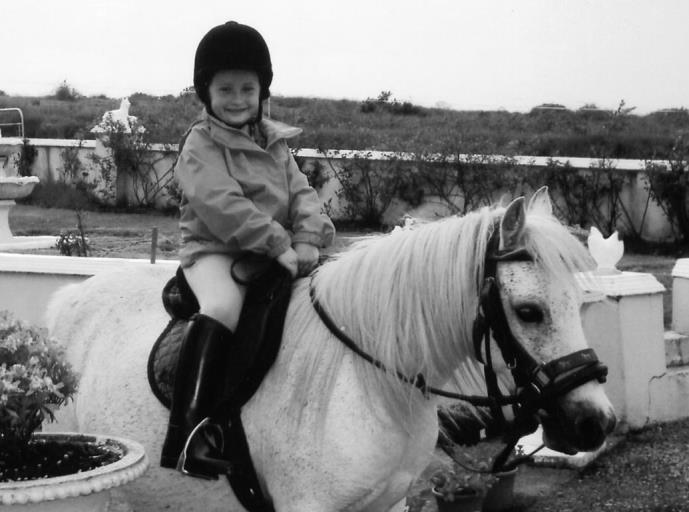
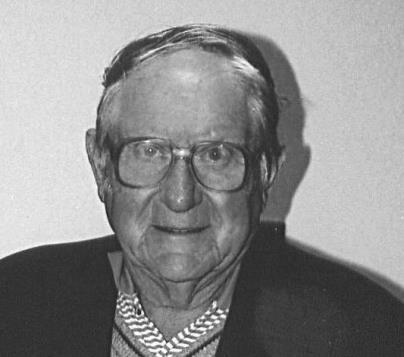
More serious was when the Inspector was due. But Paddy had a game plan! To forestall the inspector asking a question and then selecting a pupil to answer (who might not know the answer!) everyone was to instantly put up their hands whether they knew the answer or not and
Whatever about road signs John remembers a ‘sean focail’ (old saying) from his school days. It went somethinglikethis; Fan ar lar an bóthair agus ní beg baol go deo orth. Loosely translated it seem to mean Stay in the middle of the road and you will never be in danger. I don’t think we should test the theory.
JohnNolan Sinead Behan on her pony and on the right Nolan’s old Sunday shop oppositetheChurchIn these times of concern for the environment this article is revealing.
Checkingoutat thestore, the young cashier suggested to the older woman, that she should bring her own grocery bags because plastic bags weren't good for the environment. The woman apologised and explained, "We didn't have this green thing back in my earlier days." The young clerk responded, "That's our problem today. Your generation did not care enough to save our environment for future generations." Shewasright our generation didn't have thegreenthinginitsday.
Back then, we returned milk bottles to thestore. The store sent them back to the plant to be washed and sterilized and refilled, so it could use the same bottles over and over. So they really were truly recycled. But we didn't have the green thing back in ourday.
Grocery stores bagged our groceries in brown paper bags and cardboard boxes that we reused for numerous things. We used the brown paper bags to cover our schoolbooks. But too bad we
didn't do the green thing backthen.
We walked up stairs, because we didn't have an escalator in every store and office building. We walked to the grocery store and didn't climb into a 300 horsepower machine every time we had to go two blocks. But she was right. We didn't have the greenthinginourday.
Back then, we washed the baby's nappies because we didn't have the throwaway kind. We dried clothes on a line, not in an energy gobbling machine. Wind and solar power really did dry our clothes back in our early days. Kidsgothand me down clothes from their brothers or sisters, not alwaysbrand new clothing. But that young lady is right; we didn't have the greenthingbackinourday.
Back then, we had one TV, or radio, in the house not a TV in every room. And the TV had a small, not a screen the size of county Cork. In the kitchen, we blended and stirred by hand because we didn't have electric machines to do everything for us. When we packaged a fragile item to send in the mail, we used wadded up old newspapers to cushion it, not plastic bubble wrap.
Back then, we didn't fire up an engine and burn gasoline just to cut the lawn. We used
a push mower that ran on human power. We exercised by working so we didn't need to go to a health club to run on treadmills that operate on electricity. But she's right; we didn't have the green thingbackthen.
We drank from a fountain when we were thirsty instead of using a cup or a plastic bottle every time we had a drink of water and we drank water; not fizzy drinks. We refilled writing pens with ink instead of buying a new pen, and we replaced the razor blades in a razor instead of throwing away the whole razor just because the blade got dull. But we didn't have the green thing back then.
Back then, people took the bus and kids rode their bikes to school or walked instead of turning their moms into a 24 hour taxi service.Wehad one electrical outlet in a room, not an entire bank of sockets topoweradozenappliances.
And we didn't need a computerized gadget to receive a signal beamed from satellites 23,000 miles out in space in order to find the nearest burger joint. But isn't it sad that the current generation laments how wasteful we old folks were just because we didn't have thegreenthingbackthen?
In the Spring of 1960 the death took place at the Military Hospital in Athlone of Company Quartermaster Sergeant, James Walsh, a native of Lyreacrompane. James had served in the NationalArmysince1922 and had been in Athlone since 1927. In the early ‘20s he
had been an outstanding Gaelic footballer and had also served in the north Kerry Brigade of the IRA for which he held the 1917 21 Service Medal. James also hit the headlines some years before his death when he jumped fullyclothedinto theShannon to rescue a child from
drowning.
The chief mourners at James Walsh’s funeral were his widow, Mrs K Walsh, his three children and his sister Mrs Nora Kelliher from Spur, Lyreacrompane. Burial took place at Cornamagh Cemetery, Athlone.
Twenty one of us have just arrived back safe and sound on a Bus Eireann coach at Colbert Station, Limerick having been on our sixteenth Irish Rambling House tour of England. On this occasion we entertained the exiles in Birmingham, Camden, Harrow and Derby. The shows are full of great Irish traditional, music, song, dance, very humourous storytelling… and the Craic. Right now I’m thinking about all the exiles we have entertained and the many venues we have performed in during those years it’s just mind blowing.
All of this came about from a weekly programme ‘Kingdom Corner’ broadcast on a pirate radio station in Limerick Radio Limerick One (RLO). Presenter Joe Harrington initially invited musicians and singers into the radio studio to be part of a live broadcast. After a while this led to Joe and a sound team doing outside broadcasts from many bars, community halls and private homes around Limerick. These outside broadcasts naturally led to the weekly radio programme been renamed ‘The Rambling House’. The Rambling Houses of long ago ensured that the music, song, dance and stories was preserved and handed down the generations. This tradition was recaptured in the Joe Harrington Rambling House programme. The programme was broadcast every Monday night for three hours during which listeners were encouraged to phone in and go live on the air with news from their own place, tell a story or sing a song. The programme was also broadcast on the Astra
Satellite to England and main land Europe. For a while the programme also went out on RLO TV.
Responding to the demand from exiles in October 1998 we travelled to the London Irish Centre in Camden to do a live broadcast. We were welcomed to the Centre by the Mayor of Southend, Norah Goodman who has Lyreacrompane in her background. During this broadcast we met many people but one person stands out for me, Hugh Callaghan. Hugh, one of the Birmingham Six, a total gentleman, came along on the night to sing a song. He presented Joe with a signed copy of his book ‘A Cruel Fate’ One Man’s Triumph over Injustice.
Back home we continued to go out to various venues around Limerick recording locals but by now we were also rambling into the neighbouring counties of Kerry and Clare. At this stage the radio programme was been broadcast twice a week, every Monday and Thursday. On one occasion when Joe and I were discussing the mighty talent we were encountering we came up with the idea of staging a concert in the one thousand seated University Concert Hall, Limerick, around St. Patrick’s Day. We put a cast of one hundred and thirty people on stage that night we reckon it was the biggesttraditional concert ever staged in Limerick. It lasted three hours. We released this show on video Joe Harrington’s Rambling House 16th March 1999. Prior to this we had also recorded and released an eighteen track CD The Best of the Rambling House. So successful was the 1999 concert that the organisers of Limerick Civic Week Festival
asked us to launch their Millennium festival with a similar show again at the University Concert Hall. We did and once again it was a resounding success. We also recorded this show and releaseditonvideo.
In May 1999 we rambled north to the Green Glens of Antrim where we met and recorded Eugene McGaughey. Yes, you’ve guessed it; the song he sung and did so very well was ‘The Green Glens of Antrim’ along with a couple of hisownsongs.
By this time we were getting moreandmore requestsfrom Irish people/Centres to take our show to England. For the staging of our shows we always use the setting of an authentic old Irish Kitchen open fireplace, turf, skillet pot, a dresser complete with crockery, a picture of John F and Jackie Kennedy, deck of cards etc. Getting these props to England could present us with a problem. Joe and I approached Bus Eireann/Euro Lines for a quotation. At this time Euro Lines was a partner of Bus Eireann with coaches travelling to and from England. To our amazement and surprise John McLoughlin and Ian Dodson of Bus Eireann/Euro Lines decided to sponsor a coach and driver for our tour. It probably helped that Joe and John had known each other as members of the Limerick CouncilofTradesUnions.
Clare man, Derek Lane, would be our driver. To date Derek has been the driver for fifteen of our tours. We couldn’t have asked for a more obliging driver and all round helper. During our showsDerekcanoftenbe
seen selling DVD’s, manning doors and generally helping outduringourtours.
At this stage we also decided to embrace the word ‘Irish’ in our group name and we became known as ‘The Irish Rambling House’.
So on Thursday 27 April 2000 thirty four people, aged between eight and eighty years, set out from Colbert Station, Limerick to stage our very first show on English soil. That night we played at the Irish World Heritage Centre, Manchester. The next night we were down in the Haringey Irish Cultural and Community Centre, Totten ham, London. On Saturday 29 we were in the Ulster Suite, Birmingham Irish Centre and on Sunday 30 we played in the Leeds Irish Centre. Joining us on stage in Manchester was fifteen year old, accordion player, Patrick Doyle. Patrick’s great Grandmother, Nora Walsh came from Spur in Lyreacrompane. On return ing home we held a show on November 9 in the Woodlands Hotel, Adare. The late Paddy Faley was one of
our storytellers on the tour.
At the age of eighty it was Paddy’s first time out of west Limerick. Paddy travelled on a few tours with us and he and Chrissie Roche, another storyteller, were mighty with the pen recording many goings on that occurred while we were on the road. Also noting in humorous verse the many tour events were Peg Prenderville and Mary O’Keeffe.
So successful was this tour for both the Irish Rambling House and Bus Eireann that John McLoughlin, Business Development Executive with Bus Eireann, declared that he’d have no hesitation in supportingusagain.
Back in Limerick we continued to go out into communities recording the best of local talent. In July 2000 we staged shows at the Knockaderry Community Centre and we opened the Rathkeale Salsa Festival on Thursday August 10. Then in October, with the backing of Bus Eireann once again, thirty one entertainers headed back across the Irish Sea staging shows at
Manchester, The Galtymore, Cricklewood, Haringey, The Arrow Valley Club, Redditch andBirmingham.
On New Year’s Eve 2001 a fundraising card game was ran in Castlemahon and the ramblers also took part in a wren competition in Tralee. We were due back in England again with a group of thirty three in the spring of 2001 with planned shows in Manchester, Coventry, Galty more London and a show in Dublin on our way home. With the outbreak of foot and mouth in England we had concerns so we cancel the tour as many of our performers came from a rural background.
In 2001 Shannon Develop ment asked us to organised shows during the summer months of June, July and August for the tourists visiting the region. We held shows at the Woodland’s Hotel, Adare on Sundays, Jury’s Hotel Limerick on Tuesday’s and Wednesday’s we were at the Courtenay Lodge Hotel Newcastle West.
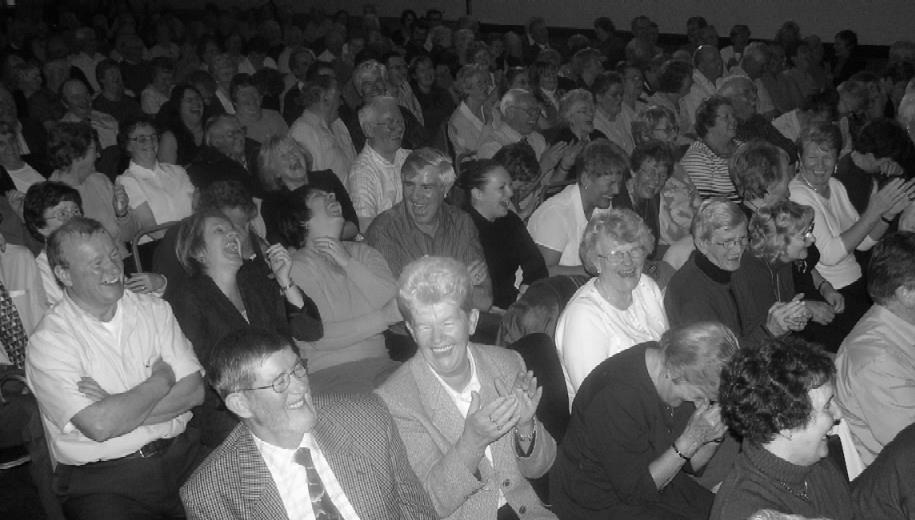
We reduced the storytelling feature at these shows considering the various nationalities attending and who would have had problems with accents. In September 2001 we took a group of ramblers into Madigan’s Thatched cottage in Stonehall, Co. Limerick where we had ‘Pat’s Tracks’ record a traditional rambling house session. That DVD is still available under the title The Irish Rambling House at Stonehall.
Autumn 2001 saw thirty six ramblers back in England with shows in the Albert Halls Bolton, Manchester, London, Coventry and Liverpool. The venues were packed with both young and not so young people. Back home we staged a show at Friars Gate Theatre, Kilmallock, on November 25. Before heading out on this tour the group put on a show at the Rathfredagh Cheshire Home in Newcastle West. St. Stephen’s Night 2001 saw us running a dance at the Rathkeale House Hotel. Dermot Lyons provided the music and the night will be remembered for Dermot, towards the end of the night, fainting and falling off his stool while playing. On December 30 Chrissie Roche organised a fundraising, 45 Card Drive in Raheenagh. By now we and some ramblers had the idea of taking the Irish Rambling House to the United States. Joe and I had gonetherescoutingandwhile we had got venues and people/groups interested we felt it would be beyond our budget. The cost of taken thepropsalong withramblers would be prohibited. When we go on tour to England the Irish Rambling House cover all transport and accommod ation costs. All participants need to take with them is spending money. During the
early tours the funds had allowed us to cover the cost of a daily meal for tour members.
Another requirement for tour participants is the ‘phone in’. This has to be done at 3am, on the morning of departure, sothatJoeandIknowthat
conjunction with Tralee Carers Association at Siamsa Tíre, Trá lí.
group members are on their waytoLimerickstationwhere weboardourcoachat 4amto set out for the North Wall and theStenaferry.
In Spring 2002 we had shows in Manchester, Mapperley Plains Social Centre Nottingham, Galtymore London, Birmingham and St. Patrick’s Club Leamington Spa. On 14 April we held our first show in Co. Clare at the Glór Theatre. We returned with another show on November 2. We also ran summer shows in conjunction with Shannon development, in the Woodlands Hotel Adare, Jury’s Hotel and the Glentworth Hotel Limerick City. Autumn 2002 saw twentysevenofusperformin Bolton, Leamington Spa, The Galtymore, Birmingham and St. Finbar’s Club Coventry. The first appearance of the Irish Rambling House in the Kingdom of Kerry was on December 21 when we held a fundraisingshowin
In 2003 we held summer shows at the Two Mile Inn Hotel, Ennis Road, and Jury’s Hotel, Limerick. With the continued support of Bus Eireann we were back in England in October 2003 with shows in Bolton, Huddersfield, Redditch, Harrow and Birmingham. On returning home we were invited to perform at the Scartaglin Heritage Centre on November 29. During our early tours we had people offering to pay to travel with the group for the experience. While travelling with us they got stuck in helping out so it soon reached the stage that Joe and I felt we could no longer charge them. As we were already taken back stage people on tour we ceased taken paying passengers. Also during our earlier tours we always stopped off at The Red Cow for breakfast. Tom Moran always opened early and had staff on hand to serve us pretty quickly so as to get us on the road to the North Wall in time to board the ferry. With the change of road design we had to stop this practice.
On March 13 2004 we staged a show at The Millennium Theatre, Moylish, Limerick. Then we got a phone call from John McLoughlin, Bus Eireann wanting to see us. John was retiring and Eurolines had seized the opportunity to close their Limerickoffice from2005. All further correspondence including sponsorship would now be dealt with by their Dublin office. Needless to say they forgot about us. Our 2004 tour took us to Bolton Redditch, Huddersfield Bir mingham and Harrow.
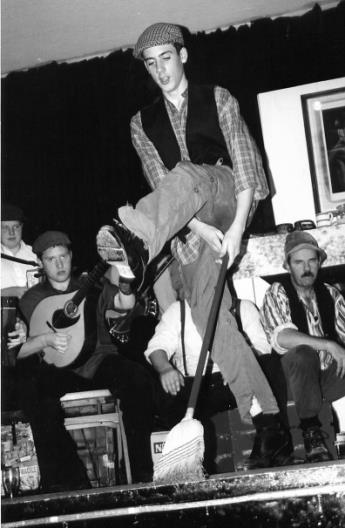
While on a visit to London in February 2005 I phoned Johnny Byrnes of Byrne Bros Contractors seeking sponsorship. The Byrne Bros come from our parish of Duagh/Lyreacrompane and I knew that they would have an understanding of what our annual tour meant to the exiles. Johnny agreed and they gave us some sponsorship for our tours between and including 2005 and 2010. Twenty nine people took part in 2005 tour playing in Derby, Harrow, Manchester and Birmingham. It was during this tour that the Irish Rambling House performed at the same venue two nights in a row the Salvatorian College Hall, Harrow. The dates were Friday 4 and Saturday 5 November. Both shows were packed. On returning home we performed in Duagh on November 25. Thirty two entertainers headed to Leads on 1 November 2006 then onto Lincoln, Harrow for two shows again and Birmingham. We were back in Duagh Hall on November 18. We also had a new DVD
‘Live from Harrow’ on sale during this tour and much to our surprise it was highlighted on RTE’s Podge andRodgeshow.
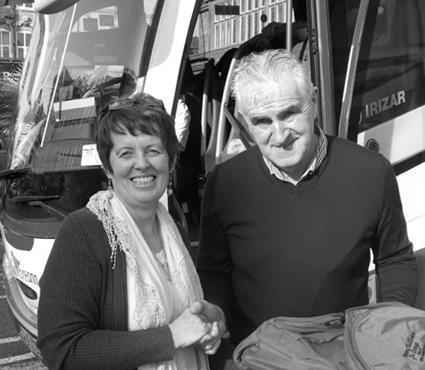

Our 2007 tour had a diverse twist to it. We had been asked by a group in London if we could do something for the Cricklewood Homeless Concern organisation. Having thought about it Joe and I decided to undertake a fundraising walk and to hold a concert for the group during our tour. We asked Donncha O’Dulaing, of RTE and a well known charity walker, to join us. Joe wrote a song ‘Walk around London’ for the fundraiser. Donncha narrated part of it and Billy Donegan sang it. We released it on CD and the income from the sales went to the group. On our way through Dublin on Wednesday October 31 we collected Donncha from outside the Point Theatre. We did a ‘bucket’ fundraising walk from Quex Road Church
inKilburnto theCrownMoran Hotel. That night we featured the ‘Maids of Erin’ in concert at the Crown Moran Hotel. The Maids of Eireann consisted of the very talented female singers and musicians of the Irish Rambling House and we had taken this group into the recording studio and recorded the ‘Maids of Erin’ CD. The proceeds from this show also went to the Cricklewood Homeless Concern group. In total, our voluntary community group, The Irish Rambling House, were delighted to present £3,000, to the Cricklewood Homeless Concern Organisa tion. On another occasion we responded to a request for the Maids to entertain at an old folks home in London and wealsotooktheMaidsofErin to the RTE studios in Dublin at the request of Donncha to bepartofhisChristmasFailte Isteach programme.
It was during our fundraising concert at the Crown Moran Hotel that we first met South Kerry man, Danny O’Sullivan.
At the time none of us knew Danny and as he has often said to me since that night “you didn’t know what to make of me when we first met” and as the saying goes “sín scéal eile”. Since that meeting Danny has become the sponsor of the Irish Rambling House and I couldn’t speak highly enough of him. Since that first meeting every tour that we have taken to England Danny has always met up with the groupandhehas oftenjoined us on stage. That year we held shows in Derby, Birmingham, Lincoln and Harrow. Twentyninepeopled travelled. Since we first went ontourwehavealwaystaken our own sound. Cork man, Dan O’Callaghan, has fulfilled thispositionfor ussince 2007 and he is one of the best at his job. During our shows Dan has often hopped on stage and played the Uilleann pipes. Wewere also delighted to be invited by Donncha to the launch of his book ‘Donncha’s World’ in Dublin last September. We were also pleased to see that Donncha had included photos of the Maids of Eirn and the recording of a programme for RTE ‘Fáilte Isteach’ outside theCrownMoranHotelduring thattour.
Thursday October 30 2008 saw us in St. Patrick’s Club Leamington Spa, Haringey, Harrow and Birmingham and back at home in Duagh. Twenty six people were on this tour. On this occasion we supported the Fireside Charity, Birmingham with a €500 donation. On all of our tours we either share the takings with the local organising groups or we pay individuals who help organise our shows. We always have a session on board the Stena ferry while crossing the Irish Sea much to the delight of fellow passengers who often
tell us we shorten their journey.
In 2009 we performed two shows at home. We were in Duagh on October 23 and the Devon Inn on December 3. Between these two shows a twenty three member group entertained the exiles in Newark on Trent, Haringey, Harrow and Birmingham. Again in 2010 we staged two shows in Munster. October 13 saw us performing at the Devon Inn and November 13 we were in Lisdoonvarna before twenty one of us headed to England with shows in Derby, Birmingham, Haringey, Harrow and Manchester.
In 2011 I decided to put the story of the yearly Irish Rambling House tour in verse. Doris Shire, also known as the ‘Mungret Nightingale’, recorded it at Pat’s Tracks in Causeway. Doris is the only entertainer who has been on all our shows and on all our tours.
The ramblers gather in at dawn
To board our Rambling Bus As we set out on that highway A familiar route to us. We’ll cross the dear old Irish Sea
With our music, songs & craic We’re going to the exiles To take the exiles back.
We’ll take them back in time
Their memories we’ll arouse And paint for them a picture Of an Irish rambling house. A Rambling House so cosy Where music, dance and song Would echo to the rafters In a time that’s long since gone
With Holyhead behind us We’re touring ‘round in style
The music rings around the coach
And there’s dancing in the aisle
The welcome at the venues Is mighty to relate And eager exiles pack the halls
The M1 leads to London We’ll stage our show again And at the Irish venues there We’ll meet our kith & kin and the sessions they are mighty
In each Irish neighbourhood And we always stay in Moran’s
In the heart of Cricklewood
We’ll take them back in time
Their memories we’ll arouse And paint for them a picture Of an Irish rambling house. A Rambling House so cosy Where music, dance and song Would echo to the rafters In a time that’s long since gone
The props are loaded up again
And the ferry lies ahead Weary bodies stretch about Sure we rarely saw the bed But already plans we’re making For we’re wanted back next year
And we’re happy that the exiles Hold the Irish ramblers dear
We’ll take them back in time Their memories we’ll arouse And paint for them a picture Of an Irish rambling house. A Rambling House so cosy Where music, dance and song Would echo to the rafters In a time that’s long since gone
In 2011 we had a show in Lisdoonvarna on October 1 before heading on a Bus Eireann coach to Birmingham on Thursday October 20 followed by performances in 23
Haringey, Harrow and Newark on Trent. Twenty five entertainers toured on this occasion. In 2012 we had twenty one people on stage at a show in St. John’s, Listowel before heading to Birmingham on November 1. Haringey November 2, Harrow November 3 and DerbyNovember4.
In 2013 we were invited by the Leamington Spa Irish Centre Committee to be part of their, week long, fiftieth anniversary celebrations. We normally organise our tours around the mid term break/Halloween but to facilitate Leamington we had to go a couple of weeks earlier than usual. Before heading off we went down to South Kerry for the first time. We were invited by Danny O’Sullivan to stage a show at the Foilmore Community Centre on Friday October 11. We hired a coach to ferry the performers to Foilmore. Oh boy! Were we impressed with the beautiful centre and the facilities there are brilliant. The stage was mighty with loads of room to show off our traditional Irish kitchen and for our entertainers to show off their talent. From the moment we arrived the kettle was continuously on the boil for us. Leaving the venue that night we were stuffed. Aren’t the community of Foilmore/Kells lucky to have Danny O’Sullivan. On the night it was very evident to us the esteem that Danny is held in by the locals and it’s also very obvious that Danny has never forgotten his own place. He came on stage that night to sing a song and got the biggest roundofapplause.
Prior to this show we had performed in St. John’s Listowel. After our Kerry shows twenty one of us set off across the Irish Sea to
entertain the exiles in Leamington Spa October 16, Birmingham, Camden and Harrow. We always stay at the Crown Moran Hotel while in London. On this occasion our tour coincided with the holding of the annual Kerry Association Dinner Dance at the Crown Moran. Danny O’Sullivan is Chairperson of the Association and he had reserved a table for the Irish Rambling House. .
The Irish Rambling House project has been a great adventure and like all adventures it had its odd moments like the time we arrived in Lincoln to discover that the stage was carpeted and not suitable for our step dancers. Panic stations. Three sheets of plywood was the answer but the hardware store was two miles down the road. The coach was our only answer so down we went and pulled the 53 seater into the yard, bought the sheets and used their pliable nature to get them into the aisle of the coach. As we were pulling away we noticed a crowd looking on. All the staff of the store and the offices wereout to see the unique sight in Lincoln of a Bus Eireann coach picking up timber!!! Or the time we sort of gate crashed the Kerry Association Dinner Dance, met the Rose of Tralee and asked her to officially open the Dan Paddy Andy. Clare Kambamettu said yes! Or the time we could find no overnight parking in Birmingham. Derek and Joe dropped us at the hotel after the show and drove down to Birmingham Coach Station which we knew we would have needed to have booked amonthbefore. Derekboldly drove in. The guy in charge ran forward with a look of authority but quick as a flash Derekstuckhisheadoutthe
window and said “Where will I park her up mate? “Mr Authority”, now not sure if he had forgotten a booking, said “over there”. Derek parked in record time and himself and Joe cut out the gate in quick time in case your man would realise he had been conned. Next morning there was a different guy on duty and we told him “Mr Authority” had given us permission! Or the time Joe told the audience in Birmingham that he was delighted we were in Dublin or like myself this year when I stood on the stage in Camden to introduce the show and declared that I hadn’t a clue where I was! It can become confusing whizzing around to the different venues. And the embarrassing thing about this one is that it was being recordedforournextDVD.
Between the years 2000 and 2014 I reckon Joe and I have had one hundred and eighty three entertainers on stage for Irish Rambling House shows at home and on our tours of England. I couldn’t begin to count the number of people Joe recorded during his time with RLO. Maybe someday we’ll get around to looking back at those recordings. Our motto always is “If laughter is the best medicine than an Irish Rambling House show is the prescription”.
The introduction to all our shows, at home or abroad comes from a poem Joe pinned and it will be very familiar to entertainers and exilesalike;
Pull up your sugan chairs my friends
Beside the fireside glow and let’s go back to how it was
In the Ireland of long go.
If one were to ask the question "What is the Sam Maguire?” I guarantee most people in Ireland would know the answer. It is the much coveted and prestigious trophy which is awarded to the winning All Ireland Gaelic football team at senior level. But if the question was "Who was Sam Maguire” the answer would probably be quite different. Sadly, Sam Maguire is often referred to as the 'forgotten man' which is one of the sad facts of life. Through the investigatory work and research by Garrett Sheehy, important inform ation is available and we know that Sam Maguire was one of the bravest men of the twentieth century. He undertook what must have been one of the most important steps which may have changed the course of Irishhistory.
Sam Maguire was born near Dunmanway in West Cork in 1879. His parents were Church of Ireland and they farmed a 200 acre farm whichwaslargebyWestCork standards. The Maguire's had six children, four boys and two girls, and Sam was the second youngest. He was educated at Ardfield which was also the school that MichaelCollinsattended.
Sam was an excellent student and at the age of 20, got a position in the Civil Service in London in 1899. Always interested in the young GAA, he joined the young London Hibernians as soon as he settled in London and he captained the team for many years. Records show he was the captain of the Hibernians when they played in Croke Park in 1906. In 1907, he went into administration in the GAA and became Chairman of the London Board, and was a regular delegate at the Annual CongressinDublin.
Vice Chairman of the London Board, and a friend of Sam Maguire, was Liam McCarthy. He was born in London in 1851 of Irish parents and worked in the post office. He was interested in the GAA from its foundation and is the same Liam McCarthy commemorated with the senior All Ireland Hurling Cup TheLiamMcCarthyCup.

While Sam Maguire devoted much of his life to GAA matters, he turned some of his attention to the IRB (The Irish Republican Brotherhood) London Branch. In November 1909, he swore into the organisation a young post office worker from Clonakilty who was to become one of the most important men in Irish history that man was Michael Collins. He and Sam Maguire became close friends and, when Collins became head of the organisation, Maguire became Lieutenant General and Chief Intelligence Officer. It was in this role that he carried out much of his most important work, travelling from London to Dublin with important information that he dare not write down. His position in the Civil Service gave him access to important Government information and
he was able to intercept official state papers relevant to British Military and political plans for Ireland. This work went on for many years and all the time Sam Maguire was riskinghislife.
When the assassination of Sir Henry Wilson took place in June1922, wearetold British Intelligence got suspicious. Wilson had been a Field Marshall in the Army, and on retirement became a Unionist MP for North Down with responsibility for the Special Constabulary and was official advisor to the Minister for Home Affairs. The inform ation on this assassination is sketchy and it is not surprising that the real story was kept secret to protect those involved when British Intelligence became suspic ious of a post office worker with the initials 'SM'. Sam Maguire decided it was time to head back to Dublin. Some sources say he was caught, lost his job in the Civil Service and served a prison sentence. However, there is no evidence of this and we can be sure if British Intelligence knew the extent of his undercover work for his country he would have got more punishment than a mereprisonsentence.
WearetoldthatSamMaguire did not take part in the 1916 Rising though he would have liked to but he felt his work in London was more important. He was totally against the Civil War and was deeply saddened by it, but remained on the pro treaty because of Michael Collins. He got a job in the newly establishedIrishCivilService, but clashed with pro British staff that remained here and lost his job. During this time his health was failing and he returned to Mallabraca, his birth place near Dunmanway, where he died in 1927 at the 25
age of 48 years. In 1928 a group of friends from Dunmanway formed a committee to raise funds for a permanent commemoration of Sam Maguire's name. They presentedtheCupto theGAA who were proud to accept it. They realised the important work he did for the Gaelic Athletic Association in London. We are told he was the only protestant to captain a senior football team showing that, as far as he was concerned, religion did notenterintothesport.

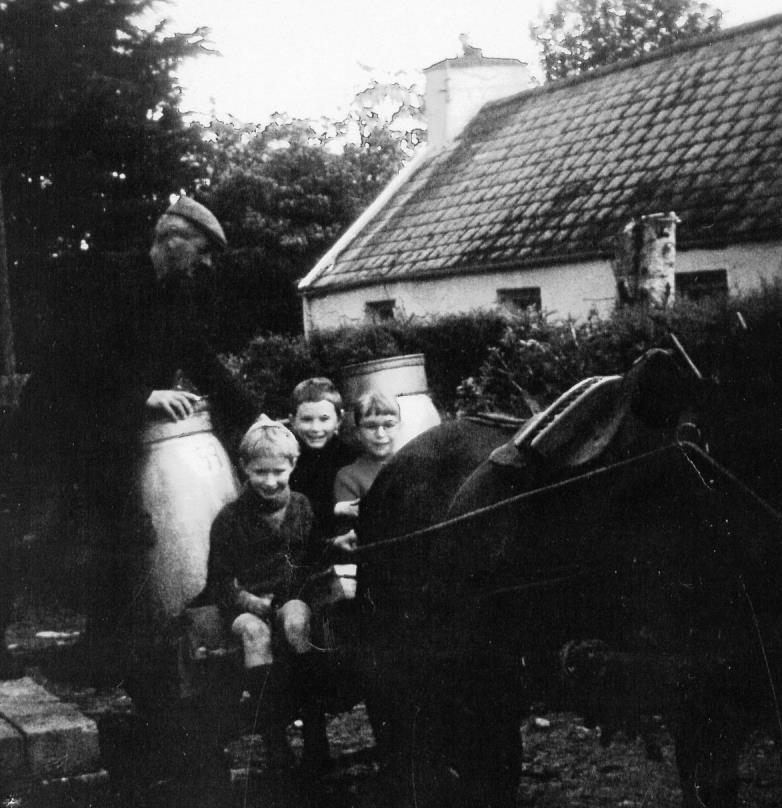
The Sam Maguire Cup was modelled on the Ardagh Chalice and was made by Hopkins and Hopkins of O‘Connell Bridge, Dublin, at the cost of £300, equivalent to €25,50O in to days costs. Kildarewasthefirstcountyto win The Sam Maguire when they defeated Cavan 2 6 to 2 5 in 1928. The Cup had to be replaced in 1998 and Meath is the last County to have their names inscribed in the original Cup with their defeatofCorkin1991.
In 1938, the local people of Dunmanway decided to buy a Park for Gaelic games in memory of Sam Maguire and on April 21st. 1974, the park was officially opened by the then President of the GAA, Dr Donal Keenan. On Septem ber 15th 2002 a statue of Sam Maguire was unveiled as a centrepiece to a new £500,000 town plaza in Dunmanway. It is a fitting tributetothe"forgotten" man whose heart was broken by theCivilWar.
Sam Maguire should never be forgotten. He was a great leader who through the love for his country put it on the roadtoIndependence.
Sean Dillane, Cloghane with Denis, Tony and Angela Quill children of Tim and Phil Quill, Cloghane and England. SonnyEganwhoopenedDanPaddyAndy Festival2013
ThefirsttimeI saw Bridie I was hopping o’er the style Onmywaydowntothewellbesidethestream Shewastendingtothefarmchores amilkpailinherhand At her home down at the end of Long’s boreen.
Andlater,ontheshortcutdownthemountainside toschool Inthetimeswhenthingswereready andwererough. Isawherthere, workinginthebogupnearBanemore Inanerawhenthecurrencywasturf.
Inthesunnydaysofyesteryear;inthatmagicplacecalledSpur Ifishedalongthatrushinglittlebrook. ‘Twas there I glimpsed her kissing Joe; her one and only love AndI, abashfulyounglad, shytolook.
Yearspassedby;wemetagainwaydownin LimerickTown TwastherethatJoeandBridiewenttostay And later in O’Malley Park what odds would you allow Theywereneighbourslivingrightacrosstheway.
AndshewasproudofTommyandrattledeverydoor Tomakehislifeanindependent one AndTommymetthepresidentsandTommymetaRose TherewasnothingBridieQuillwouldleaveundone
And when Joe became “The Kerryman” on Frawley’s radio OnGaltyandonRadioLimerickOne ThequalitycontrollerwasBridieback atbase Shewasonthephoneifanythingwentwrong.
AndwhenacertainLyremanmadeittotheMayoralchair TwasJoeandBridiesenttherallyingcall AndtheygatheredKerryexilestocelebratetheday Thephotographstillhangsuponourwall
Forourlocal LyreJournal, Joewouldalwayswritealot Regardingissuesseriousandfunny And one day Bridie said to me “I’m sure I could do that” Andshedid;andgaveJoeaprettygoodrunforhismoney
But verses can’t do justice to a live so ably lived Andthelivingofalifecanseemsofast ButmemoriesofBridie;likeagoldentreadwilllink Tothethingthatmakesuswhatweare ourpast.
JoeHarrington 26/11/2012
In October 1960 the Elm Bar in Duagh along with 142 acres of land were sold for £16,375. It was the propertyofMrThomas JDillon. Thepurchaserswere Mr Thomas Barron, Chicago who bought the bar and Springmount Farm for £12,100 and Patrick Dillon Kilmorna who bought the land at Foildarrig for £4,275.
Bridie, who sadly passed away just two years ago was a regular contributor to the Lyreacrompane and District Journal Lyre unstoppable in 1960!
In November 1960 Lyre made history by defeating Toor at Duagh in their first ever Parish League Final (11 a-side). Lyre were leading 2 5 to 1 1 at half time but Toor fought back in the second half until a well taken goal by Billy Doran broke their spirit. Lyre went on to win 3 7 to 2 3.
The Lyre team on the day were F Ahern in goals, B McCarthy, Willie Falvey, B O’Connell, T Dillon, J Buckley, B McKenna, N Mahony, W Doran, N Murphy, D Horgan. John Neville came on for Mahony during the game and was, himself substituted by J Doran.
Around the same time Lyre defeated Knocknasna by 3 8 to 1 2 in an interschool’s match played in Abbeyfeale and in Senior Football at Carrig Lyre Pioneers beat the rest of Lyre by 2-5 to 1-2.
My voyagetoBanemore,Inowmustrelate, Concerningadance,thatwas heldthereoflate. ThegirlsofBanemore,toour boysdidwrite, Don’t forget Jack O’Brien’s next Saturday Night. ‘Twas early that evening our boys did take flight, Takingwiththema lantern,toshowthemsome light.
Back by Mick Sheehy’s and across Sharpersdoor, Andondowntheboggy roadgoingforBanemore.
Singingdownderry down,derry downderry dee
WecalledintoSeánMolyneaux,afinedacentold man, BegorthensaysSeán,butyecametotheright one.
Tisasmalllittlehouseatthebuttofthehill, Andthegableisbuilton theback ofaditch. Wewalkeddownthehill,till wecametothedoor Andthenextplacewelandedwasoutonthefloor Wecalloutfourgirlstodanceusareel, BegorsaystheGortbutyergreatatthewheel.
Singingdownderry down,derry downderry dee
Thesupperwasthenextthingthatwas introduced, Twobitesandasup,anoldwomanexcused. So I don’t have to tell you, our feedingwaslight wesix poormisfortunes,thatweretrudgingall night.
When the supper was over, I needn’t say more, Theboysandthegirlsmoveddowntothedoor. Someboysthey hadgirlsandmorethey had none, Whilemyselfandmy comrade,wereleftall alone.
Singingdownderry down,derry downderry dee
We all sat around Jack O’Brien’s little fire, Thinkingof thelongjourney betweenusandLyre. Says my comrade to me we’ll make out the Half Way, We’ll drink a few pints and go home fine and gay. Wewalked till we came up to Robineen’s door, Robineenstoodinsideinthemiddleofthe floor. Hiswifescratchedhisback,hewasholdingthe light, SayingJohannadidyouseemy oldgansey last night.
Singingdownderry down,derry downderry dee
My gallantoldcomradepickingupakeerraune, Took ashotatthedoor fromthemiddleofthe lawn.
Robineenjumpedandfelldownon hisknees. Saying conscription is passed; they’re coming for me.
Now I’ve told all and I’ll tell you no more But I’ll never forget thatbigdanceinBanemore.
Singingdownderry down,derry downderry dee
A photo of James and Mary Nash above when they arrived in Australia forty years ago and below they celebrate Kerry’s victory in the All Ireland Football Final down under. Mary married Seamus Orr from Donegal. All live in Melbourne.


 JohnJoeandBridieSheehy
JohnJoeandBridieSheehy
Ihavebeeninvolvedwiththe internet radio station Irish Country Music Radio (ICMR) for 2 years now. I present a programme called "Helen's Sunshine Show" from Bris bane in Queensland twice a week.

It all started a few years ago whenIwas homeon holidays to Ireland. I went with my brother, Joe Harrington, to the studio when he was presenting his show. Joe introduced me to Pat Garrett, the owner of the station. Pat asked me if I would have a goatpresenting. Atthattime I didn't have the broad casting equipment to set up so there was no way that I coulddoit.
Well a couple of years passed and on another visit to Ireland, Joe's mate, Billy Donegan, informed me that the show could be done on an iPad. Billy was kind enough to set me up with the right program and all the information needed to produce the show. Billy has
The Blue Aces Showband was playing at the Ashe Ballroom in Tralee and St Brendan’s Ballroom in Ballymacelligot hosted The Everglades. The attraction in the Grand Hotel was the Kingdomaires and out in Scartaglin the Big Beats Showband was playing in the new East End Ball room. Hedley’s Bridge had the Radiant Showband The Drifters were on stage at the glamorously named Las VegasBallroom, Listowel
been a great help since I started and still helps me out when I get stuck as I am not very technically minded even waking him up in the middle of the night for some help as there is a time difference between Ireland and Australia (The show mustgoon!)
I keep in contact with a lot of Irish people and also people that listen from around the world. I have listeners of course from Ireland but also from England, Scotland, around America, Australia and even from Brazil and Korea. People can email in with their requests and it is great to see that so many people love the Irish Country Music. I try to have their requested song but it is impossible to have all of them as there are so many great Irish country songs out there.
It is a great way of keeping up with the Irish singers and their new Albums as they are released. My favourite song is County Bondi but I have some other favourites also which if you listen you will hear them played quite often.
The first Irish Country Music Awards were held in November this year (2014) and I was so sorry that I couldn’t be there. It would have been great to meet so many Irish singers and presenters at the same venue. I have been told it was an awesome night and looking at the Facebook pictures it sure was. Looking forward to attending thenexttime.
Well, that’s my story of how I keep in touch with my Irish heritage. Many thanks to my brother, Joe Harrington, for introducing me to Pat and also to Joe and Kay for the great Jingle that they put together for the start of my show. Specialthanksagainto Billy Donegan for all the great help he has given me and also to the other Presenters who help me out fromtimetotime.
I love doing the show and bringing the great Irish Country music to all the fans out there. Maybe you will tune in sometime. I love to hear from people at home so just click the red button on www.irishcountrymusicradio.com andsayhello!!!
In 1954 statements were taken from surviving membersoftheold IRA. This one was taken from Duagh man Matthew Finucane then living at Gortnaskehy, Ballybunion. He was a member of the Duagh Company Irish Volunteers, Co. Kerry, 1914 1921.
I was born in Duagh, Co. Kerry, in the year 1893. I attended the local National School until I was 15 years of age. In April 1914 I joined the Volunteers when they were first formed in Duagh. Two brothers, ex British soldiers, named Jerry and Thomas Keane, were appointed drill instructors. We paraded and drilled for a time until John Redmond's call on the Volunteers to defend the coasts of Ireland, after which there was a split in the company which soon afterceasedtoexist.
Early in 1916 the company was reorganised by Ernest Blythe, who was reorganising the Volunteers in Co. Kerry at this time. A man named Tom Kelly was appointed company captain. There were about 20 members at first and they included a brother of mine, Patrick Finucane, Michael Galvin and Michael Morgan Sheehy About a week before Easter Week 1916, we received instructions to prepare for large scale manoeuvres for the following Easter Sunday and Monday. In the company at the time we had at least two rifles, about twenty revolvers and a number of shotguns. In Easter Week we were mobilised several times awaiting orders which never came, as far as I am aware, no member of the company tookanypartintherebellion.
After the Rising the order came from the Battalion O C Paddy Landers to surrender all arms in the company; this order was never carried out, as the R.I.C. were not aware that there were any arms in the possession of the Volunteers here in Duagh.
There was very little doing in the company after the Rising until early in 1917 when the Volunteers were reorganised for the 2nd time. Tom Kelly was again appointed company captain and Paddy McMahon was appointed 1st Lieutenant. The company strength was about forty men. Up to the end of 1917 and all through 1918 we held meetings, received drill instruction and paraded from time to time. Our drill instructor was Gerry Keane, the ex British soldier, who had been our instructor in 1914. Parades continued in 1919 and about the summer of this year I was appointed Q.M. of the company and was responsible later in the year for the collection of all shotguns and arms in the area. I attended to the guns andhadadumpprepared.
After the Republican Courts were set up I was appointed officer in charge of police for the battalion area and was responsible for keeping law and order. I used an unoccupied house away in the fields at the back of my mother's house as a prison. In this house I often had to imprison men sentenced in the Court. It was a Father Harrington who acted as judgeofthelocalCourt.
On the 2nd June 1920, the company officers decided to attack Brosna R.I.C. barracks about six miles from Duagh. Seven men James Costello, Bob Stack, Pat McMahon, Michael Lenihan, Jack Mulcare, Thomas Fitzgerald and Jimmy Joy, armed with revolvers and shotguns,
preceded, in a motor car, the main body of the company of about fifty men, which followed behind on foot. I was armed with a shotgun and was with the men on foot; most of these men had either shotguns or revolvers. The roads around the barrackshadbeentrenched. When the motor car reached Feale's Bridge, about two miles from the barracks, it ran into a military patrol which had already taken up positions in a Protestant Church convenient to the bridge and at different points in the vicinity. The seven men in the car were captured, but one of them Jim Costello escaped almost immediately and ran back along the road and warned the men following to get back to Duagh at once. I, with the other men, including Jack Sheehy, Michael Sheehy and Jack Larkin returned to Duagh. About a fortnight after this setback, the company, led by H. Murphy, turned out again and marched in formation towards Brosna for another attemptonthe R.I.C. Barracks
When we got to Feale's Bridge the company was halted. A number of men were placed in positions at the Protestant Church and in the neighbourhood of the bridge, the main body of the company being located between the bridge and Brosna Village at various points. I was armed with a revolver and shotgun and was on duty at the bridge; the other men between the bridge and the village had either revolvers or shotguns. The attacking party, about twenty men armed with rifles, shotguns and revolvers, then proceeded towards the barracks. Feale's Bridge is the centre of a number of crossroads leading to Castleisland and Tralee, to Newcastlewest and Abbey
feale and to Listowel. The purpose of placing most of the men between this bridge and the village was to keep open a line of retreat for the attacking party. As before, all roads in the area had been blocked or trenched. As I was not in the actual attack on the barracks I cannot give any details of the attack itself; it started at about 11 p.m. and lasted for about four hours when it was called off. I, with the rest of the company, returned to Duagh. The attack had not been a success.
After the attack on the barracks at Brosna, I was on the run for several months, but, in the meantime, I had charge of the dump and looked after all rifles, shotguns and revolvers for the company. I also carried out my duties as Police Officer for the area. In the autumn of this year I decided to return home. I took with me Jim Costello, Jerry Lyons, Christy Broderick and a number of other men. I turned my home into a barracks. The company captainsawtoitthatasentry was posted near the house for the 24 hours of the day.
Early in 1921 the flying column for North Kerry was formed. My house immed iately became their H.Q. and provided most of their needs in the shape of food and shelter, as well as the provision of shotguns, rifles and revolvers when required. It was also used for the receipt of dispatches from Brigade H.Q. and elsewhere. Among the men of the column who stayed at my house at the time were P.J. McElligott, Johnny Linnane and Denis Quille Shortly after the formation of the column, I took part with other members of the Duagh Company in the trenching of roads, cutting of telegraph
wires and trees on the occasion of the I.R.A. attack on Ballybunion R.I.C. Barracks in February of this year. During the actual attack on the Barracks I, with other members of the I.R.A, armed with revolvers and shotguns, took up positions near Listowel R.I.C. Barracks to prevent the Tans from there being sent to reinforce the BallybunionR.I.C.
The Tans were under the impression that it was them that were being attacked. They opened fire and sent up Verey lights for a couple of hours. Early in May, the company captain and I were informed by Jack Sheehan and Paddy Ahern of the column that an ex British officer Sir Arthur Vickers of Kilmorna House (known locally as the Great House) had been sentenced to death. The company captain, Jim Costello, was told to have the man executed and to burn down the “Great House".
Sometime earlier Sir Arthur had invited a number of British officers to his home for a fishing holiday on his estate. Soon after their arrival these officers were attacked by the column. The captain instructed me to procure a quantity of paraffin oil and to take it down and leave it as near the house as possible; this I did with the help of Jim Costello, Tom Kelly and Tommy Sheehy. A number of men from the company were instructed to report at 8 o'clock at a certain spot near the house on the following morning. The next morning all the men reported for duty; Jim Costello, being in charge, ordered that at a certain signal the men were to advance on the house. Some of the men were armed with revolvers or shotguns. I had a revolver. A number of the men were detailed to carry
the paraffin oil. We had been told that if we did not receive the signal by 4pm. that day the company was to return to Duagh. We did not receive the agreed signal by the time stated. We dispersed and returnedtoDuagh.
Early that night a company meeting was held. Sheehan and Ahern were present. A discussion took place as to whether we should go back that same night to carry out the execution and fire the "Great House". It was decided not to go back that night but to return the following morning at approximately the same time as originally agreed. On the following morning the company assembled as before. I, on this occasion, was ordered to patrol the hill overlooking the "Great House". This was to give warning of any approach of the enemy forces. Early on this day the execution took place and the "Great House" was burned down. The company afterwards dispersed and returned to Duagh. Two of the men with me on this occasion, as well asthecompanycaptain, were Jerh. Halpin and Christy Broderick.
On several occasions from January to the Truce I took part in raids on the mails and trenching of roads. In all of these operations I was usually on guard duty armed with a revolver and later with a rifle. All this time my house was used by the column and remained at their disposal while the sentry remained on dutyrightuptotheend.
After the Truce I, with Tim Finucane from the Duagh Company, were selected with men from other companies to take over the barracks of the TansatListowel.
(Mathew Finucane 14/7/1954)
Carrauntoohil
Climbed by 61 ‘Ballymaclimbers’ on Sunday June 2nd 2013 in aid of the Irish Guide Dog Association. A few words inspired by the day from JJ Sheehy
From Cronin’s Yard we travelled hard towards that cross upon the hill, Withpinksoftthighsandclearblueskiesnotimeforstandingstill. WehadLenihanJohn&Emily onoursidetoguide usthere, WithaHuffandaPuffwewerepumpingstuff;mountaingoatswereinclinedtostare.
Somehadfivegallondrumsofwaterandsomehadnowateratall, Likeotherswithbunsbakedbytheirmothersenoughtoopenamarketstall. Wehadbumbags, back bagsandbellybagsandsmokerspollutingtheair, Wehadpinksacks, yellowsacksandsomehadlegswaxedsnowwhitewithoutaribofhair.
Afterthefirstdeadlyclimbwetravelledinalinetothatpointwherewegatheredinabunch, Withthesoundofcorkstwistingandpapersunwrappingwesatbythelaketohavelunch. Withcameraphonesclickingandbananalickingourguidescountedusonemoretime, Wetookonemorelookupaswecleanedoutour cupandoncemorewestartedtoclimb.
Now, withthepressureoflunchsomebrokefromthebunchandsquattedbehindtherocks, ItwasliketheHairyAssfairintheCountyClare;Ohwhydidtheystop withthatwax. Butinnotimetheywerebackinlineallpreparedtofinishthejob, Onthatsteepinclineyoucouldhearpeoplewhineandsomewerebeginningtosob.
Atthatsecondheightwestayedinclosesightasdowncameaterriblefog, Itremindedmeofmyyouthagaininthemeadoworinthebog. Beingwithinashout ofthesummitlikerabbitswestartedtohop, We all knew right then when we’d meet again it should be at the top.
Whenwereachedthecrosswithoutalossornobodyleft behind, Thefeelingwasgreat, plentyfoodtoate, plentytimeforustounwind. Kerry&KilkennywerewellrepresentedbyJohnLyons&Senan, Theysportedtheirjerseyslikepastcountyheroeswhohadnowtakenuprunning.
Withourphotostakenandour backsidesachingwestartedtodescend, Therewasnodelaybyourguidesonthedayoncetheyturnedthatdeadlybend. Theypointedtothatrockwhereourpathitdidblockbutwecarefullykeptcreepingthrough, Down the “Heavenly Gates” one at a time worsethantheslopesnearKathmandu.
JamesBowlerclimbedoverwithhisbagonhisshoulderasfreshashewasatthestart, Mary O’Shea shouted “Hey” when the rock slipped away saying Jerry I’m finding it hard. MossyLeencouldbeseenlikeayoungerTomCreanasfitasasidelinesub, Thentherewereothersliketheyoungloversrunningourlocalpub.
WhenweallgottobaseaftertyingmybootlaceIsetthecameratotakethegroupshot, Weallgatheredthere, Florencecombinghishairwhilechattingto aladyhethoughtwassohot. When the clicking was over with bags on the shoulder for Cronin’s Yard we then started out, Sunburned, kneestender,readyforabender,needingashower,lookatthehour,drymouth NexttimeputthecrossinCronin’s yard where it’s easier to find.
On February 11, 1887, four bailiffs, protected by about 40 police, under the command of DistrictInspectorRice, proceededtothepropertyofJusticeRiceJ.P., situatedinthetown land of Gurtaclahane, in the Parish of Irremore, for the purpose of seizing the tenants stock for the non payment of rent. The foray was unsuccessful. The tenants, Mathew Dillane, Matt.M. Dillane, John Dillane,Mr.John Dillane, James Lyons,DenisKennelly,Ned Dillane, Timothy Kirby, Batt Dillane, and John Sweeney had removed everything of value beyondthereachofthebrigands.
‘Twas west of Lyre we fixed with wire, A broken mudguard spike, Where the Kingdom folk viewed the speckled spoke, Of the speed cop’s motorbike.’
The above is a verse taken from a poem written many years ago by Thomas J.O’Donoghue, editor of the BallyguiltenaneRural Journal, a journal that incorporates West Limerick/North Kerry and in recent years many places beyond. Having grown up in West Limerick in a place known as Glasha, a townland in the parish of Athea, you’d think I might have passed by Lyre at some time or other but I didn’t. The only thing I remember about the place is when my late father, Ned Langan, R.I.P drew tractor loads of machine turf from there back in the 1970’s and if memory serves me it didn’t come that cheap either as can be seen fromthehereunderdocket.
It was only when I moved away from home to take up employment in Dublin that I met and worked with a famous son of Lyre namely John (Jack) Carey and I’m glad to say John who like myself is retired from the force is alive and well and enjoying his retirement to thefull.
Prior to that of course I met Pat Brosnan another Lyre man. Pat worked in England before coming home to live in Knocknagorna, Athea with his late wife Mary and family. Igottoknow Patthroughthe G.A.A. and the carnivals in Athea, he being on the carnival committee at the time. It was only in recent years that I recorded one of Pat’s songs namely ‘The Lights of Carrickerry’ with which he won an All Ireland Fleadh medal as a newly composed ballad. I remember asking Pat if he wouldn’t mind me changing it to a country ballad to which he replied, ‘Will I be able to dance to it’? “You will Pat”, I replied, “if you’re feet are fast enough”. It proved a great success and is still being played regularly on many radio stations including Sean Reillys’ Sunday night programme on Radio Kerry and of course Joe Harrington’s show on I.C.M.R internet station and many more to boot. Even Donncha O’Dullaing of R.T.E. gave ita
spin on his Saturday night programme ‘Failte Isteach’. Then we had the two Joe’s, Joe ‘The Kerryman’ Quille and his late wife Bridie R.I.P. andtheirsonTommyand Joe Harrington. I got to know the two Joe’s back in 1999 through the pirate stations in Limerick city, I suppose it’s true to say that they both were responsible for giving me my first break in the music business through their very popular weekly shows on the said stations. Joe Quille reading out a poem of mine was the initial introduction and sub sequently Joe Harrington having me singing live from Dublin on the telephone and not just one telephone but two, one to sing the vocals and the other to pick up the keyboard melody. I remember Joe saying one night ‘twas like a stereo effectsotospeak.
Joe Quille’s late wife’s father, Jerry Long, came from Turra ree my neighbouring town land and her first cousins are all very good friends of mine Gerry Griffin, Seamus Long and Mary Collins. And of course my late friend Paddy Faley painted a clear picture of Lyre in his song; My home in Sweet Lyreacrompane As you can see while I have never been to Lyre it hasn’t been a bit shy in making itself known to me from time totime.

In September 1960 local people were shocked to hear of the sudden death of Denis Barry who, at the time, was Manager of the Bord Na Mona Works at Lyreacrompane for a mere three years. He had previously served at the Barna Works. Denis lived in St Brendan’s Park, Tralee andhewasburiedinRath Cemetery. In the same month congratulations were extended to John Curran, Lyre and Bridie Horgan, Banemore who were married in Manchester.

Never Seen You.
On the Election Trail. Martin O’Brien, Limerick City.
Lyreacrompane native Joe Harrington retired from Limerick City Council in 1998 having served his adopted city for fifteen years. During his time as an Independent Councillor Joe worked tirelessly for the ordinary working class people of the city. He was to the fore in the successful campaign against the introduction of water charges in the late 80s in Limerick. Following that effective anti water charge campaign Joe was elected to the city council. He was a councillor in an era when councillors did not get paid. Joe was Mayor of Limerick in the year 1998 1999 he was provided with a car and his expenses were covered but there was no pay. People like Joe who ran for election before 1998 did so because they had the welfare of their community at heart and were not driven by financial gain.
Early this year I was surprised when I caught up with Joe in Limerick city and he said “I’m ontheelection trail onceagain. How about giving me a hand?” My initial reaction was he’s got to be joking especially as he was on crutches!!! But I soon realised he was serious. Then I asked “what ward will you stand in” I was bowled over with the reply Newcastle West/Abbeyfeale/Glin as an Anti Austerity Candidate. What!!! Jasus have you lost it totally. You’re going to stand in the most conservative electoral area in the country and you’re on crutches!!!! I knew the west Limerick area pretty well as my Grandmother, Mary Ryan, came from Dromcollogher. Joe laughed at my puzzlement and said “It’s like this Martin. I couldhavestoodin the city but we have good candidates there and we also have people going forward in other areas but there was no one to stand in the Newcastle West area and we want to fly the AAA banner
in all of Limerick city and county. I don’t expect to be elected but I will fly the Anti Austerity banner and get people familiar with the group”.
So began a few months of campaigning. Goingout on the canvass in this area meant we didn’t have many helpers. We never had more than four people at any time. On a couple of occasions I helped out with the city canvas and there was never fewer than twenty peopleonthetrail.
Many of the people we met while canvassing were lovely. One family we met in Newcastle west were in a very difficult position they were facing evection. They had purchased their family home during the Celtic tiger but both parents had lost their jobs and things were not looking good for them or their two young children. We called back to this family with contact details of an organision who were helping householders in similar position.
Some others had problems with which we were able to assist but one of the more frequent complaints was about neighbours with barking dogs. We also met individuals who had unusual notions on everyday life. In a housing estate in Newcastle West we encountered a non nationalist who told us she was not from our country and she had no interest in our election. I innocently asked if she was happy here and why was she living here? The door went bang and almost fell off the hinges!! Another striking feature about West Limerick was all the vacant newly built houses and when walking around in the towns we quickly became aware of all the vacant shops.
In Abbeyfeale we met an Egyptian business man who we had a long discussion with as Joe seemed to have a good knowledge of the Middle East.
This man had worked in many countries but he declared there was no race in the world could compare with the Irish for their friendliness and their attitude ingettingalongwithpeople.
Another woman wanted us to set up a singles club for all the lonely middle aged people aroundwestLimerick!!!
Then we had an encounter with an elector in Carrigkerry that simply left us speechless she had been watching a TV programme covering the council elections and to her utter disgust she had seen a manfromthe Congocontesting the election on behalf of the Sinn Féin party in Dublin. She could not understand how a “Baluba” was allowed to stand inanIrish electionas itwas his lot that had killed her relation in the Congo in the early 1960!!!
One particular day while canvassing in Glin we called to Conway’s bar. It was there that we met the rudest individual of the entire canvass. He refused to shake hands with Joe and abused him because of the speech he made, as Mayor of Limerick, when presenting former United States President Bill Clinton with the ‘Freedom of Limerick’. Joe had urged Clinton to consider the plight of the Cuban people and to use his influence to end the American Blockade but this individual was not happy about that
Just as Joe had predicted he was not elected but he did fly the AAA banner in West Limerick. Three of his colleagues were elected in the city. A great achievement for our group! One of them will almost certainly contest the 2016 general election and I’m thinking I better keep up my daily walk because I won’t be surprised if the next time I catch up with Joe he’ll say “I will be running on the ticket with him”.

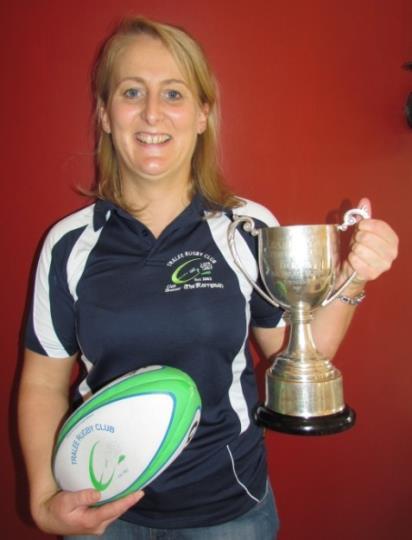


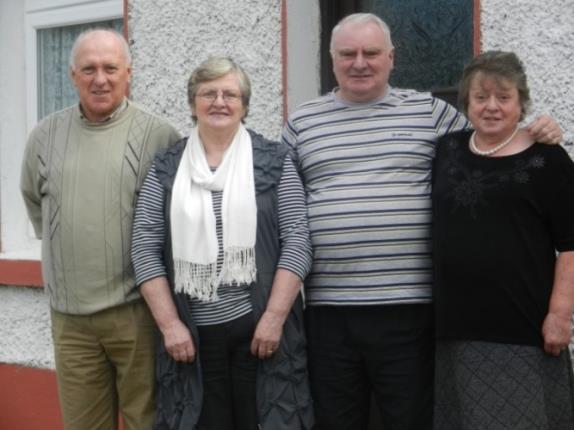 At the 2014 Local Election count in Limerick Joe Harrington celebrates with the three successful Anti Austerity (AAA) candidates and raises the hand of Cian Prendiville whose Great Grandmother, Mary Ann Lyons, came from Knockalougha.
Eirn Lyons, Lyreacrompane, an All Ireland winner with Tralee RFC Women’s Div. 2 team in 2011 and 2012 and right; Flor McAuliffe, Laccabaun & Denis O ‘Mahoney, Brosna repairing Lyre bridge.
Margaret and Jimmy Lyons at their Knockalougha Rambling House and on the right; siblings, Willie, Katherine, Thomas and Mary Murphy, at the old homestead
At the 2014 Local Election count in Limerick Joe Harrington celebrates with the three successful Anti Austerity (AAA) candidates and raises the hand of Cian Prendiville whose Great Grandmother, Mary Ann Lyons, came from Knockalougha.
Eirn Lyons, Lyreacrompane, an All Ireland winner with Tralee RFC Women’s Div. 2 team in 2011 and 2012 and right; Flor McAuliffe, Laccabaun & Denis O ‘Mahoney, Brosna repairing Lyre bridge.
Margaret and Jimmy Lyons at their Knockalougha Rambling House and on the right; siblings, Willie, Katherine, Thomas and Mary Murphy, at the old homestead
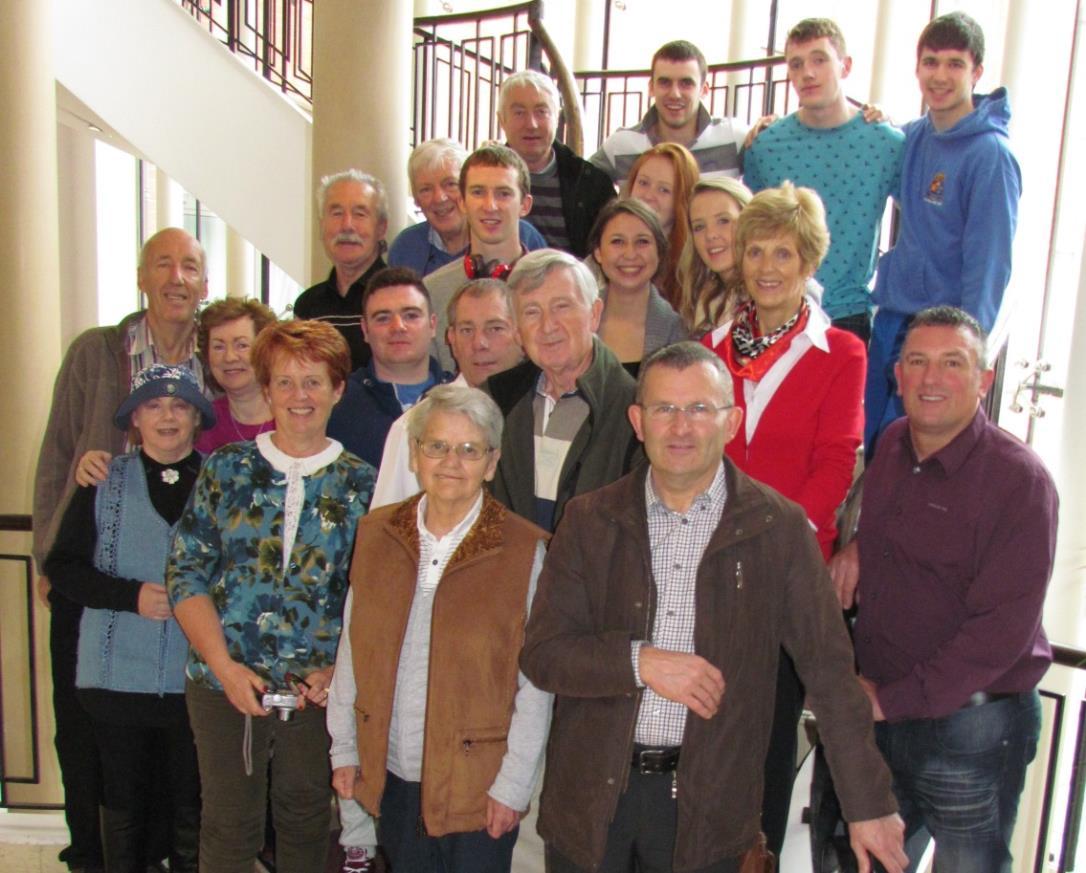


 2014IrishRamblingHouseTour GroupattheCrownMoranHotel, Cricklewood
Irish Rambling House Tour coach outside the Crown and on the right on stage Billy Donegan, Causeway, Chrissie Roche, Limerick and Murt Collins from Knocknagoshel and Clare
We met Hugh Callaghan, one of the Birmingham Six, at our Camden broadcast in 1998
2014IrishRamblingHouseTour GroupattheCrownMoranHotel, Cricklewood
Irish Rambling House Tour coach outside the Crown and on the right on stage Billy Donegan, Causeway, Chrissie Roche, Limerick and Murt Collins from Knocknagoshel and Clare
We met Hugh Callaghan, one of the Birmingham Six, at our Camden broadcast in 1998
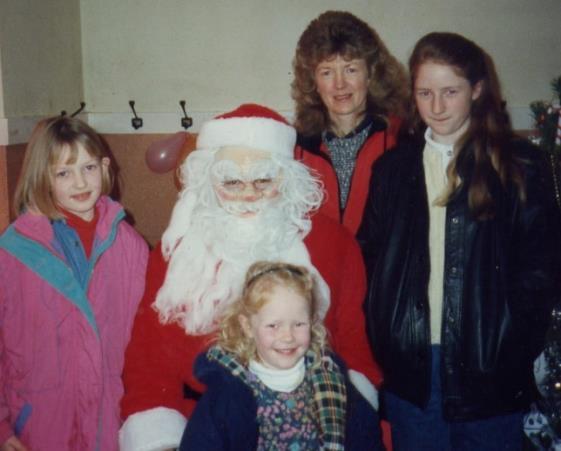
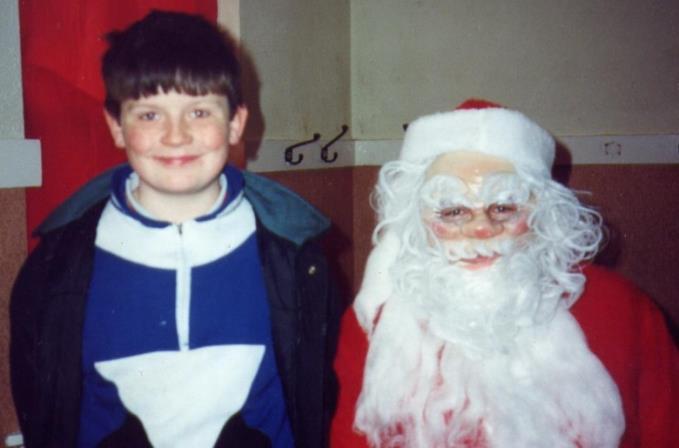

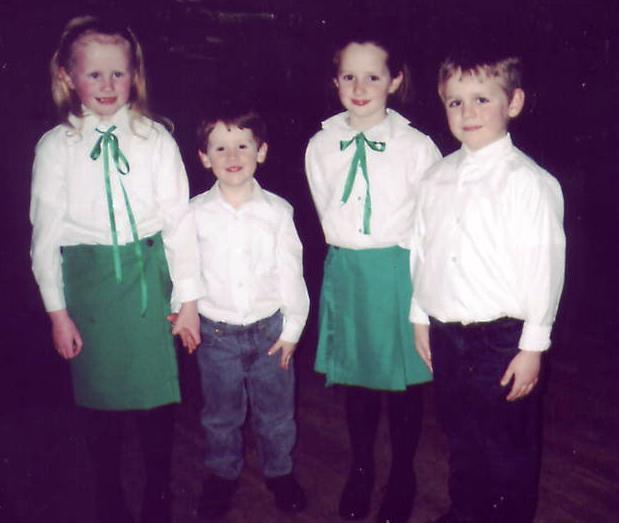

 VisitingSantaatLyreSchool someyearsago; Left, TheQuilterFamily, Toor,Duaghandontheright, JamesKeaneLyre
Front;CharlotteHannon, EileenandChristina Long, AnnGlessonBack;EilishDillon, Emma Leane, EmmaJohnsonandAmandaCarmodyand ontheright;SonyaHannon, Christopherand JenniferCarmodyandShaneLeane atadancingcompetition
VisitingSantaatLyreSchool someyearsago; Left, TheQuilterFamily, Toor,Duaghandontheright, JamesKeaneLyre
Front;CharlotteHannon, EileenandChristina Long, AnnGlessonBack;EilishDillon, Emma Leane, EmmaJohnsonandAmandaCarmodyand ontheright;SonyaHannon, Christopherand JenniferCarmodyandShaneLeane atadancingcompetition


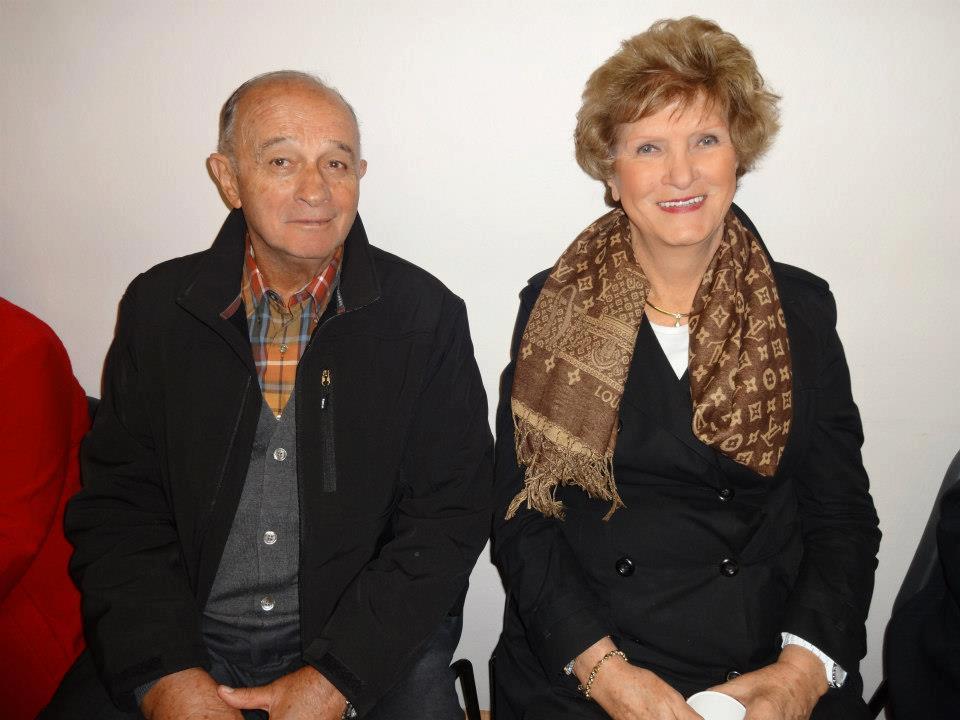
 EileenSheehy, IvyBridge andJoanieKennelly, Rathea, andontheright Tom O’Connor, Lyre andMikeConnellBallybunion.
EileenSheehy, IvyBridge andJoanieKennelly, Rathea, andontheright Tom O’Connor, Lyre andMikeConnellBallybunion.
I received this e mail from a lady listener in Wales who is a regular fan of all my programmes. It came after the programme I recorded at the Dan Paddy Andy Festival. Thought you might like it.
Best Wishes and keep up the great work.
HelloWeeshie,
Many thanks for your top column, a real education for me about our football; you have such a vast wealth of knowledge. Good luck to the boys on Sunday; will be listening in. Well done Weeshie. Hope your book is goingwellforyou!!
Enjoying conversation all about Lyre, sounds like a great spot, lovely folk, love the name, it is mythical. Kay tells the history of the festival lovely. Fr Moore singing a great song. It was a nice touch that your good self was included in the song. Well done. Joe Quill’s memories are great; so nice dedicating the cup in memory of Con RIP. Dave is doing good work training the younglads. Goodlucktoall.
Sean is another lovely Lyre man. William talking about his boxing career, a nice young man, love when so many young folk say PG and TG as William did, Only in Ireland, Weeshie and for that I say Thank God. And then Kieran talking about all things football with interestingthingstosay.
Now John 'The Memory Man’ Neville. I loved your story Weeshie about the day he gave you the big bag of programmes. Poor 'auld John; not been able to keep them. However they went to

a good home with you Weeshie! John is good fun and nice with it. Love his accent; that is unusual to me. It would be great to have an hour long ‘In Conversation’ with him!
Father Pat is a lovely priest. He too would make a great guest for ‘In Conversation’. I like Weeshie the way you always refer to the clergy as Father, also to the nuns as Sister. I do not like the current trend of calling nuns or priests by their christian names.
Martin is doing great work as always. I recall hearing him on Terrace Talk. This song is fantastic, lovely wordsand so lively to bring ‘In Conversation’ to a close. Well done Weeshie on a very entertaining programme and the great company. Good work by the team. Enjoyed Terrace Talk; you were flying.
Phil
JohnNevilleRIPLyreacrompane is an area comprised mainly of low mountains, bounded on the westbytheStacksMountains and on the east by the Glanrudderies. The land is mainly comprised of blanket bog, with very little arable land. The bogs in the area were formed about 3,000 years ago by the accumulation of rotting vegetation and an ample supply of water provided by the lovely rainfall on at least 240daysperyear.
For hundreds if not thousands of years these bogs have been used as a readily accessible source of domestic, and at times, industrial fuel. The turf was harvested by hand until the 1930’s when the Turf Development Board moved intothearea andmechanised production. In this project I hope to give an account of the methods used to harvest the turf, and to show the importance of the harvest for the local and national economy, especially with the shortages of coal and other fuel caused by the outbreak ofWorldWarTwo.
The Turf Development Board later became Bord na Móna which played an immensely importantpartinthe effortto produce fuel and will feature in a major way in this account.
Turf had been cut in the bogs of Lyreacrompane long before the Turf Development Board started its operations there in 1937. By and large, the turf was cut by local families for domestic heating and cooking, but some was
produced for sale in the surrounding towns of Listowel, Castleisland, Abbeyfeale and Tralee. It was transported to these towns on carts drawn by horses or donkeys, and sold door to door or by prior arrangement. The turf was cut by sleán and stacked in pyramid shaped heaps to dry. Because the peat was not compressed it had a very high water content, and took a long time to dry. The pyramid shaped stacks were ideal for this purpose. When they dried out the sods were bigger than the machine cut sods, which were to come later, and because the turf was not compressed it burned more quickly and less efficiently.
In the 19th century, most of the land in Lyreacrompane was owned by Lady Burgersh, (the Locke Estate) with some of it been leased to local farmers. A very large proportion of the land was bog. In the mid 19th century most of the land was acquired by Thomas Hurly, who became known as ‘The Landlord of Lyreacrompane’. He leased land to local farmers and they in turn sub let parcels of land to others. In this way many of the local people had access to a patch of bog where they could obtain fuel for cooking and heating.
poorest families to have a bit of heat at least. In addition to this turf was sold by the sod in towns which allowed people who could not afford to buy a load to buy a small amount.
During the mid 1930’s there was an economic war in progress between Britain and Ireland. There were large tariffs on Irish goods being imported into Britain and the Irish government had placed a large tariff on British coal. The Fianna Fáil government which came into power in 1932 wanted to reduce dependency on British coal and decided to take measures to increase turf production. They set up a semi state organisation, The Turf Development Board in 1934 and that body held their first meeting in July of that year. They sent deputations to peat producing countries such as Germany and Belgium to study their methods and look at the machinery. By 1937 they had acquired three bogs for development, one of these was Lyreacrompane. By 1938 it was obvious that there would be a major war in Europe and the government was even more determined to increase the production of turf. The supply of coal coming into the country had dwindled almost to a halt. From 1941 no coal was coming in and urgent action was required to rectifythesituation.
It was a tradition here as in other places of Ireland for sometocutturfto beleftout on the bog for poor people who did not have a section of bog themselves, or could not afford to buy it. In this way it was possible for even the
The government charged County Councils, UDC’s and District Councils with responsibility for increasing the supply of hand produced turf and gave them compulsory powers to ‘acquire, work or let turf banks’ to promote the production of hand cut turf.

By that time the registration of privately owned vehicles had ceased due to the war and consequent fuel shortages so little or no construction or repair work was being done on the roads. The men who had been engaged in that work were redeployed as bog workers. A meeting of the local authorities was addressed by the Taoiseach Eamon DeValera where he stressed the importance of increasing turf production and a few weeks later they were given increased powers. These included the power to buy and sell turf and to ‘borrow without limit for the production of turf’ and to drain contiguous lands. The Turf Development Board had responsibility for distribution and transport of the turf and for the production of machine turf.
When the Turf Development Board opened up the bog in Lyreacrompane in 1937 on 650 acres, bought at a cost of ten shillings an acre, they imported turf cutting machines from Germany. They brought in three Germans to work these machines and to instruct Irishworkersintheiruse.
Three cottages were built especially for them. These gentlemen were Herr Kraull, who only stayed four months, Carl Guttheim who wentback toGermanytojoin the army at the outbreak of world war two and Harry Starken who settled down in Irelandandmarrieda woman from Offaly. One of their sons later worked on the bog in Lyreacrompane. Initially three local men were also employed on a full time basis, this later rose to about fifteen.
During the harvesting season approximately five hundred casual workers were employed in the bog including many travellers, or tinkers as they were known then, andunemployedpeople from all around the area. Many farmers worked there during the harvesting to supplement their income. The machine used to cut the turf was called a Bagger, a German word, which has nothing to do with bags. This machine was huge, weighing more than 40 tons, and it moved across the bog at a rate of about l60 metres an hour. It exerted a downward pressure on the bog of only 2 pounds per square inch, This machine scooped up a large area of peat, macerated it, and compressed it before extruding it onto the ground likea massive sod of turf 54 metres long. The peat was then cut into individual sods about a foot long, by revolving cutting wheels on the machine to later be stacked manually by the harvesters. This was very hardwork.
Despite the light footfall of the Bagger, precautions had to be taken to prevent it from sinking into the soft ground. This was done by manually placing railway sleepers in the path of the machine as it moved. When the machine had passed over the sleepers they had to be manually extracted from the ground where they would be partially buried by the weight of the machine. They then had to be placed in the path of the Bagger once more. This was very hard physical work, and continued 24 hours a day during the harvesting season The procedure was known as planking. Pay and working conditionsonthebogwere
very bad and there were several industrial disputes. In one strike on the Lyreacrompane bog a midnight raid was staged by the strikers, and machinery wrecked to make the strike moreeffective.
The peat maceration process wasnotnew. Forhundredsof yearsitwasdonebyhandor foot. It entailed compacting the peat by pulping, then walking on it to remove the water before forming it into sods. This process gave the turf a higher calorific value than the hand cut sods and was in widespread use on the continent. During the l9th century machines were developed in Germany and Sweden to harvest peat, macerate it, extrude the macerate peat and cut it into sods. The first of these machines was produced in Sweden in 1845, and first used in Ireland in l903. The Department of Agriculture at that time conducted experiments with these machines in Counties Cavan, Westmeath, and Limerick. ln the mid l9th century macerated peat was used to manufacture briquettes in Counties Kildare, Laois and Galway but the venture was not a commercial success. The process was later successfully developed and marketed by Bord Na Mona with the briquettes giving a highercalorificvaluethanthe machineturf.
I interviewed John Nolan who worked for Bord Na Mona in both Lyreacrompane and Carrigcannon bogs. As a child, John helped his father to cut and stack turf in Lyreacrompane bog. His father had only one arm due to an accident and needed as muchhelpaspossible.
When the Turf Development Board commenced operations in Lyreacrompane the ground was cleared manually, they only started using machinery to clear it at a late stage. John actually started work on the clearing operation in the Carrigcannon bog, even though this bog did not go into production until 1967. He then was moved to the Lyreacrompane bog where he worked as a locomotive driver. In the Lyre bog there was one main railway line which remained in place for the duration of the turf cutting operations there, and two branch lines which were lifted and moved to new locations as the area being harvestedchanged.
The locomotive which John drove was a Ruston, built by Ruston HornsbyatLincolnin England. During the course of their turf cutting operations nationally the Turf Development Board, and Bord Na Mona used between 350 and 400 locomotives, of different manufacture and specifications, and this subjectinitselfwouldmakea good topic for discussion and investigation. The loco motives pulled wagons into which the dried turf was loaded by hand. Theloco was then driven to a tip head where the locomotive was detached. The wagon loads of turf were then pushed manually to the end of the track on the tip head and the wagons were then upended, spilling the turf into waiting lorries for transportation away from the bog. The old tip heads are still standing in both bogs, but the railway tracks are long since gone.
According to John the tracks were lifted from the Lyre bog when operations switched to Carrigcannon in 1967, and the locomotive was moved there also. Altogether there
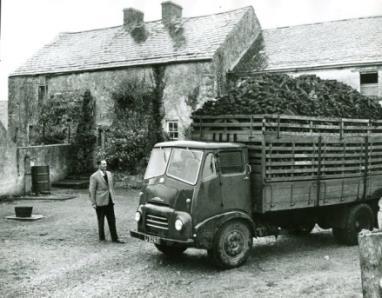
were about ten miles of track on the Lyre bog, and at one time there were two locomotives in use. The main line leading to the tip head is still visible but is now an access road with no sign of thetracks.
units of the army had been involved in bog development and in turf production in Lyreacrom pane. One of these was a new unit which had been set up partly as a means of providing employment for out of work young men from the age of sixteen years. They were used as cheap labour on the bogs. The other unit involved were known locally as Sappers and were probably Engineers.
Before the tracks could be laid the soft surface of the bog had to be drained, and trenches were dug 8 to I0 metres apart. Where there were two tracks the trenches were l5 metres apart. The tracks were laid on a bed of milled peat, with a layer of ballast on top. The sleepers were 2 metres long and the rails were 9144 millimetres long (30 feet) and each length weighed 540kilos. Initially, these rails were manoeuvred into place by men using drag lines, and gripped by a specially designed rail clamp on the sleepers. Later, a special machine was developed by Bord Na Mona, which took thehardlabour outof thejob and made it much faster.The milled peat trains had l4 wagons, each l6 cubic metres and carried 75 to l00 tons of peat. When turf production was wound up in Lyreacrompane in l964, the train were moved to the Carrigcannon bog a mile or so up the road where the tracks were re laid but were not as extensive as in Lyre, as Carrigcannon is a smaller bog. There was only one locomotive deployed to Carrigcannon.
JohnNolantoldmethattwoThroughout the country army units worked on the bogs to provide turf for the army. These units included Infantry, Cavalry, Signals, Engineers, Medicals, Supply and Transport, and Marines. They cut turf throughout the summer months using all the men they could spare. This continuedrightuptol946.
The army unitswere based in a temporary camp at Renagown about a half mile from Carrigcannon. John Nolan could not remember exactly where their camp was, but he thought it was near Dan Paddy Andy’s dance hall on the old section of the Castlelisland Road which has now been bypassed. I spoke to Kevin Somers who had worked for Bord na Móna on a part time basis, and later went to work in the forestry which was planted on Lyreacrompane bog when turf production ended there. Kevin told me that the camp had been just a few hundred yards away on the Tralee Road. I went to see the site but found no evidence that the camp had ever been there. This is not surprising however as the camps were woodenstructuresandtents.
The Construction Corps were involved in the preparation anddrainingof thebogsprior toproductionandinitially this was all done manually. The
work involved in preparing a bog for machine turf production began with a survey to determine the depth and type of peat in the bog, to decide on the locations of drains, work shops, offices etc. and to erect these buildings on solid ground. The drains had to be dug gradually, usually in five stages, otherwise the peat did not dry out quickly enough and the ground was too soft. This was a real problem when machinery was introduced to dig the drains and the German operators insisted on digging them in one pass as practised in Germany. This caused the machines to sink to the soft peat on numerous occasions until they accepted the advice of their Irish colleagues who were more familiarwithIrishconditions.
(There is more needed to confirm that the Construction Corps were with Bord na Mona in Lyre bog. It is not clear on which bog the Corps worked Editor).
The first machine used for digging the drains was a Cuthbertson plough, but this machine was too heavy and had a tendency to sink into the ground and alternative methods had to be devised. A semi automatic machine called an Ackerman was used to make the drains deeper and produce turf at the same time. It straddled the drains and was hand fed with peat which was shovelledintoahopper.
A 60 yard long collector was later used for collecting the sods, and the driver was paid a bonus, so he went as fast aspossible.
The sods had to be loaded manually onto the collector with beet forks, and this was back breaking work. To get a break the workers often
sabotaged the machine by jamming sods of turf into the gears. The job was eventually made easier by the introduction of better machinery.
In 1949, C.S. Andrews told the executive of Bord na Móna that he would like to utilise the cutaway bog when the peat production was completed, but no definite decision was made, but he suggested forestry as an experiment. Discussions took place between Bord na Móna and the Forestry Department about who should plant trees on the Lyreacrompane cutaway bog. It was decided that the project would be undertaken by Bord na Móna and they planted some spruce and pine trees at an altitude of 800 feet. This planting was quite successful and showed that forestry was viable after all the bog was cut out. The experiment has not been so successful in some other areas however, and natural regeneration is seen as a better option for many of the bogs in the west.
When production ceased in Lyreacrompane, all the equipment and personnel were transferred to the bog at Carrigcannon about a mile and a half away. Since much of the preparatory work in Carrigcannon had already been done at the time Lyreacrompanewasopened,
it was easier to start up in the new bog. While Carrigcannon was a smaller bog than Lyreacrompane, the set up was similar. The rail locomotive and wagons were moved there along with the tracks and a tip head was built, similar to the one on the other bog. There was a main line and two branch lines which were lifted and shifted as required. When production moved from one area of the bog to another, the tracks were moved also. Near the tip head there was a turntable for turning the locomotive or wagons around but this was rarely used. Some of the machinery for the bog was driven from the old location, making its own roadasittravelled.
In 1971 the cost of turf production in Carrigcannon was about £6.15 per ton, and the price received for it was just over £4 a ton. The operation was uneconomic, and closure of the bog was again discussed in 1976. The bog was kept open because of the social implications of closure during a time of economic recession, and because it was thought that closure would alienate the many customers of Bord na Mona in the surrounding area.
Bord Na Mona ceased production in Carrigcannon in l984. A local man, John Canty, produced turf there for a few years afterwards, but production there has now ceased. The whole area is now a Special Protection Area, with special emphasis on the Hen Harrier. The railway lines and rolling stock were moved to bogs in the midlandswhen BordNa Mona pulled out, and there is no remaining sign of the tracks. The road where the main line was situated is still there and thetip headisstillstanding.
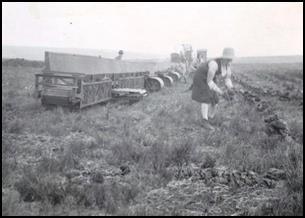
Lyreacrompane Bog was the second of three bogs acquired by the Turf Development Board in the latter years of the 1930s and, as such, played an important part in developing methods, ideas and machinery which was used in the further development of the large number of bogs later acquired and worked by BordNaMona.
The production of turf during the National Emergency in World War Two was very significant as no coal came into the country after 1941. In later years the turf production retained its importance, asitwasusedas one of the principal fuels for the production of electricity by the ESB. Turf was used to keep factories going during the Emergency, and in the years afterwards when there were shortages and rationing of most imported goods. It was used with some success to power rail locomotives but was not nearly as efficient as coal. The output from the bog averaged about 10,000 tons per annum for the duration of the operation there and altogether more than a quarter of a million tons were produced. Carrigcannon bog, which was a much smaller, produced 3000 to 4000 tons per annum.
The importance of the bog harvesting to the local population is inestimable. Lyreacrompane was a very poor area with very little arable land, and no industry. The arrival of the Turf Development Bord / Bord Na Mona in the area provided about15full timejobs, anda Further 500 temporary jobs duringtheharvestingseason. This had a dramatic effect on the incidence of emigration: An article in the Lyrea crompane Journal points out
that during that period the local GAA club was able to field five teams in the local league. There is now no club in Lyre the club having been incorporated with Duagh and players have to travel about ten miles to train.
There was little or no interest in the ecology of the peatlands during the early years of the Turf Board/Bord na Mona but in 1949 the Royal Irish Academy published a report by Kurt Jannsen on Irish Peatlands Stratigraphy and this was to kindle a mild interest in the subject.
The following year executives of Bord na Mona attended a meeting in London of the World Power Conference and this provided a means of exchanging information on peat production. This lead to the establishment in Ireland the following year of the International Peat Congress, not by any means a conservation group but they invited guest speakers to their meetings and one of these, Fr JJ Moore, gave a talk on the ecology of the bogs and later played an important part in the establishment of the Peat lands Conversation Move mentinthiscountry.
These days there is a much keener interest in the subject and rules brought in by the European Union have led to the passing of laws which are designed to protect the remainingbogs.
To a great extent this interest in the ecology of the bogs has come too late as many of them have been cut away. There are however schemes in several parts of the country to preserve and
promote an interest in what remains of the bogs and turf cutting may soon be a thing ofthepast.
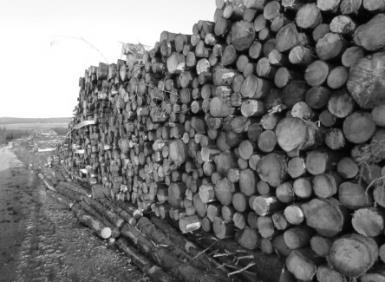
Many of the trees in Lyreacrompane bog have been harvested, and much of the area is now quite desolate looking. Essentially the habitat in that part of the bog has been destroyed. As you walk further along the old main line the picture improves a little, and there are quite a lot of trees, but only conifers. You can get a good view of the area on the Ordinance Surveys of the areaontheinternet.
Carrigcannon Bog, on the other hand, looks quite well. The peatlands ecology has been largely destroyed by the turf cutting, but the cutaway has been left unplanted and has been repopulated by many of the animals that lived there and plants which previously grew there. In this case natural regeneration has been a nicer, if not better, option than the forestry which has been planted on the cutaway inLyreacrompaneBog.
I have seen a small quantity of turf cut on this old bog in the past few days, but essentially the bog is worked out and it is most unlikely that there will ever be any large scale turf production in the area again. The Hen Harrier will not be disturbedtoomuch.
D McDonnell prosecuted John Nolan, Carrigcannon for striking Constable Sweeney with a stone on the head. Mr McDonnell in opening the case said that, unfortunately, his principle witness, who actually saw the defendant throw the stone, was away on temporary duty. He would, however, call Constable Sweeney, the other witness. Constable Sweeney said he was on duty in Knocknagoshel on the 15th of August, 1914. On that evening he was in CD O’Connor’s back yard where a row was going on. While he was trying to separate the men he was hit with a stone on the head. Turning around he saw the defendant standing alone. He ran after him and challenged him. Defendant denied firing the stone. It could not have been any other person. Mr
McDonnell said that the other Constable who was away actuallysawthestonefired.
Defendant said he was at the dance in the hall and was coming away when he saw a row and stones being fired. He hurried away and when he got to the front door he was challenged by Constable Sweeney. He did not fire the stone. The Constable said he did not arrest Nolan owing to the attitude of the crowd.
Mr. S. Prendiville We must adjourn the case for a month for further evidence; the other Constable may be back bythen.
Before the same court Constable Mulligan summon ed Con Egan, Lisheenbawn for ill treating an ass by striking it with a stick. Defendant, who said he had to hit the donkey to make it go, was fined ten shillings andcosts.
Sir Arthur Vicars of Kilmorna, Co. Kerry, obtained £5,000 damages before a London jury in the action which he brought against the ‘London Mail’ for the “vile and unfounded” charges which it made against him in connection with the mystery of the Castle Jewels. Sir Arthur was half brother of The O’Mahony of Kerry and of Mr. George Gun O’Mahony DL of Kilmorna. The names of Lord and Lade Hadde, the son and daughter in law of Lord and Lady Aberdeen, were also mentioned in the libel, but this action has completely vindicated them and proved that they were “the victims of a mean and contemptible attempt to besmirch their names”.
That £5,000 pay out was worth just over €500,000 in today’s terms.
 ‘Ballymaclimbers’ climbingCarrauntoohilJune2, 2013
‘Ballymaclimbers’ climbingCarrauntoohilJune2, 2013
On the Northern slopes of the Stacks, as they undulate gently down to the Smerlagh river, is the little group of townlands, which make up Ratheaecclesiasticaldivisionof Lixnaw Parish, formerly the Parish of Kilshinane. Kilshinane is derived from the Irish, 'Cill Sionin', the church of Senan, a saint, venerated in this part of theParish.Fromhismonastery in Scattery Island, St. Senan paid regular visits to this location to Christianise and endoctrinise.
Here in Rathea, we have the lovely little church dedicated to our Lady of the Assumption. Here too, just a quarter of a mile away is the school building, Scoil Mhuire built in 1875 and first opened in October of that year. Translated from the Irish word Rath Aoidh, meaning the Fort of Hugh, it seems likely that a chieftain named Hugh, built and lived in a fort (now demolished), in Kirby's field in Rathea. Due to the manner in which Kirby's fort was constructed and the underground tunnels which apparently connected it to other forts in Denis Kennelly's of Gortacloghane and Michael Galvin's in Rathea, indicate that these settlements belong totheCelticPeriod.
The townlands from which the children came to Rathea school were locally situated and interestingly named. They are Glenderry, the glen of the oak wood; Bromadera, the bron of the hounds; Knockaclare, the hill of the plateau; Gortacloghane, the stony garden; Behins, the place of the little birch trees; Fourhane, the cool spring; and Toornageehy, the tower of the wind
national school of Rathea was built, some local parents got together and set up a school in Pike in 1835. A Mr. John O'Connor was the first teacher in Pike school, which had an enrollment of about 45 pupils. He was succeeded by Michael Lynch, father of Mossie who played a major part in education in Rathea for many years. The school at Pike later became a dispensary and Dr. Nora O'Sullivan of Lixnaw held a weekly clinic there up to the mid fifties. James Keane provided the site for the national school in Rathea. The school was built by local tradesmen, using stones and mixed concrete. The walls are over three feet thick and have withstood nearly 120 winters. The building to day is in reasonably good condition, which pays a tribute to the workmanship of all those years ago.
The school windows face the Smerlagh to the North East. The front or the sunny side is windowless, which is rather contrary to present building methods. The idea may have been to block the view of the roadway, at the South West, to enable the pupils to concentrate on their studies, without outside interference. Finance for the building was provided, one third by local contribution and the remainder from the office of Public Works.
When officially opened on the 1st October 1875, the school consisted of two rooms, one for the boys and one for the girls. Master Mickey Lynch, was the first teacher in the new school. His experience in Pike school may have been a factor to his appointment in Rathea. However, it was the general belief at the time, that the old native teachers or hedge schoolmasters were superior to the national teachers of the new regime. In 1854, in a commission report ontheworkingof thesystem
of national education in Ireland to the House of Lords, a Dr Rowan stated that “national teachers of the new Regime are inferior in capabilities to the old hedge schoolmasters".
To refer back to the segregation of the boys from the girls in school and in the school yard, one must remember that in that early period boys and girls up to the age of sixteen attended national school. The powers that be, who were the bishops, probably believed, whether in wisdom or otherwise, that the moral growth of the schoolgoing generation would benefitfromstrict segregation.
At the beginning of this century Mrs. Kirby of Ballyduhig was principal of the girls’ school. She was assisted by Madge Cronin (nee O'Connell) of Toornageehy. Mrs. Kirby came by donkey and cart and her donkey was untackled and cared for by Jack Whyte until school was over. Mrs. Kirby was replaced by Mrs. Greaney in 1920. Madge Cronin continued until 1934. Mossie Lynch became principal of the boys school in 1912. For a period around that time Master Buckley, better known as 'Tom the Master' from Banemore, spent some time teaching in Rathea. When a vacancy occurred in Dromclough, Tom Buckley left Rathea and was appointed to Dromclough.
Assistant to Mossie Lynch in those early years was Julia Ciss O'Connell, who married and resigned her post. Julia was replaced by Pidge Pierce, who later married Eddie Scanlon of Market St., Listowel. Mossie spent 47 years as principal. When amalgamation took place in 1939 Mossie became principal of the new mixed school. He retired in 1959, aged 68. He enjoyedhisretirementuntil his sudden death at the Munster Final in Cork, in July 1967. Mossie was indeed a
very fine teacher, who had a particular love for his native language. In a survey done by Connradh na Gaeilge in 1919, to assess the standard of Irish in national schools in Kerry, Rathea was one of the top three schools in the county, along with Lixnaw convent and Lisselton. This was indeed a wonderful achievement, as many of the schools assessed
were in the Gaeltachts of West and South Kerry. This survey, known as 'Searchlight', was chaired by the late Terence Mc Sweeney,LordMayorofCork. From the mid twenties to the mid forties,Ratheaschool staff varied from two to four teachers. Among these teachers, were Miss O'Connor (sister of Mike O'Connor), publican in William Street,

Listowel. Miss Geary from Limerick, Miss O'Connor from Duagh (The Noble Connors) and a master O'Neill who taught for a short period in 1929.
My mother, Peggy O'Shea, transferred from Ballybunion Convent in 1933 and taught in Rathea until 1936. She then joined the staff in Dromclough
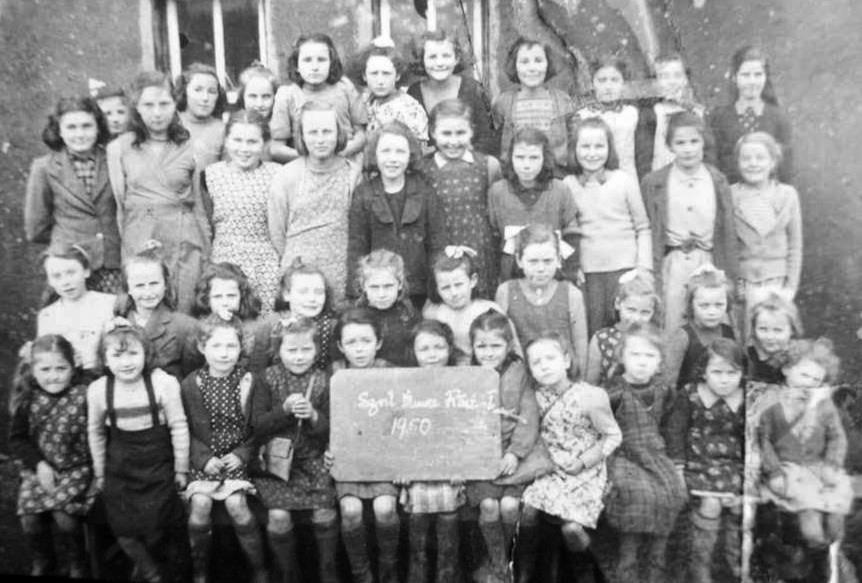 Rathea Boys and Girls class of ’55. Can anyone put names to the faces?
Rathea Boys and Girls class of ’55. Can anyone put names to the faces?
national school and in 1937 married my father Barth. Rohan, who was principal there. Peggy O'Shea, was replaced by Peggy Galvin of Finuge. In 1945, Peggy married Mossie Hayes of Lissahane and thus ended her teaching career. Mrs. Greaney (nee Weir) spent twenty six years in Rathea and when she retired in 1946, Noelanne Kelly (nee Lyons) became assistant to Mossie Lynch. Numbers were on the decline, so it was around that year that the staff in the school was reduced to two.
In 1959, on the retirement, of long serving and popular educator, Mossie Lynch, Kieran Rohan was appointed as principal and in April 1964, I replaced my brother Kieran. When Mrs. Kelly retired in 1969, Nuala Lynch (nee Galvin) became my assistant. When Nuala moved to Lixnaw in September 1978, she was replaced by past pupil Mary Barry Trant. Due to falling numbers, Mary was put on the panel in 1989 and was later appointed to Drumnacurra national school, Causeway. Rathea was now reduced to one teacher status. At a meeting of the Bord of Management and parents in the summer of 1990, it was decided to approve a Department of Education suggestion, to close Rathea and amalgamate with Drom clough. It marked the end of an era which had lasted for 115 years. The school was officially closed on 30th June 1990.
Department officials visited the school, usually unannounced, on an annual basis. Bob Little was one of the first inspectors in North Kerry and he had a reputation of being very strict on both staff and pupils. He was followed by Bob O'Connor, whose reputation was better. From 1945, Mr. Nash ruled the roost and was probably the
last of the fixed inspectors. However it was Department policy to be tough and unyielding, so these inspectors were just doing their duty, in accordance with Department directives. When the policy changed in the late fifties, more human inspectors came to help rather than cause panic.
Rathea school has been a stepping stone to the religious life for many of its past pupils. Among them were the Keanes, Frs. Paddy, Jerry and mother Gabriel. The Lyons Frs. Adrian, Paddy and Sr. Patricia; The Galvins, Frs. John, Michael and Paddy; The Stacks, Frs. Joe and Mick; Fr. Mattie Dillon (now U.S.), Sr. Philomena Mc Elligott, Srs. Alice and Teresa Trant, Fr. Danny Stack and Fr. Eamonn Whyte, son of Ned and Mag, who was sacristan for many years in Rathea church.Inthesummer of 1993 this remarkable tradition was continued when Fr. Jerry Keane was ordained in Killarney and was appointed to theCuracy inWaterville.
The parish priest was always school manager and was responsible for appointments, maintenance, closures and any major decision making. Fr. Larkin was one of the first managers of Rathea and he was followed by Fr. Dillon, Fr. N. Browne, Fr. A. Molyneaux, and Fr. J.J. Browne. Later when Boards of Managements replaced the Managerial system, the curate in Irremore became the chairman of the Board. These included Fr. Ml. O'Connor, Fr. D. Quirke, Fr. A. O'Callaghan, Fr. Ml. O'Leary, Fr. D. Breen, and Fr. R. Kelliher.
During my 26 years association with Rathea, I felt privileged to be among so magnificent a community. I found the parents gracious in the extreme. The pupils were highly intelligent, considerate
and sincere. All my memories of Rathea school I regard as souvenirs of happy days. Sadness too enveloped the area, when Sean Larkin, Margaret and Katie Trant, and Francis Dillon left us in the prime of their gentle lives.
Gone too is Jett, who held a debatable reputation in the locality. Even the walls of Springmount could hardly containhisspritely spirit.
1916 was indeed a bleak year in Rathea. Scarlet fever hit hard in late January, resulting in school closure for the whole month of February. In the weeks following the rising, school attendance was very low, which indicates the sad atmosphere which prevailed following the surrender and execution of Pearse and his comrades. On the subject of the aftermath of the 1916 Rising, I would like to mention an incident which took place in Rathea on Christmas day 1919. In those years Mossie Lynch resided in a house, near where the grotto is now situated. A lorry load of Black and Tans were travelling from Listowel to Castleisland and they stopped at Lynchs. They entered the house in a boisterous mood and were it not forthe Lynch family having some Christmas drink in the house which was put to the Tans' disposal who knows what theoutcomemightbe.
This istheendofmy story.For any inaccuracies and errata, I apologise. For those whose names I mentioned and have departed this life, I pray for them. For those who are left behind, I pray too, because you are a wonderful people. Finally, let me quote Peggy Galvin Hayes, reflecting on Rathea, “The children are incredibly brilliant and the people have a grace and sense ofhumour, foundnowhere else inIreland.Itmustbetheair upthere".
I moved to Lyreacrompane in July 2013. I was eight. Moving from Tralee to Lyre was very hard, because we had so much stuff. When my mom was young she also lived in Tralee and moved to Lyre when she was six years old. She was young like me.
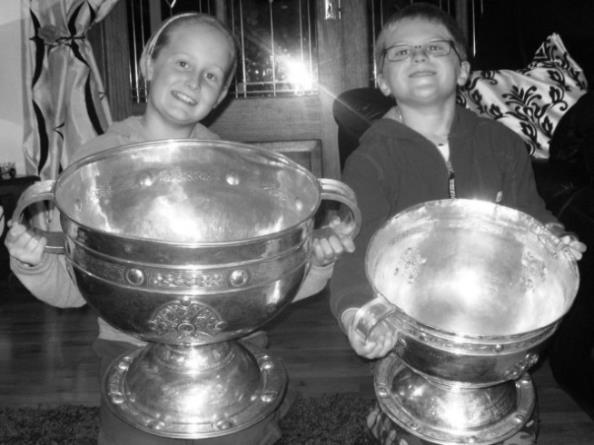
I like Lyre because it`s quite peaceful and you can take lovely walks. My brother’s name is Odhran. I take my pet puppy ‘Higgins’ for lovely walks too. To describe Higgins in one word would be hyper; he`s always jumping. I love Higgins. If we hadn`t move to Lyre we wouldn`t have gotten Higgins. As well
as Higgins I have a Shetland pony called Danny. I ride him a lot and jump him a lot too. Oh I forgot to mention about my guinea pigs, they are so soft and cuddly. Their names are Fluffy and Harry. I got them on Christmas morning from Santa. They are now threeyearsold.
There are so many turbines here in Lyre. When I stand beside them it reminds me of Jack and the Beanstalk story. My Nan and Granddad havea hammock and a trampoline. We play on them a lot. You can also pick a lot of blueberries at my Nan and Granddads’. I like going to my other Granddads farm in Lyreacrompane. I love playing with the calves and I help feed the cows, calves and horses. The horse’s
names are Bán and Beauty. Bán is Beauty’s mother. I lovemyGranddadsfarm.
I go to an Irish School called Gaelscoil Mhic Easmainn in Tralee. I was going there before I moved to Lyreacrompane. I have to travel half an hour to get to school every day. Every Tuesday I go to Scouts in the Lyre Centre. I just started with them in September. It’s great fun. I went to Tralee Museum. We studiedthe past two million years and we dug up things from the past. On Tuesday 11 of November 2014 I got invested in the scouts and that means I am officially arealscoutcub.
 IloveLyre.
IloveLyre.
There was a large crowd at the 1954 Healy Cup Final between Carrig Sarsfields and Smearlagh Rangers. It was played in good weather in October and the football was as good. Smearlagh Rangers were doing well but, with time running out D. Naughton gave Carrig the lead with a goal. Smearlagh were then awarded a fourteenyardsfreebut,as
it was been taken, a Carrig player kicked away the ball! In protest the Smearlagh Rangers walked off the pitch. At that point Carrig Sarsfields wereapointup.
The Carrig Sarsfield lineout that day was; C Collins, Willie Falvey, W McCarthy, John Nolan, M McKenna, C Starken, J Donoghue, JJ Carey, J McKenna, A O’Connell, S O’Connell, T Hannon, D Naughton, Ned Somers and T Dillon.
The men of Smearlagh Rangers were; J Halpin, M Sweeney, P Sullivan, Pat Brosnan, J O’Halloran, B Buckley, Jack Buckley, S Healy, Mikey Joe Costelloe, J O’Connor, P Tangney, J Bernard, M Halpin, L Nolan, JJ McCarthy. The match was refereed by DJ McCarthy, from farGlashnacree!
CaoimheandOdhranLyons LawlesswiththeSamMaguireandtheTomMarkhamCupswonby KerrySeniorsandMinorsthisyearandontheright members of the O’Connell family including Máiread, Mary, DerryandSeán.
Do you remember when North Kerry Landfill was first proposed? There were panic stations. Protests were organised and there was talk of “taking it to Europe”. It was easy to understand the concern locally. It was being proposed that North Kerry and indeed beyond would dump its rubbish in a hole (that would become a mountain) in our backyard! Some of the
warning came true the terrible smell that periodically emanated from the dump and some suspect that some problems won’t be confirmed for decades such as how long the rubbish, so well sealed, will take to decay. More like preserved say some! On the other hand the alarm about the runoff into local streams and rivers seem not to have materialised.
OvertheyearstheNorthKerry Landfill appears to have begun to be seen by local people as
an advantage more than a problem. When the closure of the Dump was announced it wouldn’t have taken much to rustle up a protest. (Was there ever, in the history of the world, a protest against the closure of a dump???) The dump had become very convenient for many of us and when the gates finally closed there was a feeling that we had lost a friend who had a lot of annoying aspects but who, in the end, should not be spokenillofinitspassing
On Tuesday night last, a large number of men, in woman’s clothing and their faces disguised assembled at the wood of Banemore and there proceeded east and west to the parish of Kilshinane and towards
that of Kilflynn. They visited every farmhouse where they supposed arms might be had and during the night they possessed themselves of 12 or 14 guns which they carried off. This unprecedented outrage has created much fear and alarm in this peaceful neighbourhood and

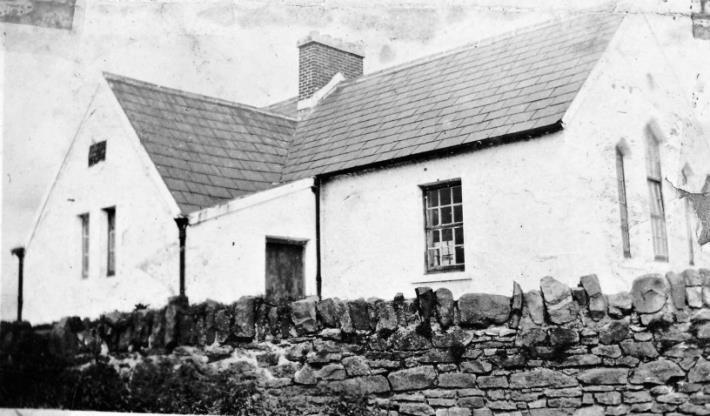
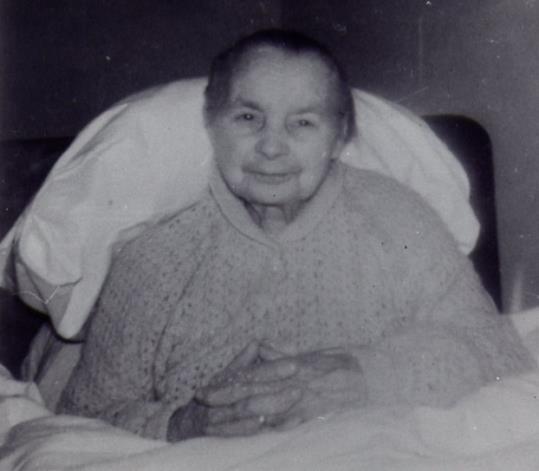
conjecture is busy to discover how these guns may be, hereafter, employed. The assassin has never, in this neighbourhood, met sympathy or protection and this fact leads to a hope indeed a conviction that the plundered arms will never be employed in such diabolical work.
 Thepassageoftime IslandannySchoolhouse.
Disturbance at Banemore. Tralee Chronicle Dec 4, 1847
Front:Billy Molyneaux(R.I.P.)JamesAhern, Billy O'Connell, Billy McCarty(R.I.P.)DanAhern. Back:PatAhern, TomQuillRIP,Neilus Hickey (R.I.P.)BertieEnright, TomMurphy, PatQuill
MaryNolan, Lyreacrompane, (nee O’Donoghue, from Rathea) grandmotherofMary(Nolan)Kelly, Lyreacrompane.
Thepassageoftime IslandannySchoolhouse.
Disturbance at Banemore. Tralee Chronicle Dec 4, 1847
Front:Billy Molyneaux(R.I.P.)JamesAhern, Billy O'Connell, Billy McCarty(R.I.P.)DanAhern. Back:PatAhern, TomQuillRIP,Neilus Hickey (R.I.P.)BertieEnright, TomMurphy, PatQuill
MaryNolan, Lyreacrompane, (nee O’Donoghue, from Rathea) grandmotherofMary(Nolan)Kelly, Lyreacrompane.
A short time ago the last of the rural shops in Athea parish closed down. This was the premises owned and run by Mick and Peg Reidy in Glenagore where a thriving business as a grocery store and petrol filling station had operated for several years. Previous to this there were several other rural shops throughout the parish, all doing their own amount of successful trading. These included Moran‘s shop in Toureendonnell; Scanlon's in Lower Dirreen; Vaughan's in Upper Dirreen; Dalton's and Higgins' shops in Glasha; Enright's` in Glenagore; Leahy‘s in Cratloe West and our own shop in Knocknagorna.
During the past twenty years or so all these shops closed down one by one. Some of these had been operating for decades, others for shorter periods, but all provided a valuable and convenient service for local people in the various townlands. In my native townland in North Kerry, Dromadda, which is part of Lyreacrompane parish, there were three shops in operation during our own time. McElligott's in Dromaddamore West had carried on business for generations but two other shops also operated in the townland after opening duringthe1950s Lyonsof Dromaddamore East and Cronin's in Dromaddabeg. There were also two shops in our neighbouring townland of Carrigcannon Nolan's and Doran‘s where
there was also a filling station and in Lyrea crompane itself there were two shops, Doran‘s which has long since closed down and Lyre Post Office where the Nolan family still carry on their business which includes a filling station. Further along the Duagh Road there was a shop in Glasnacree owned by the McCarthy family and another in Knockanebrack where the Nolan family carried on business. Just across the Knocknagoshel parish border from Dromaddamore East there were two shops in Tooreenard townlands, O'Donoghue's and Leane's. All the above mentioned have now closed down except Lyre Post Office. Thereislittledoubtthatthe end of the shops in country areas has been a factor in the rural decline that has escalated during the past fewdecades.
Some of the reasons why these rural shops went out of business were first of all the rates from which even the smallest shops weren't exempt. Then there were some of the nonsensical hygiene and other petty restrictions that have been imposed on every small business during the past couple of decades and, last but not least, the competition from the supermarkets - some of these not even Irish owned but branches of huge multinational chains which not alone have wiped out the rural shops but which also pose a threat to Irish owned supermarkets and smaller urban based shops and stores. In the country shopsofformertimesthere was none of the high
pressure salesmanship of 'sellbydate'or'bestbefore' lark that is evident in most food products that are being sold today. Yet, in those carefree days before all these Government and European restrictions started to rule our lives, who ever heard of an incidence of food poisoning from products purchased at a rural local shop. Never to my knowledge anyway but if it did occur it must certainly have been very rare. In those days, pieces of bacon could be seen uncoveredhangingfromthe rafters or hooks in some of the country shops, but purchasers never bother to enquire if this was hygienic or not because they had common sense enough to understand that when it wascooked(boiledorfried) itwasquitesafetoeat.The same applied to other meat productssuch assalted and pickled corned beef which was often sold directly out of the barrel. This was also the case with tinned foods which were not that plentiful in those days but which were nevertheless available in some shops. Nobody ever thought of questioning the shelf life of those products and one never heard of anybody getting sick after eating them. The same principle applied to jams, mar malades, biscuits, sweets, bakers' bread and other foods. It is well how some of us remember getting a dozen boiled gallon sweets for a penny in a 'thoseen' packet made from news paper cuttings at the local shoponourwayhomefrom school.
Not alone were rural shops open for business day and
night but, in many instances, they were also rambling and often card playing houses as well. In my own early days in Knocknagorna while we still operated a shop we would have a big gathering of local people every night who sat around the table playing cards or conversing


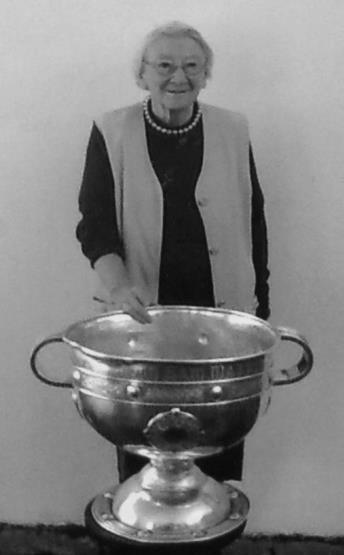
and telling stories around thefire.
But there's little doubt that rural Ireland has now become a very different scene. It is no longer a place where ramblers ramble to neighbours' houses and where singers rarely sing and whistlers seldom whistle in the great
outdoors. Yet many memories of our youthful frolics and of the fine people we knew in those far off days, many of them now gone to their eternal reward, still linger in our minds and we also retain a certain nostalgia for the rural shops which were once so much a part of the Irishlandscape.
MaiMangan(neeDillane),Knockalougha, GrandauntofAnthonyMaher, withSam andontheright BrendanMcKennaand BernieO'ConnellRIPintheearly60s LyreacrompaneNS1959/60 Front: Norrie Connell, Ellie Ann Sullivan, Ann Quille RIP, Joan Doran, Lizzie Nolan, Bridie Dillon. Back: Lulu Carmody, Catherine Canty, Norah Rose Doran, Angela Summers RIP, Eileen Keane, Bridie Hickey RIP.Harry Starken who kept all the turf machines in Lyreacrompane Bog in good working order for many years drove a Baby Ford (as shown in photo) with a registration numberofZ 6718.
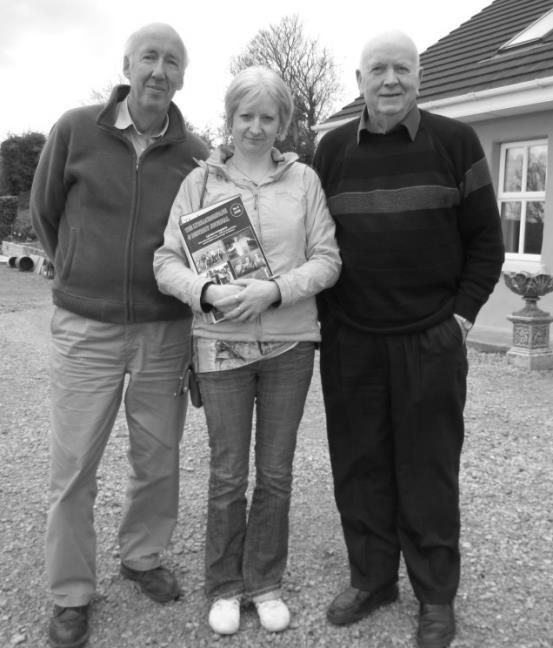
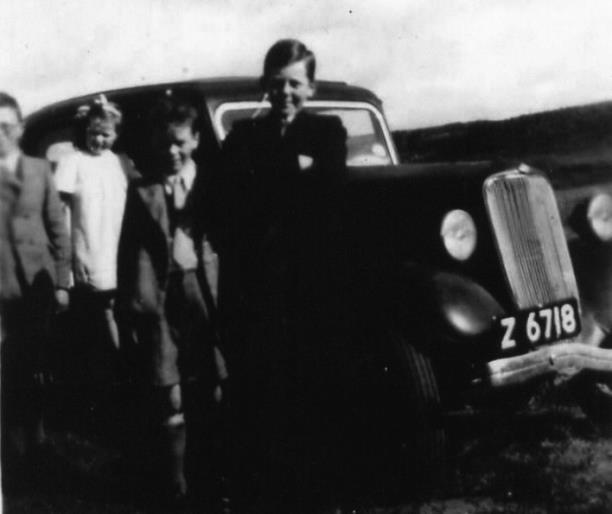
ThiswasaDublinnumberplate. TheletterZ was used in Dublin registered cars from March 1927 to September 1938. Incidentally the following were the letters used in Kerry number plates from 1903 to 1986…

IN1toIN9999 (Dec1903 Jan1954);

ZX1to ZX 9999 (Jan 1954 Jan1962).
AIN1toZIN999 (Jan 1962 Jan1973); AZX 1toYZX 999 (Jan1973 Jun1979).
1INto9999IN (Jun 1979 Jan1982);
1ZXto 9999 ZX (Jan 1982 Jan1986). 1AINto375CIN (Jan Dec1986).
Interestingly it took 51 years to use up the IN 1 to IN 9999 number plates while it took only two and a half years to get through the (reversed)1INto9999INsequence.
Ontheleft;Bordesholm Hometownof Harry Starken.Bordesholmisatown in Schleswig Holstein,Germany inthedistrictRendsburg Eckernförde. Italsowasthe nameofa formerhistoricaldistrictof theKingdomofPrussiaandWeimar Republicfor which itwasthedistrictcapital.It isabout20kilometressouth oftheKielCanal.Ontheright;theBaby Ford. (Phototaken1946/47). Ontheleftandfromtheleft;Gay, Elizabeth, Brian, HarryandMarieStarken onatripto Killarney, June15, 1958. OntherightwithJoeHarringtonisHelgaandGayonavisitto LyreacrompaneinApril2012.(OurthankstoSeanQuinlan, Ballyduff, forpassingonthis articlefortheJournal. Itfirst appearedinaNewYork book, Kerrymenin1981)
Dan Paddy Andy O’Sullivan was probably the best known matchmaker who ever graced the Kerry scene. He was responsible for over four hundred marriages and of these it is reported that only one was a failure and this was due to the fact that the female of this unfortunate liaison was incapable of any sort of comprehensive sexual confed eracy with her partner because of excessive religious commitment and a variety of taboos. Still, three hundred and ninety nine out of four hundred was pretty good going by any standard. Dan Paddy Andy resided in Lyreacrom pane, which is in the heart of the Stacks Mountains in North Kerry and where the spoken language is still as colourful as the whins and rich purple heather which dominate the scene.
He was a mighty wit was Dan Paddy Andy and it is for his humour and repartee that he will probably be best remembered. When Dan died he was almost totally blind and for many years up to his death he suffered from failing sight. He was in receipt of the blind pension for several years and there were some envious people in his locality who would write anonymous letters to the pension’s officer suggesting that Dan Paddy Andy wasn’t blind at all. Naturally the pension’s officer would be forced to investigate these complaints. The truth was that at the time, Dan’s sight was mixed. In other words there were times he could see and times when he couldnotsee.
One day he happened to be in a cinema in Tralee watching a matinee of the Sign of the Cross when the pension’s officer walked in and sat down beside him. No word was passed between the pair for a long period. Finally Dan spoke “Excuse me sir,” said he, “will we be landing soon?” “Landing where?” asked the pension officer. “Isn’t this the bus for Castleisland?” Dan said.
There was another time when two American priests came home on holiday to the nearby parish of Duagh. Both were monsignors but they discarded the formal purple and black after a few days in the neighbourhood. Then one day they decided to go fowling. They spent the first half of the day scouring the hills and bog lands of the lower Stacks, but after lunch they struck out for Lyreacrompane and for the abode of Dan Paddy Andy who was reputed to be a very knowledgeable man when it came to the locating of game.
“If there is a pheasant in the mountain,” said a local publican to the pair of clerics when they called for a snorter before lunch, “you may be sure that Dan Paddy will put his paw down on him" or if there is a grouse in the heather ’tis Dan will have his correct address.”
The two priests set out and in due course they arrived at Dan Paddy Andy’s. Dan was sitting by the fire when they entered and although they were dressed in the apparel of fowlers he immediately knew who they were for it was common knowledge that they were in the neighbourhood. Dan was no great lover of the clergy and his name had been calledfrom thealtar morethan once. He had a small dance hall which he opened when other ballrooms were closed during the Lenten period and on Christmas night. Much to the chagrin of some priests, the ballroom attracted large enough crowds so that there was no love between
themselves and Dan. “Could you tell us," said one of the clerics, “where we would find some game around here?” “Game” said Dan and he pondered for a moment. “Game” he said again and he addressed his visitors. “You will go back the way you came” said he “and you will take the first turning on your right. Then you will take the next tum to the right until you come to a bridge who has a hump on the back. After the bridge you will come to a cottage. There is a brace of widows in residence there and if ’tis game you’re after, you’re at the right abode for by all accounts they’re game to the tail.”
Dan’s dancehall is closed now but on one occasion he madea memorable speech when it was brought to his attention that certain ladies were misbehaving. “It has come to my attention” said he “that townie pullets are flying their kites. If they get caught in the chimney, me nor mine will not be to blame.” Dan also frowned on young gentlemen who stamped on the floor during reels and sets. Low shoes were worn by few and strong boots, often hobnailed, were the order of the day. Consequently there was a solitary notice tacked on to the wall immediately inside the door. All it said was: “No Pounding”. Admission was four pence, strange music sixpence and for this you could dance from dusk till the break ofday.
For the benefit of readers, I had better explain about strange music and why the price of admission was raised from four pence to sixpence which was somewhat of an exorbitant price in those distant days when you could buy a packet of cigarettes for tuppence or a half dozen fresh eggs for a threepenny bit. Local music consisted of two or three musicians with a melodeon or a concertina and sometimes a fiddle. Rarely was
there a drum. Strange music on the other hand meant an established band from one of the nearby towns of Tralee, Listowel, Castleisland or Abbeyfeale. These bands invariably had a saxophone, an accordion, a banjo and a drum with one of the four members acting as a vocalist as well. The musicians had to be paid and a car had to be hired to transport them back and forth. As a result the admission charge had to be raised. Strange music then was a luxury and then as now luxuriescostextra.
As a gorsoon I knew Dan Paddy Andy O’Sullivan quite well. The house where I was in the habit of spending my youthful summers was less than a half mile from Renagowan where stood the famous dancehall and Dan’s own abode was just a short way up the road from the hall. On Monday mornings I would give him a hand cleaning out the hall. The work was nearly always interrupted by the arrivalof aman or womanwho would be seeking Dan’s services as a matchmaker. The exchanges that followed were alwayswellworth listeningto.
I well remember one morning after an Easter Sunday night dance to be sitting on the hedge which partly surrounded the hall. It was about twelve o’clock in the day and Dan Paddy was relaxing. He had been reminiscing about his forebears who hailed from Cork and he was full of praise for the Cork people who, according to Dan, were alright as soon as you got to know them. While he was talking, a hackney car pulled up and the driver hailed us through the open window. “Where abouts here?” said he “does Dan Paddy Andy live?” There was a well dressed lady in the back seat of the car who was to say but she might be a pension’s officer. “State your business like a good man,” Dan said. “Tis this lady here,” said the driver and he opened the door
of the car. Out stepped a middle aged' woman with a handbag under her arm and a determined look on her face. “A fine brave damsel,” said Dan under his breath, “and firm as the Rocks of Bawn.” “I am looking for 'Dan Paddy Andy O’Sullivan,” said she. “Your travels are over,” Dan informed her, “for I’m the man in question.”
The woman explained she was a widow and had been for several years, but now she wasfindingthe nightslong and lonely as she had no family and she would really appreciate an honest hard working man. A man with a good head on his shoulders, not afraid of a day’s work and attentive to his religious duties. She told Dan that she wasn’t anxious for a man as such and that she wasn’t romantically inclined,butbeing a widow she had been used all her life to companionship before her husband died and was anxious to settle again. “Tis not agin you to be a widow,” Dan told her “A widow knows the course and a widow won’t fall at the first fence like a flighty young thing. Would you like this man to be baldy or curly?” “I’m aisy one way or the other,” the woman told him, “as long as he’s gentle andaisy going.”
Here Dan took a long, hard look through his powerful spectacles and I could see that he was impressed by the answers of his lonely client. Dan was inclined to dismiss pernickety and smart alecky people outright and to tell them that they weren’t cut out for marriage at all. I often heard him say that he wouldn’t inflict a poisonous, cantankerous or contentious candidate on anyone, for said Dan: “I will have to answer one day to my maker and I wouldn’t like to state that I ever took money under false pretences.” He addressed himself to the widow once more. “And what about his
grinders?" Dan asked. The woman shook her head and looked at me in some bewilderment for clarification. “His grinders is his teeth,” Dan explained. “Now do you want him with natural grinders, do you want, him with false grinders or would you be put out if he had no grinders at all? Men with no grinders,” Dan told her, “eat like ducks and would deafen you during the breakfast, dinner and supper.” “It wouldn’t Worry me one way or the other,” the woman said. “Would you like a man,” said Dan, “what would be given to talk or would you sooner a man what’s inclined to keep his mind to himself?"
“It makes no difference at all to me,” said the woman. There were other questions concerning money and property and Dan’s fee, of course, which was left till last. The fee she regarded as reasonable. “I have the very 'man for you,” said Dan. “Do you know Ballybunion?” “Why wouldn’t I?" said the woman. “Well he lives there with the brother but the brother is bringing in a woman so this man is anxious to make a nest of his own. He’s baldy,” Dan told her, “and he has no teeth and he don’t talk much but a nicer crature you wouldn’t meet if you was to comb the thirty two counties of Ireland.”
The match was made and as far as I know the wedding took place a few months later. They had to be happy. They didn’t expect too much and they took life in their stride. God begood to Dan Paddy Andy O’Sullivan. He brought hope and joy to hundreds and as long as a man or woman wasn’t aiming for the stars he found them partners when all fruit failed. Hewasthe lastrefugeof those who could not make a case for themselves and there’s many a man and woman drinking tea to day that wouldn’t be drinking it at all but for Dan Paddy Andy O’Sullivan the last of the great Irish match makers.

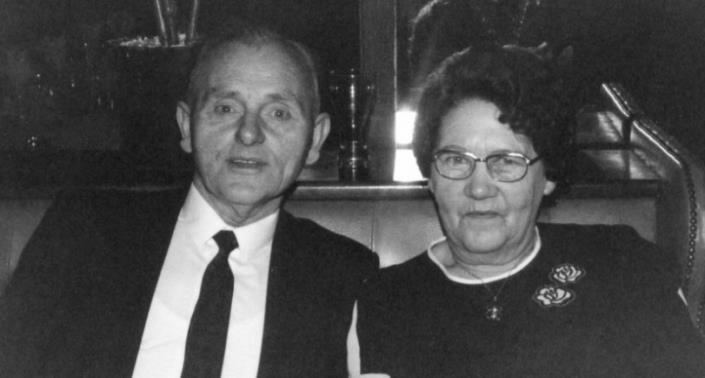
HaveyoubeentoTraleetownalongtheKerry shore,
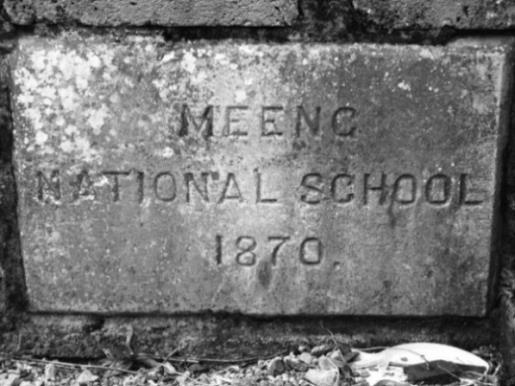
Haveyoubeentherewhentheteamarrive andhearthecrowdroar.
Haveyoueverseenourfieldsofhayalong Listellickhill, OrbeenaskedtodanceinTraleetownand reply ”l will”.
HaveyoubeendowninDennystreettosee whowontheRose, OrplacedabetinBallybeggan;yourhorse beatenbyanose.
Haveyouseenourcolouredhillswhen youfly intoFarranfore, Orhavelobsterinourrestaurants, lickyour plate, thenaskformore.

Haveyoueverseenthechimneytopswhen yourambledownDayPlace, HaveyouevershoppedinTraleetowntobuy thefinestlace
HaveyoubeentoSiamsaTiretostudyartor enjoyaplay, Orhaveyoueversailedfromforeignshores tolandinTraleeBay.
Didyouhaveawalkinourtownpark, takea breathandfeeltheair,
Enjoythemusic, thecoffeeandthepeoplein thesquare.
Haveyoueverseenourtrawlerslandtheir catchonFenitpier, Have you ever stood in The Mall and say I’m finallyhere.
HaveyouseentheSlieveMishMountains watchingoverTraleeTown, Snowcappedinwinterandinspringtime goldenbrown.
HaveyouwalkedinBallyseedyWoods;watch theleavesturninghue, OftheOak, theAsh, thebranchesclashand thebellsofblue.
DidyoueverswimfromLocke’s Strand out to SamphireRock OrtakeawalkbytheCanalasfarasthe Lock.
HaveyoueverseenourChristmaslights downthelengthofCastleStreet, OrwatchthewindmillinBlennervilleturnits wheelsandcrushthewheat
Oh I’ve seen and been manyplaces, mostof highrenown, Fromthegondolasof VenicetoNewYorkand ChinaTown.
So if you’re looking for good humour and goodfriendsallaround, Justpack yourbagswithsilk orragsandvisit TraleeTown.
OntheleftDensieNolan, GlountaneandontherightPaddyandMaryDoran, Carrigcannon.Knockalougha School Photo 1910

Thiswell wornphotoofKnockaloughaNSin 1910 isworthincludingasithasbeen possibletostillidentifysomeofthoseinit. TheteacherswereMrandMrsCasey ontheleftandFrBeasleyisontheright. Inthebackrow3rdfromleftisNSheehy, 4th RCostelloe, 5th JSheehy, 7th JJCroninand9th VRiordan. 1st fromtheleftin thethirdrowisNKeane, 5th Sweeney, 10th Jack Faleywhile1st ontheleftinthe secondrowis Keane, 3rd Keane, 6th JJKelly. 57
 Knockalougha School down the years.
Knockalougha School Photo 1950/51
FrontRow: PatrickKirby, JackCronin, TomLyons, MauriceLong, JimCronin, JimLyons, Mary Hickey,ThomasWalsh. SecondRow: DanHartnett, BobCostello, JimKirby, Danny McElligott, JerLong, TomLong, TeresaWalsh, MaryLong. ThirdRow: Bridie Dowling, Nora Lyons, EilyMaiMurphy, Con O’Keeffe, Mick Kirby, Jeremiah Sheehy, Patrick Dowling, MickCostello, PatrickBuckley. FourthRow:MaryEllenMcElligott, BettyHickey, Lil Lyons, Peg O’Keeffe, CathyMcElligott, JoanHickey. TeacherPadraigKeane
Knockalougha School down the years.
Knockalougha School Photo 1950/51
FrontRow: PatrickKirby, JackCronin, TomLyons, MauriceLong, JimCronin, JimLyons, Mary Hickey,ThomasWalsh. SecondRow: DanHartnett, BobCostello, JimKirby, Danny McElligott, JerLong, TomLong, TeresaWalsh, MaryLong. ThirdRow: Bridie Dowling, Nora Lyons, EilyMaiMurphy, Con O’Keeffe, Mick Kirby, Jeremiah Sheehy, Patrick Dowling, MickCostello, PatrickBuckley. FourthRow:MaryEllenMcElligott, BettyHickey, Lil Lyons, Peg O’Keeffe, CathyMcElligott, JoanHickey. TeacherPadraigKeane
Front; … Murphy, Willie Walsh, Mike and Tom Sheehy, Michael J Cronin, John Sheehy, Con Hickey. Middle; Eva McCarthy, Hannah Walsh, Kitty Lyons, Anne Cronin, Jo Galvin, Mary Ann Murphy, Mary Joy, Cathy Buckley, Rose Galvin. Back row; Jim O’Connor, ...?, Winnie Hickey, Julie Hickey, Peg O’Donoghue, Margaret Dillon, Maisie Cronin and Dora O’Shea.
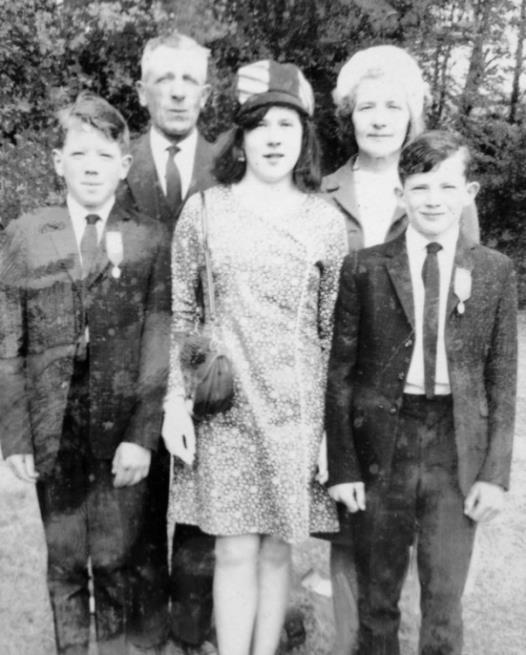
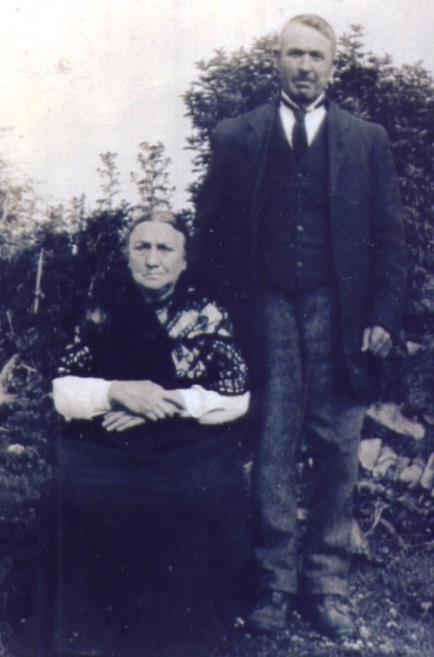



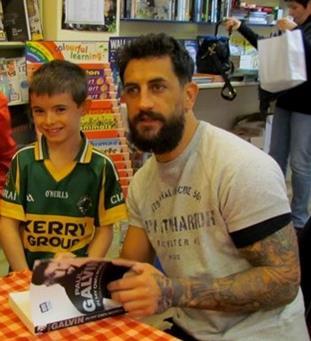
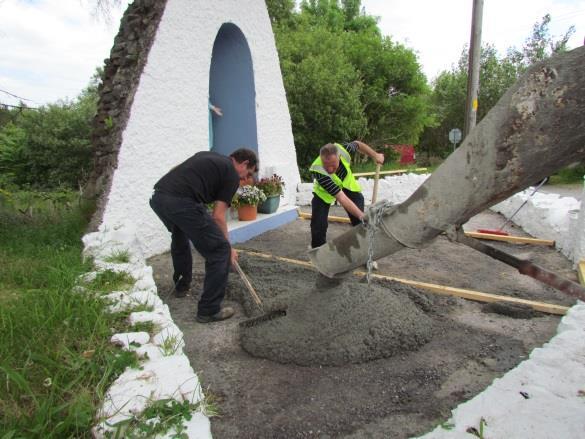





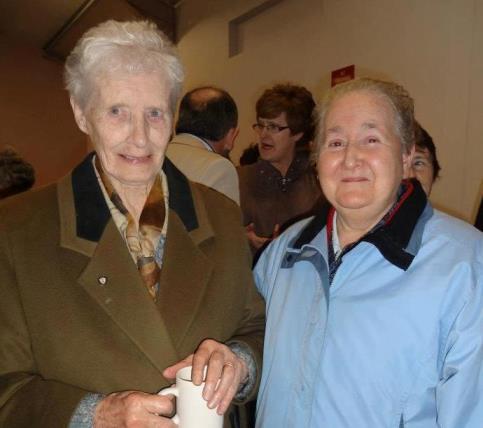 Dancing at The Hooley in the Hills Festival 2013
Fr. Brian Starken met Mick Flavin and his Band at the Glen before they played in the Fest Marquee and below on right is Peg (Molyneaux) Cantillon, Listowel and Teresa Long, Lyreacrompane.
Dancing at The Hooley in the Hills Festival 2013
Fr. Brian Starken met Mick Flavin and his Band at the Glen before they played in the Fest Marquee and below on right is Peg (Molyneaux) Cantillon, Listowel and Teresa Long, Lyreacrompane.
The following item from Wikipedia provides some background to the articles to follow on Lucy Anne Thompson which were researched and written by Joe Harrington and Kay O’Leary.
Times produced a number of facsimile letters, allegedly bearing Parnell's signature and in one of the letters Parnell had excused and condoned the murder of T.H. Burke in the Phoenix Park.
The Parnell Commission was a judicial inquiry in the late 1880s into allegations of crimes by Irish parliamentarian Charles Stewart Parnell which resulted in his vindication.
On 6 May 1882 two leading members of the British Government in Ireland, Chief Secretary for Ireland Lord Frederick Cavendish and the Permanent Under Secretary for Ireland T.H. Burke were stabbed to death in Phoenix Park, Dublin by the Irish National Invincibles.
In March 1887, The Times published a series of articles, "Parnellism and Crime", in which Home Rule League leaders were accused of being involved in murder and outrage during the land war. The
In particular the news paper had paid £1,780 for a letter supposedly written by Parnell to Patrick Egan, a Fenian activist, that included: "Though I regret the accident of Lord F Cavendish's death I cannot refuse to admit that Burke got no more than his deserts" and was signed "Yours very truly, Charles S. Parnell". On the day it was published (18 April 1887), Parnell described the letter in the House of Commons as "a villainous and barefaced forgery."
Also on 18 April the Perpetual Crimes Act had its second reading and debate in the Commons. It appeared to nationalists that it was more than coincidental that the Times article and the letter were published on the same day, and was obviously intended to sway the debate.
After considerable argu ment, the government eventually set up a Special Commission to investigate the charges made against Parnell and the Home Rule party. The commission sat for 128 days between September 1888 and November 1889.
In February 1889, one of the witnesses, Richard Piggott, admitted to having forged the letters;

he then fled to Madrid, where he shot himself. Parnell's name was fully cleared and The Times paid a large sum of money by way of compensation after Parnell brought a libel action. His principal lawyer was Charles Russell, who was later created Lord Killowen. Russell also wrote an influential book about the case.
In an out of court settlement Parnell accepted £5,000 in damages. While this was less than the £100,000 he sought, the legal costs for The Times brought its overall costs to £200,000. When Parnell re entered parliament after he was vindicated, he received a standing ovation from MPs
The Commission did not limit itself to the forgeries, but also examined at length surrounding circum stances and in particular the violent aspects of the Land War and the Plan of Campaign. In July 1889 the Irish Nationalist MPs and their lawyers withdrew, satisfied with the main result.
When it eventually published its 35 volumes of evidence it satisfied for the most part the pro and anti nationalist camps in Ireland: Nationalists were pleased that Parnell had been heroically vindicated, while Unionists pointed to a mass of sworn evidence that suggested that some of his MPs had condoned or advocated violence, in such a way that murders were inevitable.
The 1880s were turbulent times in Ireland, in Kerry and, no less, in Lyreacrompane. In an earlier Journal Kay O’Leary wrote about evictions pointing out that in 1877 the number of families evictedin Kerry was 18. In 1881 the number was 192. In 1883 it was up to 403 and it climbed the following year to 410. In 1881 the agent for the Lyreacrompane Landlord John Hurly was Lucy Anne Thompson and while, in some years, Kerry evictions totalled more than the rest of the counties combined Lyreacrompane headed the listintheKingdom!
The Hurly Estate, which included the greater part of the Lyreacrompane district, was managed from Fenit House (which is now in the hands of the Byrne family who also own the Brandon Hotel). John Hurly, the Landlord of Lyreacrompane diedin1878. Thelandshad been bought from the previous landlords, the Lockes of Norbury, in the late 1850s. Back then the takeover of the estate by the Hurlys was a disaster for the existing tenants as the new landlord doubled their rent and gave them a 21 year lease which ran out in 1880 justontheeveof theLandBill.
At this stage John Hurley had died and he had willed thathisEstatewouldberun by his agent, Lucy Ann Thompson. Miss Thompson also had duties of care to Hurly’s widow who appears
to have been in bad health andtothechildren.
In relation to her duties as agent for the Estate Lucy Ann got down to business with vigour. At the time landlords were, in some cases, voluntarily reducing rentsbecauseofthedifficult economic situation and on the Hurly Estate there was an expectation that their excessively high rents would be reduced. Instead she had many of them under eviction notice before the leases ended and she was refusing to renew leases unless tenants paid up to, in some cases, a 50%increaseinrent.
Then Miss Thompson appeared as a witness at the Parnell Commission in the latter half of the 1880s the representatives of the Land League had the following examples of her modus operandi available for her cross examination from the pages of the Kerry Sentinel of August 18, 1886.
Mrs Quille was one of these tenants. She is at present living in a hut erected for herbytheLandLeague.Her husband, Patrick Quille, has gonetoAmerica. Underthe Locke management the rent was £21. In 1859 Hurly raised this to £43 and in 1880, when the lease expired Miss Thompson demanded an increase of £10. The Quills were unable to pay and are still outofpossession.
InthecaseofDenisScanlon the figures went from £8.5s under the Lockes to £20 under Hurly and Lucy Ann wantedafurther£5in
1882.InthecaseofPatand Michael Aherne the rent under the Lady Locke was £13 10s, was driven up to £38 when Hurly came on the scene and Lucy Ann demanded a further increaseof£10.
Other documentation shows that Michael Doran, Carrigcannon, held 160 acres jointly with his father mainly of ’wild’ mountain. In 1881 the rent was raised from £40to £50. Theytried to pay the rent in the usual way by way of a bank loan until they were pauperised. Their case went to the Land Court where the rent was fixed at £30. Miss Thompson served notice to appeal.
Mathew Doran from Lyreacrompane held 120 acres, mainly of bog and mountain, under a lease since the Famine, which expiredinMarch 1880. The rent under the lease was £42. When the lease expired Miss Thompson came out to Lyreacrompane and induced Mathew Doran and other tenants to sign a caretaker’s agreement. At the time they were not aware of the consequences ofsigningthisdocument.
In February 1881she asked Mathew to go to the office inTraleeandhewouldgeta “fair settlement”. Instead she slapped on an £8 increase which he refused topay.Twomonthslaterhe was served with a ‘writ of ejectment’ and the Sheriff and bailiffs and about 50 police came out to evict. He had 11 in family and no place elseto gain shelter so he was forced to accept the termsofLucyAnn.
How did Lucy Ann Thompson carry on in such a brutal fashion and live to tell the tale? She was increasing rents in the face of the rise of the Land League and in a situation where many other landlords were being forced to agree to reductions? The Kerry Sentinel newspaper of October 19, 1886 offers someclues.
We have before in these columns given some idea of the harshness of the evictions that were carried out under her regime in Lyreacrompane and in Lahern. Intheformerplace some twenty tenants are evicted these past four or five years because in the years 1879 and ’80 they refused to submit to an increase of rent and had even the hardihood in some cases to demand a small reduction.
Today in Lyreacrompane there are six protection posts withpoliceinthemon the stretch of moorland from whence the unfortunate tenantry have been turned out. English gentlemen who have visited theseevictionscenesonthe Hurly property andseenthe homeless children in the cabins where they are cribbed and then watched the shapely policemen shooting past on bicycles and subsequently noticed the reverential awe of our authorities here before her Fenit Majesty have carried away with them something like an appreciation of the system of mismanagement and misgovernment prevalent in Ireland, especially in our devoted kingdomofKerry.
Back at Fenit House there was a police depot where the police present seemed to beatthebeckandcallof Miss Thompson if not under her personal command. It wasnowonderthatshewas able to continue her evictions with the armed power of the state at her back. She had Lyrea crompane under what was in effect a military curfew duringthe1880s.
TheNewZealandGreyRiver Argus newspaper edition of Feb 11, 1887 pointed out that the two chief landlords in KerrywereLordKenmare and Miss Lucy Anne Thompson “who is styled as the Joan of Arc of Irish Landlordism”. The report went on; Lord Kenmare costs the country £3,800 a yearinpoliceprotectionand Lucy Anne costs £1,600 a year. The beautiful and accomplished Miss Thomp son has tenants on one of her properties evicted and living in Land League huts ontheroadside.
She said to one of them lately in conversation; “I suppose you’ll never be content till you get whiskey for nothing?” Begora mam”, was the answer. “We’ll want to be paid for smoking tobacco after that”. It is strange to think of the interchange of such small drollery between two people,oneofwhommeans to shoot the other on the first opportunity and the other of whom fully knows his intentions the New Zealandpaperconcluded.
When it came to the Courts Miss Thompson always expected to win. However, ononeoccasionatleastit
didn’t work quite like that. She had a man called Jerry Connor up before the Killarney sitting on one occasion expecting to have him evicted from house and home for no other reason than that he would not undertake to grab the farm of an evictednamesakeand neighbourofhis.
The County Court Judge questioned the fairness of asking a man to do “such a dangerous thing at this present time”. Miss Thompson swore that there was no danger to the man astherewasapolicestation close by but she was heard to say under her breath; “He is going to decide in favour of the Land League. I won’t get justice because I’m a protestant”. She was referring to the fact that, unusually, the judge was a catholic.
The Sentinel at the time stated; “…it is instructive to the public to note how this lady expected a decision in her favour as a matter of course merely because she was Miss Thompson andthe Government is on her side againstthetenants.
The indignant outburst of wrath from this poor persecuted Protestant lady willbetouchinglyportrayed, no doubt, in those English journals that have been accustomed to reverence her as the Joan of Arc of landlordism and loyalty but there are few who know Kerry, whether they be landlords or tenants or Protestants or Catholics, who will not rate it, at least in their secret souls if they do not openly at the same worth which we attachtoit
(Taken from New Zealand paper 1880s They seem to have originally appeared in the Dublin Freeman)
Ninetenantshavebeenevicted on Miss Thomson's Estate (Lucy Anne Thompson was, in fact, the agent for the Hurly Estate). The Property is situated in one of the wildest and must barren districts in North Kerry. Driving to it from Castleisland I had to pass for miles over bleak and, in their natural state, barren mountains. But the industry of the tenants on all sides is abundantly testifiedto.
Large tracts of mountain pasture have been reclaimed. Side by side with the “prairie "land may be seen large tracts which have been brought into a fair state of cultivation, a result brought about, I was informed, in almost every case by the industry of the occupying tenants. The first of Miss Thomson's tenants whom I met was John McCarthy. His house on the roadside was locked up, and I was at first inclined to believe that the occupants had been evicted. This proved not to be the case; but McCarthy, whom l found in a neighbouring field, on another man‘s farm where he had obtained permission to put down some potatoes informed me that he was still in possession.
His story, substantially similar to that of the evicted tenants whose holdings I visited subsequently was to the effect that up to two years ago he had held under lease jointly with his brother a farm, for which they paid a rent of £50, the poor law valuation being £22 10s. On the expiration of the lease he was induced to give up possession, and was then put back as a caretaker. Not knowing his legal rights,
he did not make any claim for compensation, but remained in occupation. A rise of rent (to £55) was demanded, and in desperation he agreed to this, although knowing well, he said, that he could not pay it. He signed a document the nature of which he said he knew nothing. His farm was to be sold on the following day by the sheriff at Tralee; but, he added, he would not go near thesale.
Further on I came upon the farms of some of the evicted tenants. Two tenants had been evicted the day before my arrival Patrick Ahern and Michael Ahern. Their cases, I was informed differed little from that of McCarthy. Their leases had expired; they had been put in as caretakers and an increased rent had been demanded. Both had large families of young children dependent on them; six in one caseandeightintheother.
The evictions were carried out by Mr. Hartnett, the Sub Sheriff of Kerry about five o’clock the previous evening. The unfortunate people had beenshelteredduringthenight in the houses of neighbouring farmers, and Land League wooden houses, similar to those already erected in different parts of Mayo. Clare, and Limerick, are in course of erection. One was nearly completed, and two others were being put up. The first is intended for the accommodation of Scanlan, a tenant who was evicted in January last.
Close to the farms of the Aherns I met a representative of the local branch of the Ladies' Land League. She had come a distance of six or eight miles to "cheer up the people; to take particulars of their cases,inordertoforwardthem to Dublin and to assure them that the necessary assistance would be forthcoming". The evicted tenants on Miss Thomson'sestatearePatrick
Quill whose rent, at one time only £l0 12s 6d, was under the lastlease£43,theGovernment valuation being £20. The increase demanded on the expiration of the lease was £10. John Ahern, former rent £17 10s; present rent £38; Government valuation £15 15s, attempted increase £12. Michael Moloney, present rent £33; Government valuation £8 5s, attempted increase £16. J. Donoghue, former rent £10: present rent £21; Government valuation £9 10s. Patrick Ahern, former rent £6 15s, present rent £19; Government valuation £8. Michael Ahern, former rent £6 l5s; present rent £l9, Government valuation £8, attempted increase £10. Denis Scanlan, present rent £20; Government valuation £8 10s. Several of the other tenants on the estate are in hourly expectationofeviction.
There is an impression amongst the better informed classes in the district that the action of Miss Thomson is largely due to want of proper information as to the actual condition of the tenantry and their ability to pay the exorbitantdemandedofthem.
The facts are, as I was informed, that the recent bad seasons have left them in it state of extreme poverty. They depend chiefly on pasture, and they have had to sell their stock in order to stave off eviction. They have every appearance of being industrious and thrifty; they are simple, ingenuous people, whose wants are few and to whom the best testimony that can be borne is that they were able in the past to live upon such land and to pay the rent for it. They would, there is every reason to believe, have continued to do so but for the attempt to increase their rents at a time when nearly all other landlords were making reductions; and it is not to be wondered at, therefore, that they should regard their case asoneofexceptionalhardship.
They were talking about the Lyre Evictions in New Zealand!
(Based on newspaper reports of December 1888). The article below recounts testimony she gave at the Commission in London over two days. Further research is needed to clarify if this testimony was given on consecutive days or if she gave evidence on other days.
Some delay occurred in finding Miss Lucy Thompson. At length that lady was found and led in by the usher with a grace worthy of Malvolio to the box. (Malvolio is the steward of Olivia's household in William Shakespeare'scomedy,Twelfth Night). Miss Thompson was fashionably dressed for a lady that has seen a half century of summers, was one of the most self possessed witnesses possible. She was examined by Sir Henry James and was quick and clear in her answers. It is seldom that a lady occupies the position of Land Agent but that is Miss Thompson’s calling and she runs Sam Hussy close in the area over which she rules in the kingdom of Kerry. This lady has not allowed any softness to enter into her dealings with the tenants but has managed the estate with an attention to detail that would do credit to the best man of business. Miss Thompson’s escort is usually two and sometimes four policemen and her residence she described as the police barrack forthedistrict.
One of Miss Thompson’s little anecdotes that she saw a man with a tight pair of new boots walking down the street in Tralee and enter the Kerry Sentinel office preparatory to a visit to the rent office lower down the street and that when he emerged he had divested himself of the new boots and
put on an old pair. Outrages, Miss Thompson said, had been perpetrated upon her, from an attempt to upset her on her sidecar to someone standing on her foot. She had not finished her cross examination when the clock struck four and the judge hurried off and left herstandinginthe box until Mr Ronan escorted her to the corridor outside…….
……..Mrs Lucy Thompson, Tralee, the landed proprietress under cross examination when the court rose on Tuesday evening again entered the witness box and was cross examined by Sir Charles Russell. She said that since the Land League agitation commenced she had all her legal processes processed by what is called ‘Dublin writ’ mainly because certain formal proofs of facts could be made before the superior courts by affidavits instead of by the attendance of witnesses at the inferior courts. Her main, indeed her sole, object in this was the protection of ‘smaller people’ such as bailiffs who would have had to act as witnesses. She had not adopted the process before the superior courts in order to punish the agitators by reason of its greater costliness. In fact by dispensing with the attendance of witnesses the costs were kept down to about the same amount as before. The writs were for both ejectment and recovery of rent. In addition to the 13 cases of which she had spoken there were a number of other proceedings which did not resultinactual evictions.
The cross examination went on… She could not tell how many proceedings she had taken since 1880. Sir Charles RussellQC; Therehavebeena great many? Lucy Ann Thompson; Yes. Do you consider yourself a good landlord? Yes. Humane? Yes. Merciful to your tenants? Yes. Taking a kindly interest in their well being. Yes. Whatwas
your first disagreement with them? It was over those leases that were out. And resistance on the part of the tenantry to the increase in rent? No, I explained that it was not rent. At any rate it was over an addition to their yearly payments to you? Yes, the repayment of the debt that they had come to me and asked me to incur for their benefit.
What was the total number of holdings over which the expenditure of £2,000 was to be recouped? I think about 30. And what was their rental apart from the payment in respect of the loan? About £600 but I cannot be certain. Was an abatementof their rent demanded by them or the other tenants? They asked me for an abatement of rent in 1880 or ’81. Now, as regards those evicted tenants, would you, at this moment, be willing, upon the terms of having a fair rent, be willing to reinstate them? No, not in the ordinary sense; they sent their priest to me about a month ago and I told him that if they bought on fair terms they might have the land.
Sir Charles continued… You know that eviction is the thing, aboveall others, which an Irish farmer dreads? Miss Thompson; It depends on the circumstances. Did you make any abatement of rent until the tenants went to the Land Court? No. Your impression was that the rents were perfectly fair rents? That was my belief. You look upon the land court as an abomination? I think it is unfair in a great number of cases. And that the tenants are perfectly able to defend themselves? Perfectly And to make perfectly free bargains? Yes. That in many cases you think they are paying too little rent under the Land Court? In many cases. And that they were much better off when the old high pressure rents were kept up? I think they were all much better off before the agitation.
Sir Charles Russell then drew theattentionof MissThompson to some of the reductions of rent made upon her property by the Land Court. He read out a list of these. They included reductions from £37 to £27, from £147 to £100 and from £35 to £18.10s. With regard to the last one mentioned by him Lucy Ann was quick to point out that she had appealed it and the rent was fixed at £22.10s instead of the £18.10sby theLandCourt.
Sir Charles continued; You are rather fond of appeals? Miss Thompson; Yes. You had an appeal with a tenant named Dilane and you lost it? Yes. What chance would he have had if it had not been for the Land League? There would have been no fight had it not been for the League. Exactly; and he would not have had his rights established? It was no rent question at all. It was a question of £50 a year. And the costs were how many hundred pounds? Six or seven hundred. And you had to pay onbothsides? Yes.
Russell then asked Miss Thompsonifsheknewthe total rental of the estate when Hurly bought it from Lady Locke in 1857. She didn’t know but she said she thought he had bought one estate for £26,000 and paid £14,000 for another. What was the total Rental in 1878? I’m afraid I could not tell you. How much has the total rental been reduced under the Land Court? I think 28 per cent. Isn’t it a little more? I cannot tell you positively. Isn’t it in some cases as much as 50 per cent and in the average within a fraction of 28 per cent? I think there were none as large as 50 per cent.
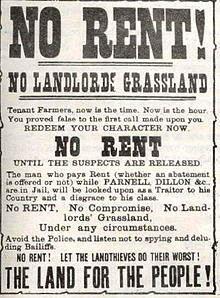
Sir Charles; Let me finally ask you this. You suffered annoyance in the way you told us. Some people refused to work for you and you could not get a threshing machine? Yes. When they refused you
employed Emergency men. Yes. I think the first I employed was in 1881. The Land Corporation took the 3,000 acres in June 1883. You told Sir James that your troubles began in 1879 and grew worse in ’80 and ’81? It did not begin then in any serious way only in civility and change in the manner of the people. Their manner was not so civil to you and what was that owing to? I think it was just the spirit of the time. That was before the Land League was established here? It might not have been established but it was certainly growing. You know as a fact that it was not established when your troubles began. No. I do not that it was.
Mr Lockwood QC asked Miss Thompson; May I take it that from first to last you have made no abatement of rent? No. In one or two instances where there had been loss on cattle and where there was a reason for giving time I granted time and several tenantswereinarrearsfor that reason.
In response to questions from Sir Henry James QC Miss Thompson explained that she undertook the guardianship of the late John Hurly’s children because Mrs Hurly was a confirmed invalid and in all that she had done she had acted in the interests of the children. None of the money had gone into her own pocket. On the contrary, she had suffered loss in consequence she claimed and whatever she had done in relation to the rentshadnotbeenforherself.
She went on to explain that Mr Hurley bought the estate in 1857 and rents were paid instead of grazing rates. “The arrangement for the expenditure of money was made as far back as 1874 or 1875. They refused at first to pay the previous”, she claimed. (This seems to refer to a loan made by Miss Thompson to
tenants to improve roads but it is not clear is this the case and more research on this is needed.)
Lucy Anne went on; “Then they refused to pay any rent at all. They said the time for paying rent was over. They paid no rent or taxes from 1881 to 1883 and then the Land Corporation took position. Jeremiah Connor owed two gales of rent and I evicted him as I saw no prospect of getting the rent for the children for whom I was acting as guardian ifheremained in position.”
Sir Henry James; Have your answers been directed to the property belonging to yourself or only to the trusteeship? Lucy Anne Thompson; The trustees… In the case of the evicted families there was a refusal to pay any rent at all. At the time if they would have paid a fair rent would you have kept them on? Except in a few instances, the tenants were able to pay rent and in these circumstances I allowed them time. Did you see a marked difference in the treatment towards you after the establishment of the Land League? Decidedly. In what way? They spoke much more defiantly and said they would not pay rent. Up to 1879 had you any difficulty getting your rentpaid? No.
It is with deep regret that we have to chronicle the death of Miss Lucy Anne Thompson, daughter of the late Mr. Robert A Thompson, of Sandville, which sad event took place at an early hour of Monday last at the Shelbourne Hotel, Dublin. In 1878 Miss Thompson was made trustee of the Hurly estate in this county and guardian of the minors and in that position was confronted with the machinations of the Land League and afterwards the National League but she was a lady of extraordinary ability, undaunted courage and inflexible resolution and successfully resisted the cowardly attacks and unrelenting persecutions of
those bodies at the same time she was in a marked degree possessed of those womanly graces of kindness and sympathy with those needing help and assistance. Her experiencerelatedbefore the Parnell Commission made a deep impression on the public mind at the time and she was regarded as a heroine as she was for her combatting of those illegal societies. The trying ordeals through which she passed must have affected her otherwise robust health and the end came on Monday, asabovestated.
The remains arrived in Tralee yesterday by the 4.20 train from Dublin and was met by a large concourse of people with every mark of respect and conveyed to the parish church, where they at present lie, the coffin being
covered with many beautiful wreathes and other floral offerings from numerous relatives and friends. A funeral service will be held in the church at 9.15 tomorrow morning, after which the remains will be removed by the G.S.& W. Railway Station for conveyance to Killorglin for interment in the old familyvaultatDroumavally.
The State record for Lucy Anne Thompson’s death states she was 48 years old at the time of her death and she was a member of the Church of Ireland. Her address is Fenit House, Tralee. She died on 24 March 1892 Evening Post gives 23 March as the date of death!!! Herfather,Robert, diedat57 and her brother Robert Atchesondiedat27years.

ThisDocumentfrom1892showsthatLucyAnneThompson left£1,725.17s10dinherwill.

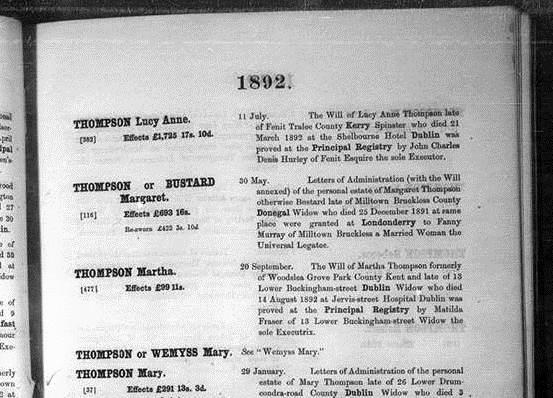 Kay O’Leary just checking that Lucy Anne can’t get out and go back to tormenting thegoodpeopleofLyreacrompane!
Kay O’Leary just checking that Lucy Anne can’t get out and go back to tormenting thegoodpeopleofLyreacrompane!
Aversewrittenby JoeHarringtonin January 2013tocelebratethefamousvictory by Duagh intheNorthKerry Championshipaftera lapseof fifty years.
Stand there ‘till I tell you a tale of true heroes Whocomefromaparishthat wecall ourown Fromthehillsof Glenruddery rightdowntothe lowlands
WheretheFealeglidesonby with itsmurmuring tone
Forfifty longyearswehavewaitedforvictory Toraiseupourflagsandtoshouthiphurragh Forway toomuchwaterhasrun downthe Smearlagh
Butnowwehavereasontocheerfor Duagh.
Ourplanof campaign;itwaseveraclearone SaidthebouldMartin Leanenowthetimeit is right.
As he urged every one of Duagh’s GAA club Tothink oftheMallandtostandupandfight. Our mission was clear then, we’ll take on North Kerry
We’re giving no quarter and we’ll never shirk Andthe manonthefieldwhowillleadusto glory
TheonewecallCaptain,thegreatKieran Quirke.
(Chorus)
We’ll shoulder, we’ll cheer them Fornonecangetnearthem We’ll boast of their deeds And we’ll shout hip hurrah. We’re proud for to know them Andhonour we’ll show them, Thosemenwhobroughtvictory Thechampions, Duagh
Opponentswereplenty,they tumbledbeforeus Thechampionshipfinalwehadinour view Andtherewemetupwiththeladsby the Shannon
TheBealemenwereready todieortodo
Itwasmanagainstman,withnoquartergiven Thestrugglewasdowerandtheoutcomelooked grim
WhenupsteppedAntMaherandnotforthefirst time
Andthedrawthatwasearneddidowemuchto him
In2013onthe6th day ofJanuary, Adatewewill treasureandtalk offoryears
In Listowel’s Sheehy Park, Duagh won the replay Givingevery supportergoodreasonforcheers Thehoodoowasbrokenandthelongwait was over Andthefeatofour heroeswelongwilladmire
Therafterswill ringandthebonfireswill burn Aroundthevalleysandhills fromDuaghupto Lyre (Chorus)
I’ll name you the lads who have brought us such glory
Nan Maher and Kieran we’ve mentioned before IntheredgapofdangerourkeeperJerKelly Hisfeatswill foreverbepartof folklore
The rock John O’Brien with Terry and Aaron Putpaidtofullmany astrongBealeattack TimScanlon andDiarmuidalongwiththeir captain
Completedthelineoutthatguardedtheback. A mention with pride we’ll give to brave Denny AndPeterandMauriceandJoey also While Duffy and Scannell and Nigel O’Connor
Withskillandwithcouragesetall heartsaglow Jason,EdStack,McCarthy andMoran Steppeduptothemark when thechipsthey weredown
Andthesecretwasteamwork,commitment& workrate
Anddeterminationtobringhomethecrown. (Chorus)
Therewasgreatstrengthindepthwiththelikes ofEoin Kelly
JohnSherin, TimQuirkeandthatyoungman, ChrisBreen O’SullivanwassolidandScanlon wasrugged And Johnny O’Connor was tall on the scene.
JohnCurranalong withtheyoungKieranLucey AndthebrothersMcKennawereupforthe fray Intheyearwhenthemighty Duaghwerethe victors
A time we’ll remember for many aday
Our heroes are champions, we’ll never forget them
Themaroonandthegoldnow foreverwillwave Andtheyouthofour parishwill followthe footsteps
They madeontheirway throughthelandofthe brave
Themanagementteamwasabrilliant foundation
ForScanlonandDillonandStack pavedtheway ThenameofJohn Halpinwillproudly be mentioned
Whenwethink ofDuaghandthatmighty display
We’ll shoulder, we’ll cheer them
Fornonecangetnearthem We’ll boast of their deeds And we’ll shout hip hurrah. We’re proud for to know them And honour we’ll show them, Thosemenwhobroughtvictory Thechampions,Duagh
It will be 40 years next October since Tiede Herrema was kidnapped from his home in Castletroy in LimerickinOctober1975. He was the Dutch boss of the Ferenka plant at Annacotty that employed 1,400 at one stage. He was held hostage for 36 days by Eddie Gallagher and Marion Coyle who were demanding the release of three republican prisoners including Eddie’s pregnant girlfriend, Rose Dugdale. After the release of Herrema, following a two week siege in Monesterevin, Gallagher and Coyle were given long jail sentences and in Eddie’s case he became one of the longest serving prisoners in the state. While in Limerick prison he married Rose Dugdale who already had their child, Ruairi, while servinghersentence.
In November 1977 Ferenka closed having lost its competitive edge in the business of making wire for tyre walls. Some workers occupied the factory in an attempt to save the jobs. Those of us involved in the socialist and trade union movement in Limerick gave them as much help as we could and afterwards we published a pamphlet outlining the lessons of the struggle. This pamphlet eventually found its way into Limerick prison and into the hands of Eddie Gallagher. Subsequently he wrote to me about it and occasionally after that until coming up to his release. In the meantime Tiede Herrema had returned to his native Holland and in an interview said that, all things considered, he had been treated well by Eddie while held hostage but that didn’t get Eddie any leeway onhisprisonsentence.
It was now 1990 and Governor Laffin of Limerick prison asked me, as he had doneon acoupleof occasions in relation to other prisoners, if I would keep Eddie company on a couple of day releases in an effort to ease him back into life outside the prison. As we drove and walked around the city Eddie told me of meeting so many young people in jail who had no chance in life but he had a project in mind to help “take young people off the streets”. He hoped to set up an ice rinkwhenreleased.
Then one night I was watching the 9pm news on TV and heard that Eddie Gallagher was to be released the next day. Out of the blue at 11pm I got a call from the Governor asking if I could be outside Limerick Prison at a minute past midnight to “pick up a parcel”. Clearly a move to avoid the paparazzi! I drove down and parked across the road and right on the dot the prison gates opened and out walked Eddie Gallagher after 18 years in jail and hopped into the van. Nothing to do except take him home and put him up for the night. He was heading to Dublin to see his son. While still friendly with Rose Dugdale they were going their separate ways. Next morning it was back in the van and down with Eddie to Limerick train station. On the way to work afterwards I passed Limerick prison where thepressandTVofIreland, if not the world, jostled for position expecting Eddie Gallagher to walk out to freedom!
I met Eddie only a couple of times after that. He had returned to his native Donegal and at that stage he had acceptedthat the ice rink project was not going to happen. He had set up a
small horse trekking centre on some land that he owned. He called when he was down to buy some horses at the fair at Spancilhill. He still asked about the young Limerick people he had met in Limerick Prison and if they had straightened out their lives. As one of those prisoners Eddie Gallagher seemstohavedonejustthat.
It has often been remarked that Lord Kitchener’s success as a soldier was in great measure due to his capacity as a businessman. His father, Major Kitchener, was a soldier too and a business man to boot. It may not be generally known that the father of England’s modern “organiser of victory” went to Kerry in the first place as the practical man of a syndicate formed in England to develop the Irish peat industry on a newplan.
The scheme ended in “smoke”, the gallant Major lost some of his spare cash and at the same time fell in love with the scenic beauty of Kerry. He, accordingly, took up his residence at Gunsboro House and there the future Sidar and his brother passed their early years. A gentleman who is now a magistrate in Listowel remembers the elderly Kitchener as a stern disciplinarian and a driver of hardbargains.
The New Zealand Wanganui Herald of April 25, 1882 reported that it had received news from Ireland that a serious affray has occurred between police and “Moonlight” marauders. A band of 200 Moonlighters were raiding a homestead near Listowel, Co Kerry when they were fired upon by the police. Fifteen of them were wounded and captured.

Among the popular activities at the Lyreacrompane Resource Centre are those laid on for the Over 55 Group. Mary and Mike Mangan told us that this group is on the go for ages. They describe how things kick off every Friday morning with tea and scones and plenty of good conversation. “After the tea well we are spoilt for choice”, said Mary. Some go for a walk around the sports field by the Smearlagh. Themore
energetic can do some exercises or play a game of bowling. Then there is the hairdressing service and the cardgames.
At that stage it is time for a three course lunch and what better than a game of Bingo to round off the afternoon. Then there are the Tea Dances once a in Knocknagoshel, Scartaglin, Castleisland, Currow, and Ballymacelligot and Lyre Our Gala Dinner and Dance is usually in the month of April.
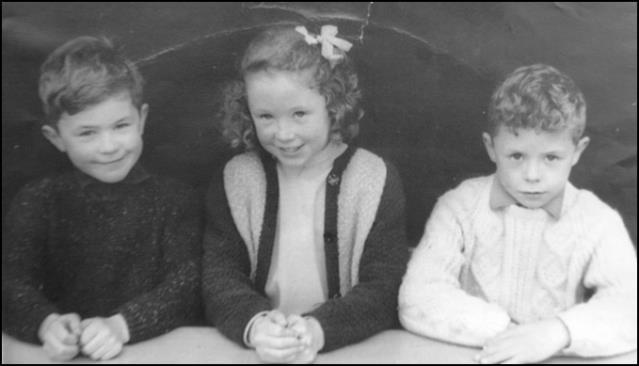
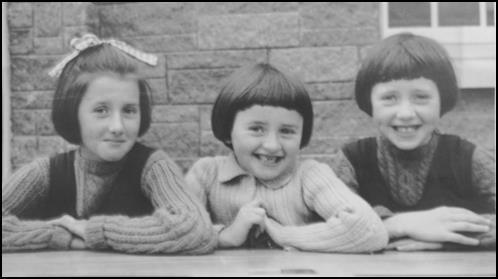

But Mike pointed out that it doesn’t end there! Occasionally there are excursions to places far and near. These have included Donegal and Dingle and thesetripsareajointventure with the other local Over 55 groups. Both Mike and Mary were eager to thank Larry Long and all his staff for their work in making the Over 55s events so varied and interesting for all and look forward to many more pleasant days with the Group.
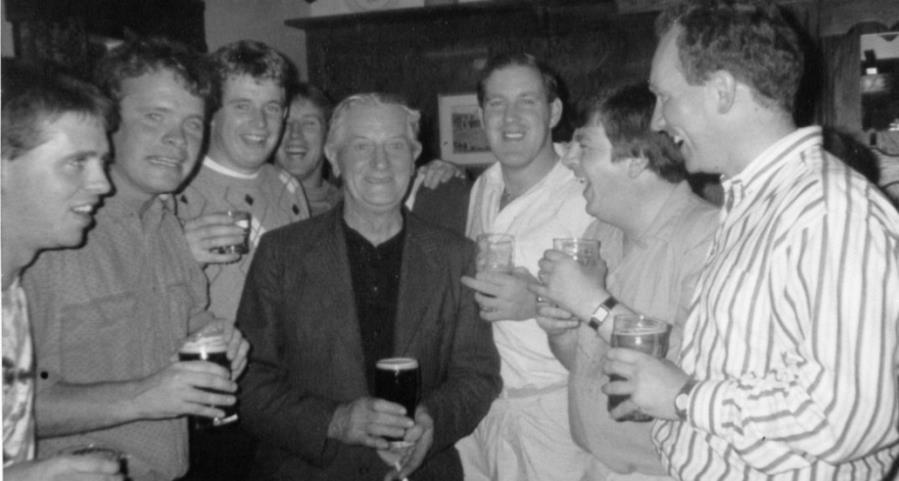 Seán Dillane, Cloghane surrounded at Roches Bar
Dolly and Siobháin Sheehy on the left and Eileen, Maureen and Sheila R.I.P. Dillon on the right
John, Helen and Tom Sheehy on left and Gillian O’Connell, Kay
Naughton and Clare Mangan on right. 71
Seán Dillane, Cloghane surrounded at Roches Bar
Dolly and Siobháin Sheehy on the left and Eileen, Maureen and Sheila R.I.P. Dillon on the right
John, Helen and Tom Sheehy on left and Gillian O’Connell, Kay
Naughton and Clare Mangan on right. 71

We bumped into Paul Kennelly recently at the Paul Galvin book signing in Listowel. The queue was long and we had plenty of time to chat as we waited in line. I reminded Paul of the article he wrote for the Lyre Journal years ago about the times he worked connecting local homes to electricity for the first time. “In those innocent times the people where so impressed that we could bring them light they thought we could do anything including flying planes”, said Paul. “I still think the people I met in Lyre back then were the most decent and generous people I have ever met and they left a lasting impression on me
We asked Paul what had he been doing lately and he told us he had gone to Philadelphia to visit his son Colm last year. “And it was there”, said Paul,
“that I also had another experience that will always stay with me.” He went on to tell us about the Famine Memorial that Colm took him to see on the banks of the Delaware river. “The memorial is on two acres of land and in the centre is a massive brass replica of a famine ship. Your heart would have to be as hard as stone not to be touched. It was the most moving place I have been. The scene so ably depicts the ragger hungry victims of An Górta Mór and flying over it is an Irish Tri colour. Looking up at it fluttering in the gentle Philadelphia breeze I saw it in a different way for the first time, not as a Fine Gael or Fianna Fail flag but as an emblem commemorating those who suffered and died from a hunger that need not have happened”, Paul said. As we moved closer to our football hero Paul pointed out that there was nothing like that memorial in this country and he said that great credit is due to all who built it in that faraway place in Philadelphia, USA.

We met Mary Sheehy at the School Reunion and she told us that when her mother, Hannah Quill, (better known to people as Mrs Sheehy who taught them at Lyre School) finished at the Glen School she went to England to train as a teacher. Sergeant John Quill paid for her training. After finishing college she taught in Leeds for four years before returning home to Lyre. Her father, Tom Quill, had applied for a teaching position in Lyre for her. She began teaching in Lyre in 1920 but she went to the
Ring College in Waterford for many summers to improve her standard of Irish and she took some of her children with her. Mariah Molyneaux hadalsoappliedforthejob in Lyre but as she trained at a protestant training college it was not looked on favourable so she emigrated to her brothers who were priests in Montana USA. Lyre school (the second one) had been built on Quills land (no relation) and Mrs Sheehy’s father got some land from them to build a stable for her horse and trap as that was her means of transport to
and from Lyre School. When she started at Lyre School the greeting she got from then Parish Priest, Fr. Beasley was “Long may you reign”. In 1937 the Sheehy’s built their two story house in Cloghane. They bought their first car in 1953. Hannah had four brothers, John, Denis, ThadyandNedalldied of TB. Her sister Mary emigrated to the States and sister Rita remained in Cloghane. In 1961 the Sheehy family sold their house and farm to the Land Commission
 Gillian and Noel O’Connell
The opening of Lyreacrompane NS in 1963 with teachers Dermot Hannafin, Miss Noland and Ms Behan.
Gillian and Noel O’Connell
The opening of Lyreacrompane NS in 1963 with teachers Dermot Hannafin, Miss Noland and Ms Behan.




 JPCarey Dublin, MaryLynchTralee, BertieCareyDublin, NorahDoranTralee
Fr.TimGrantand hisMom,Mary.Ontheright sisters Anne Brosnan and Mary Majella O’Connor
JPCarey Dublin, MaryLynchTralee, BertieCareyDublin, NorahDoranTralee
Fr.TimGrantand hisMom,Mary.Ontheright sisters Anne Brosnan and Mary Majella O’Connor


